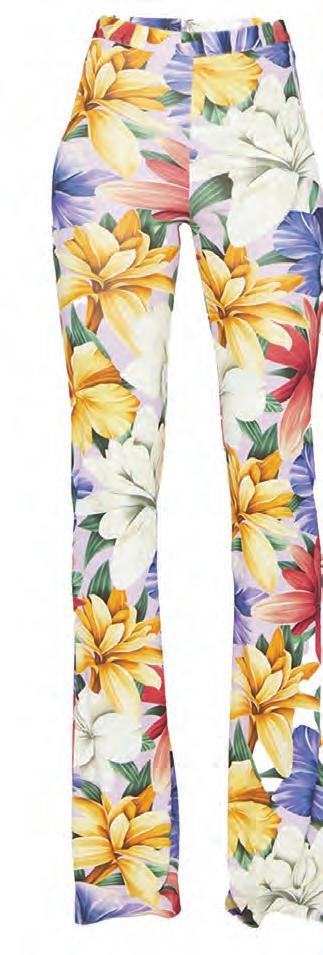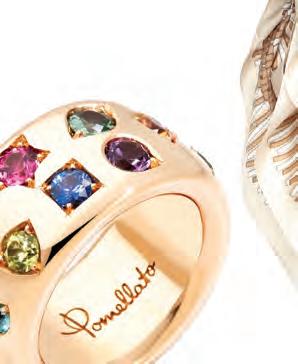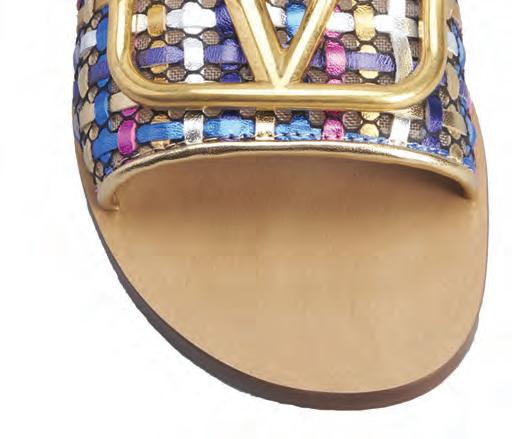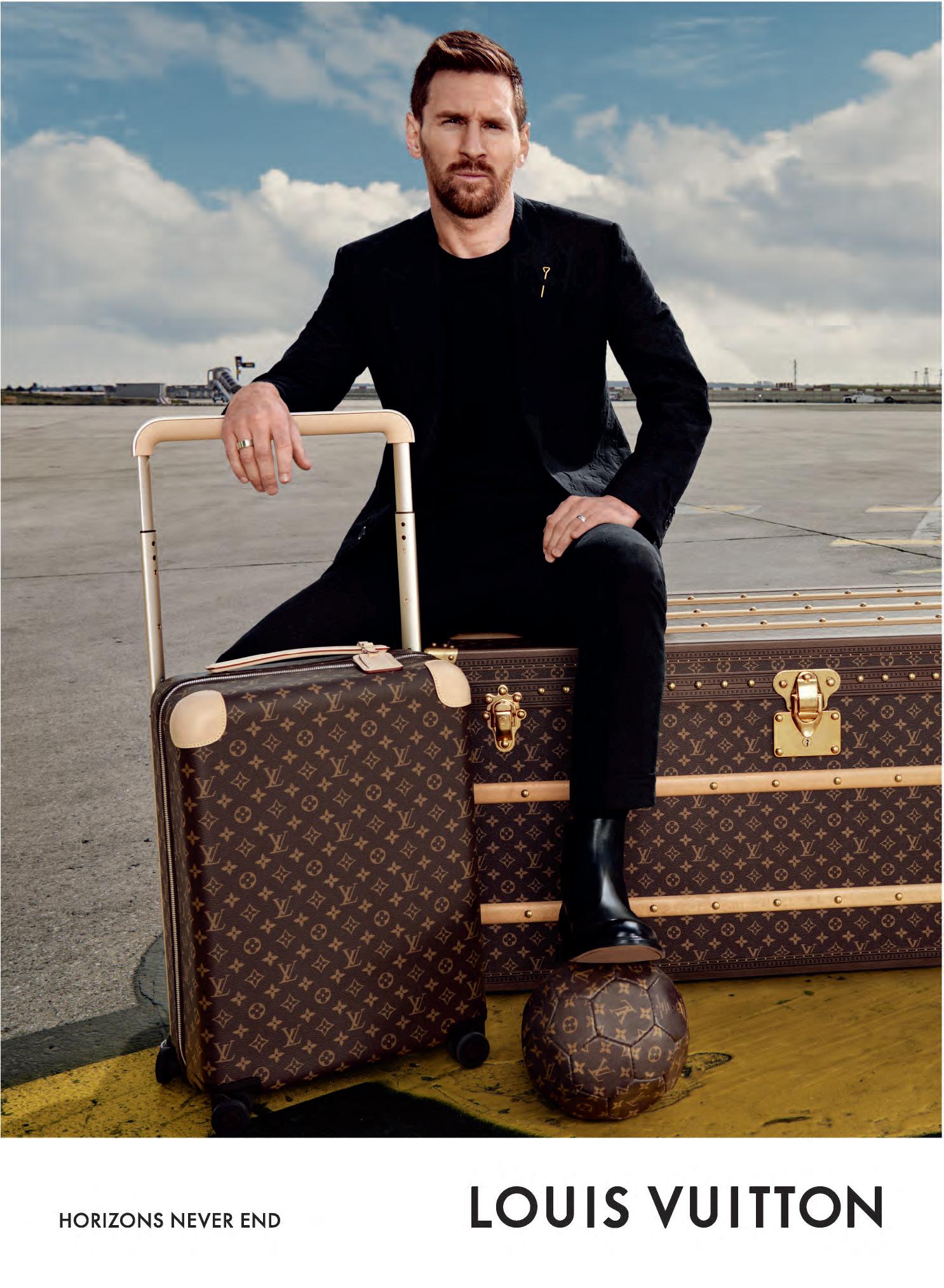MIKE AMIRI

RULES ON RODEO DRIVE
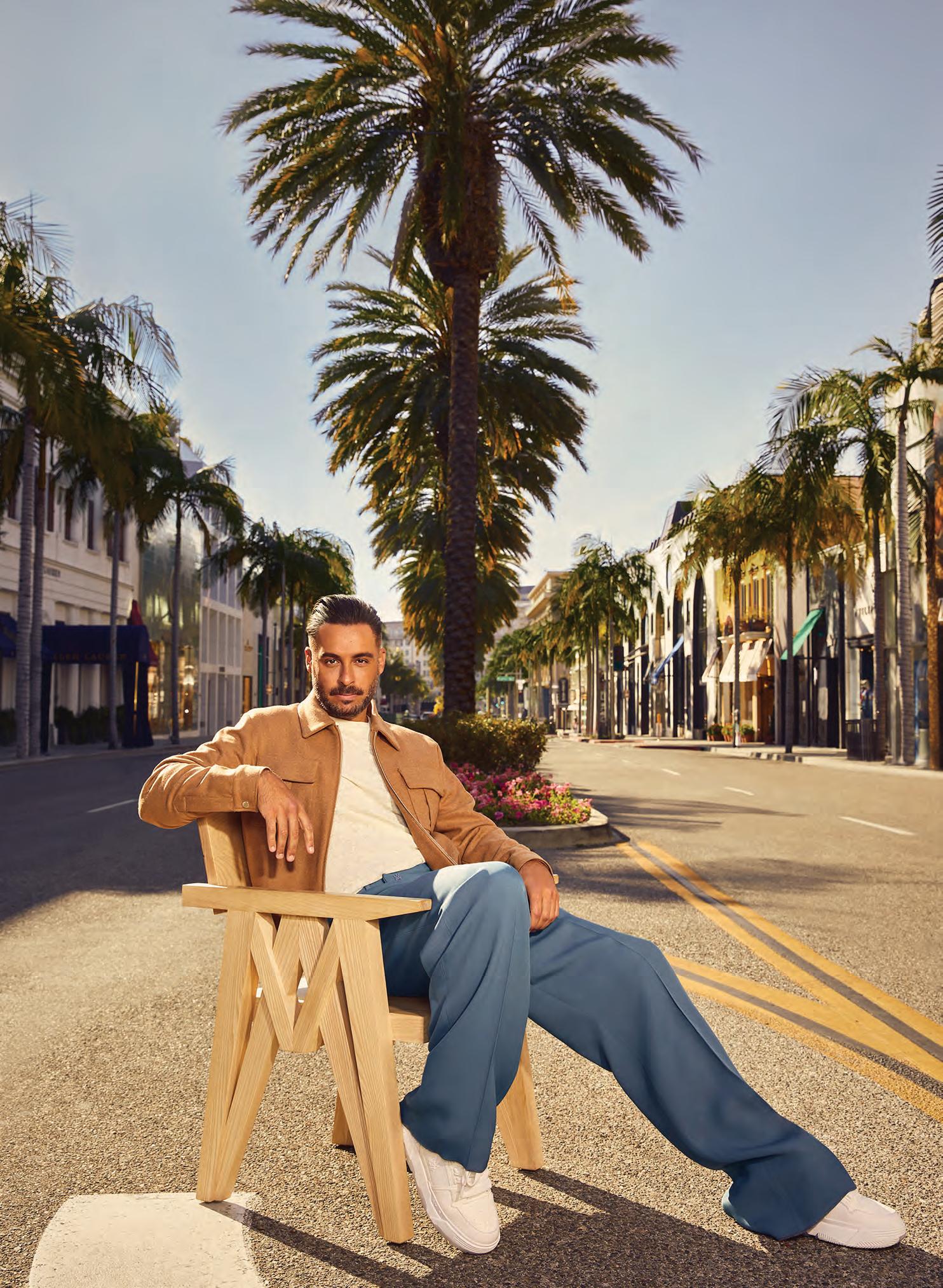

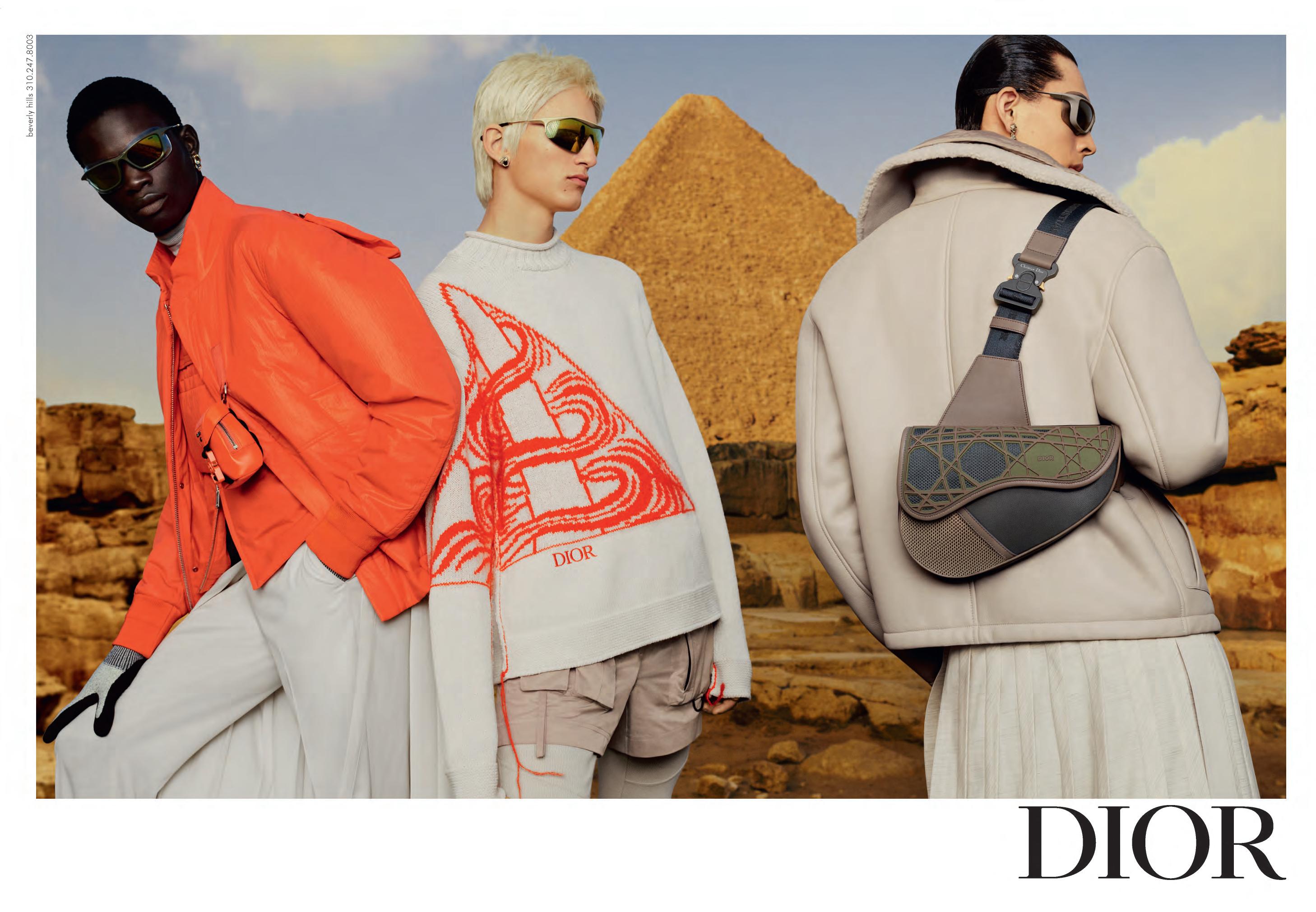

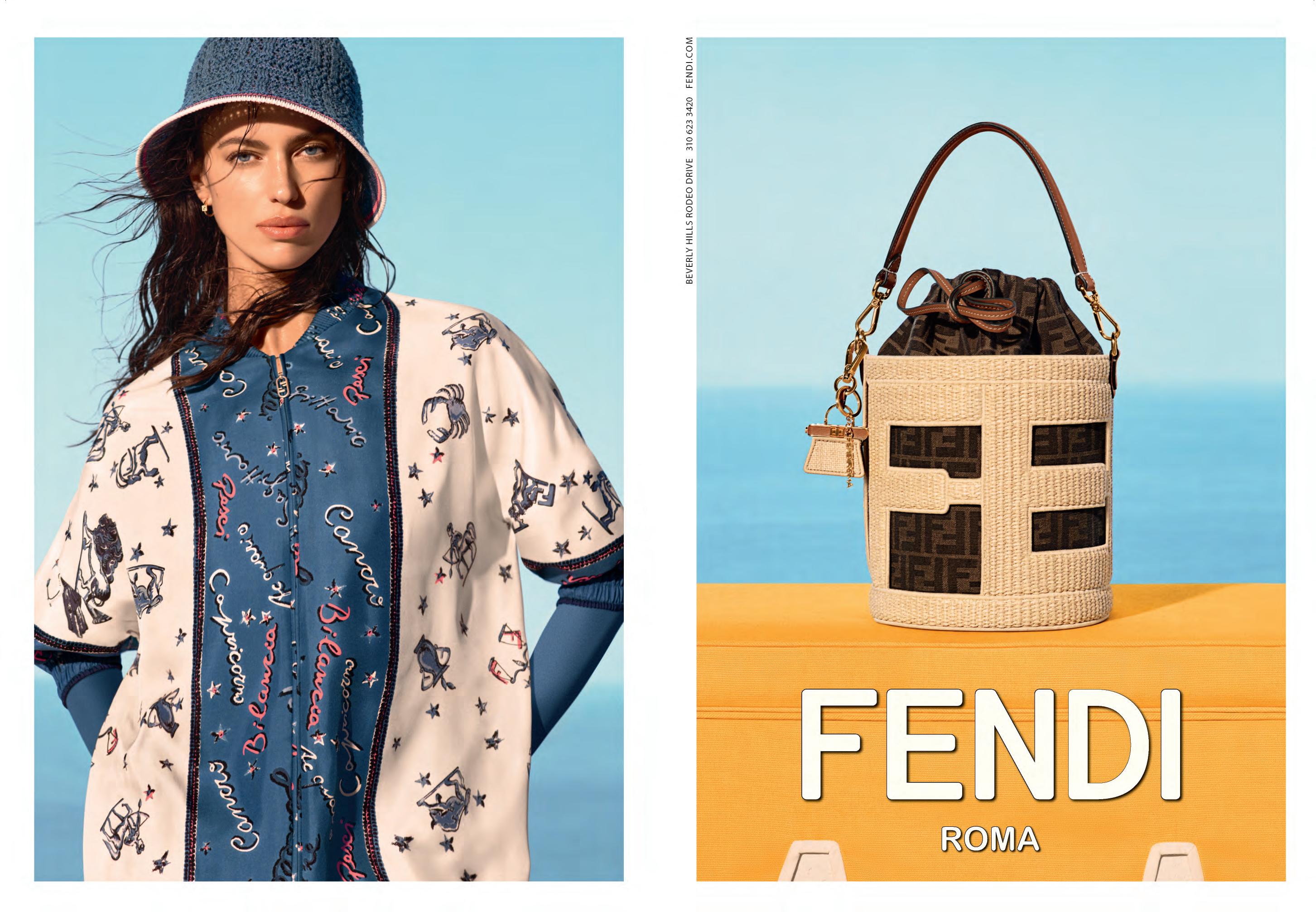

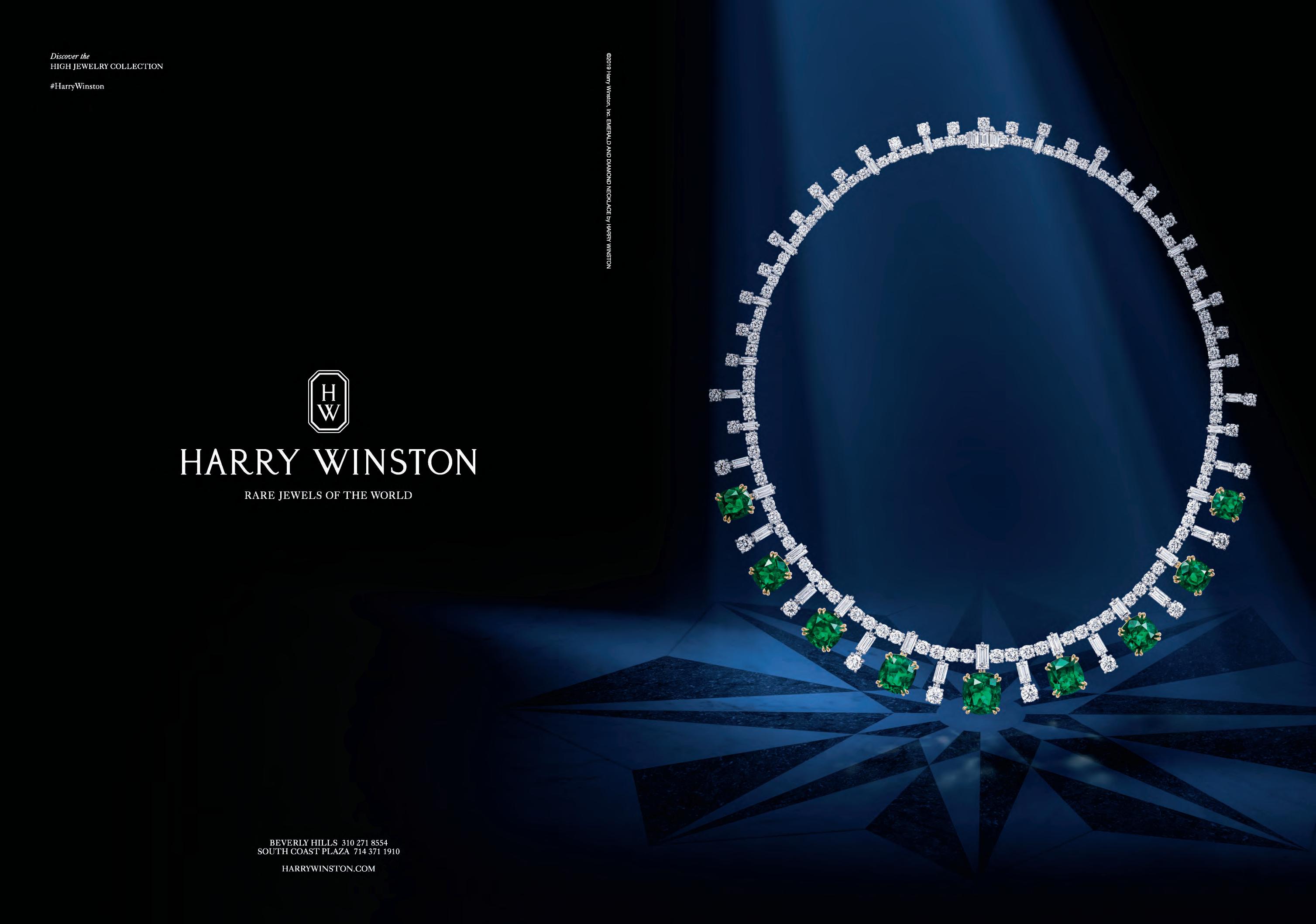

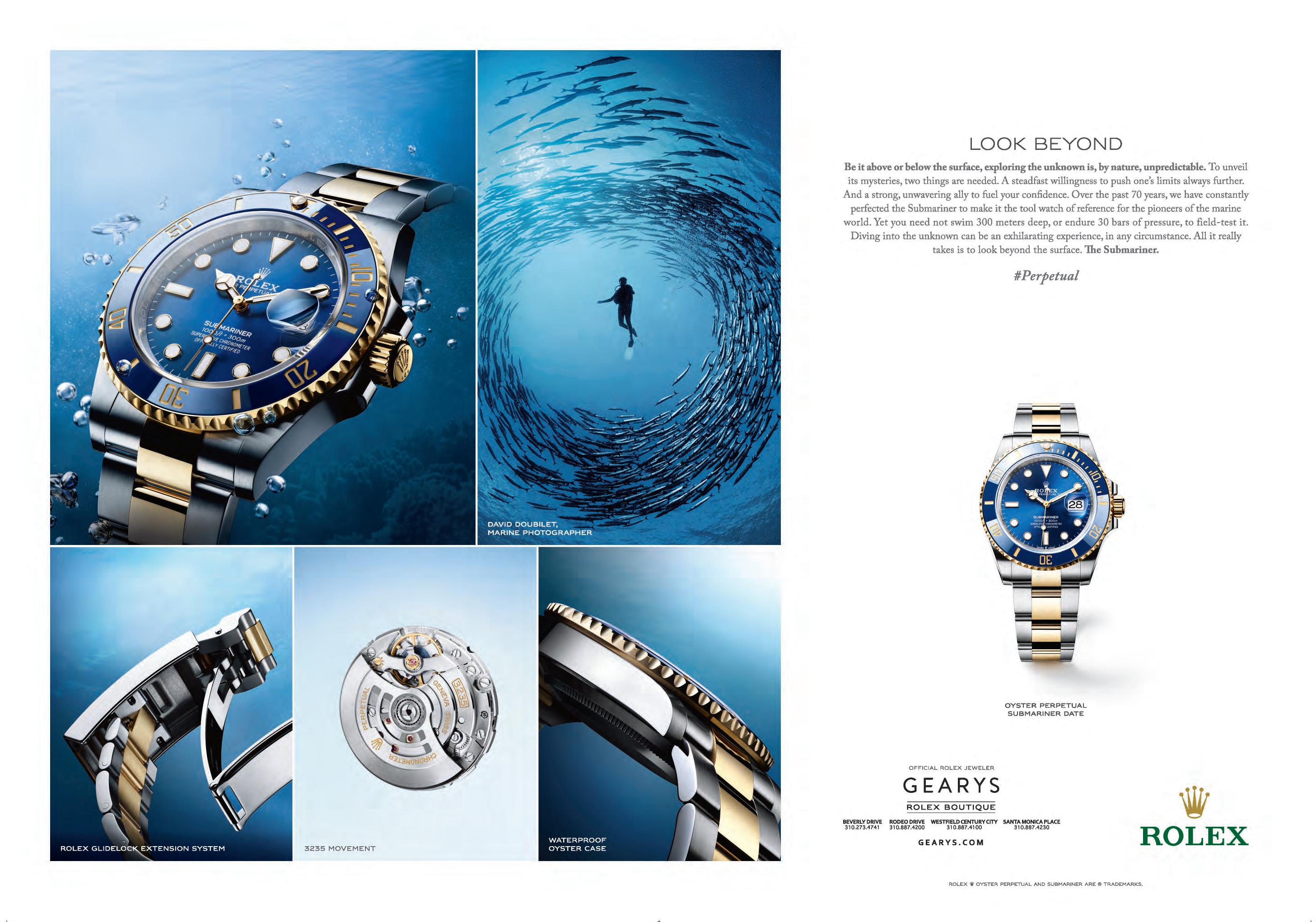

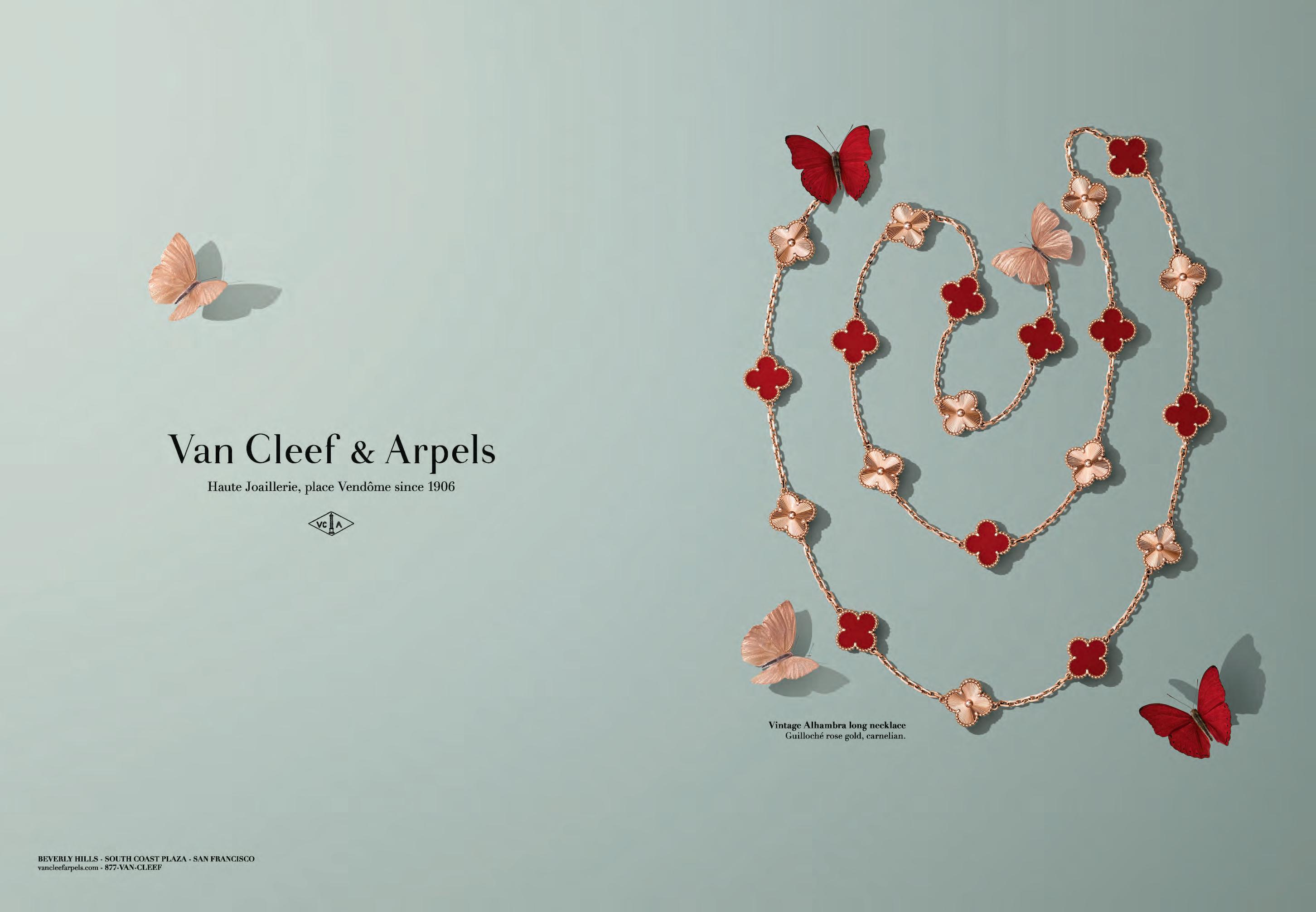

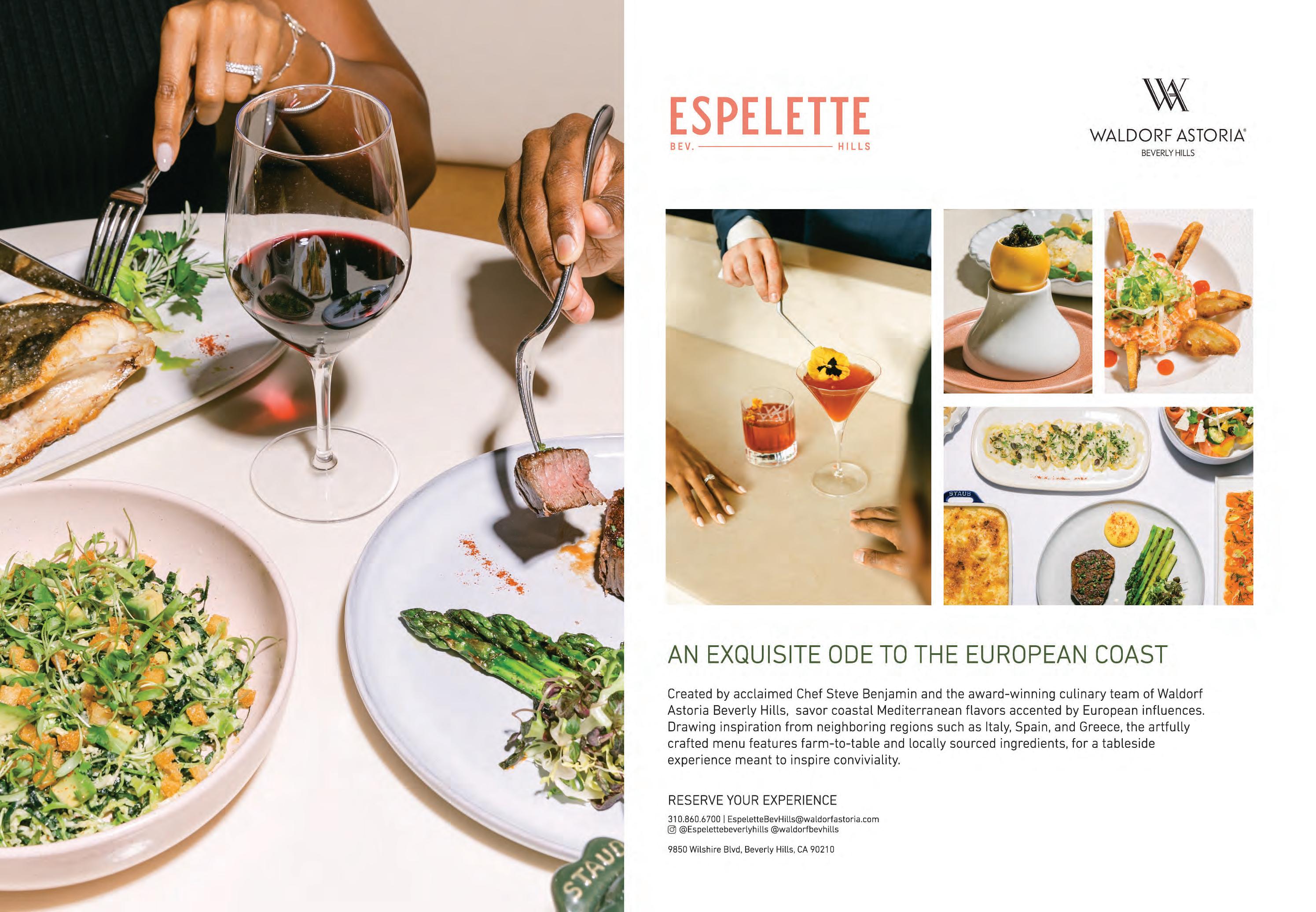

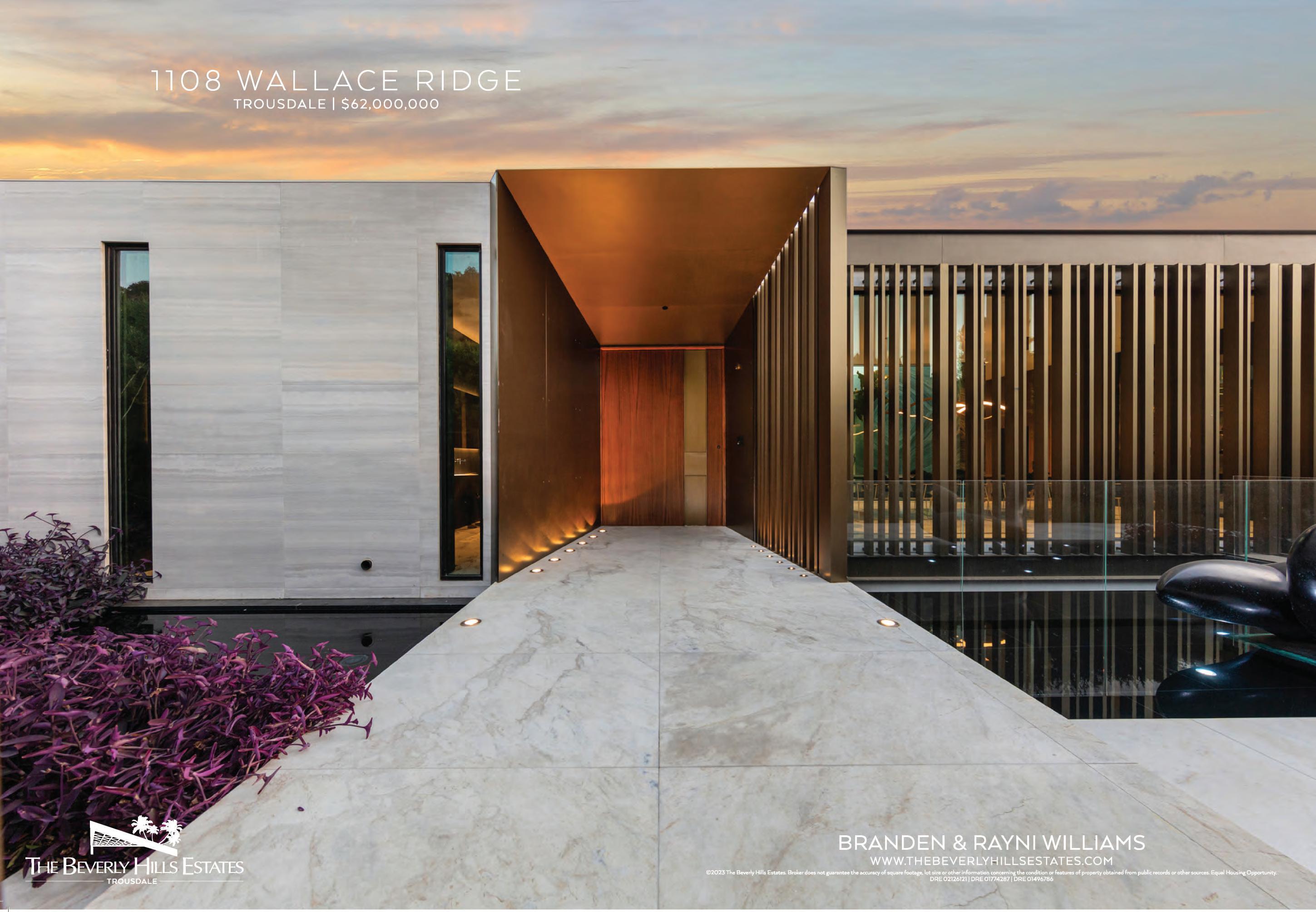

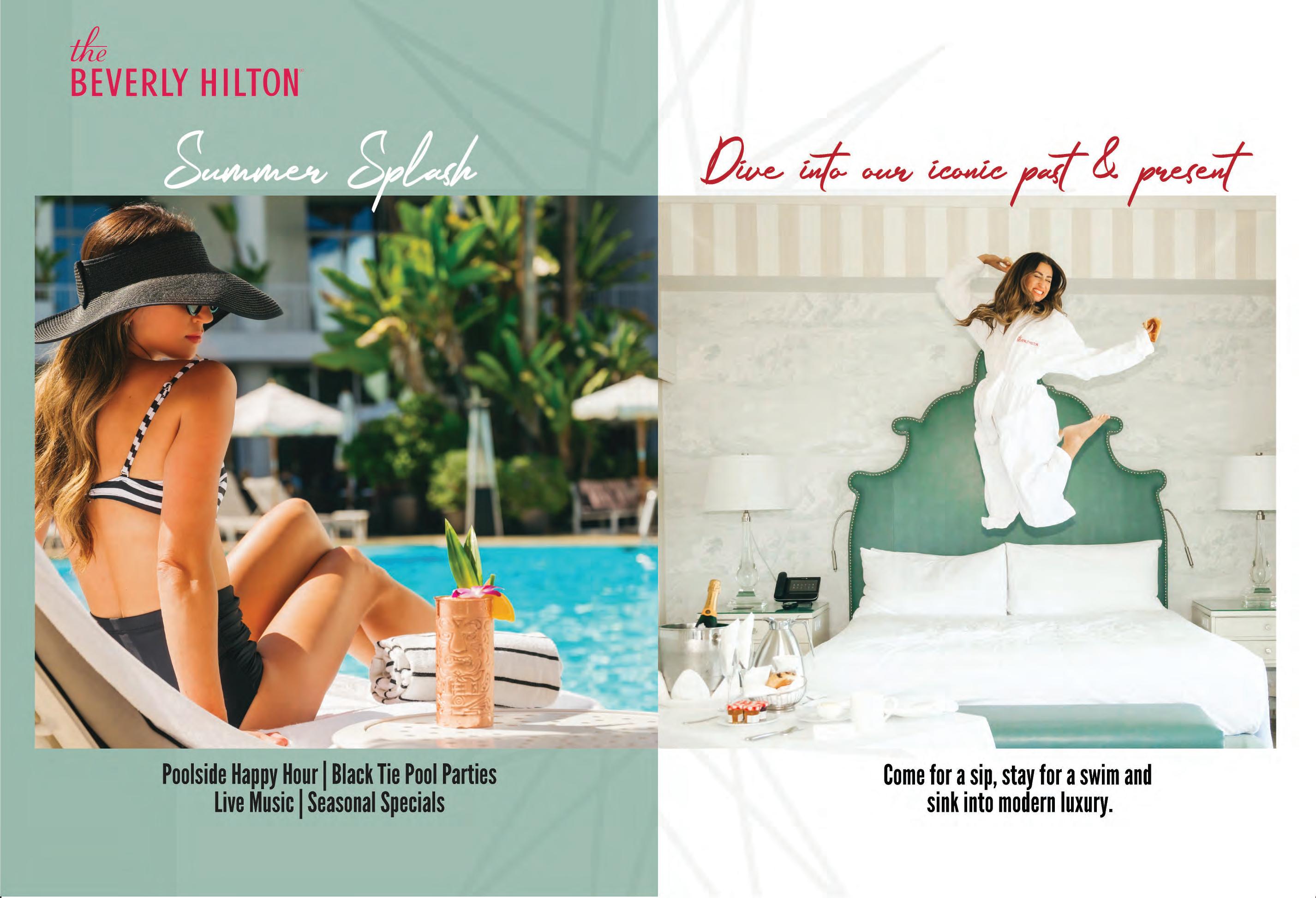





















EXECUTIVE EDITOR
Ana Figueroa
LINDA IMMEDIATO
EDITOR-AT-LARGE
Linda Immediato
WRITERS
Lisa Friedman Bloch
Linda Immediato
Neely Swanson
ADVERTISING
Dina Figueroa
Rod Pingul
Patricia A. Wilkins
GRAPHIC DESIGNERS
Ferry Simanjuntak
Jamison Province
BUSINESS OPERATIONS
Beverly Weitzman
COPY EDITOR
Dina Figueroa
BY NATASHA SEVERINO/FORWARD ARTISTS
OF LISA FRIEDMAN BLOCH BY KAREN RAY PHOTOGRAPHY
OF JOHN BENDHEIM BY KAREN RAY PHOTOGRAPHY

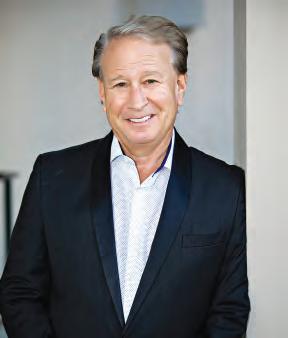
Summer is finally here in Beverly Hills! Gardens heave with vibrant superblooms after the much-needed extended rainy season. Sunlight seems to take on a more burnished glow. Nature, the greatest of the Masters, reserves her most intense color palette for this time of year.
In this STYLE issue, we celebrate the colorful artistry of summer in Beverly Hills.
Enter “The Secret Art World of Beverly Hills” and discover for yourself the jaw-dropping works, created by some of the world’s most influential artists, hiding in plain sight in our world-class luxury hotels.
Feast your eyes on this season’s hottest and coolest designer goods from sherbet-colored coolers to Pop Art towels in our vibrant “Must-Haves for Summer.”
In “The Return of the Summer Blockbuster,” we celebrate the artistry of the movie industry. Find out which beloved superhero franchises and highly anticipated films are coming soon to a theater near you.
Nature’s paintbrush is on full display in “The Wild Open Spaces of Beverly Hills.” Learn about the best spots to connect with our local wildlands. Or what about enhancing nature? Top Beverly Hills dermatologists share the latest cutting-edge devices they use to sculpt your features and figure in “The Rise of Beauty Tech.”
And last but not least, our cover story feature “Mike Amiri: Building A Luxury Fashion House On His Own Terms” takes you inside the artistically wired world of Mike Amiri. The exclusive, in-depth interview charts his meteoric rise from a Hollywood/Beverly Hills teen to one of the most important fashion designers in America.
Thank you to 3x Mayor and current Councilmember, the Honorable Lili Bosse for introducing me to our very special, homegrown visionary, Mr. Mike Amiri.
Thank you, Mike, for leaning in and giving the Courier this extraordinary opportunity.
And, of course, a big thank you to our wonderful local, national and international advertisers who support our Courier STYLE magazine and newspaper. We could not do it without you!
John and I wish you enjoyable summer months in Beverly Hills and hope you always turn to the Courier for the latest and greatest local news, events and heartfelt community connections!
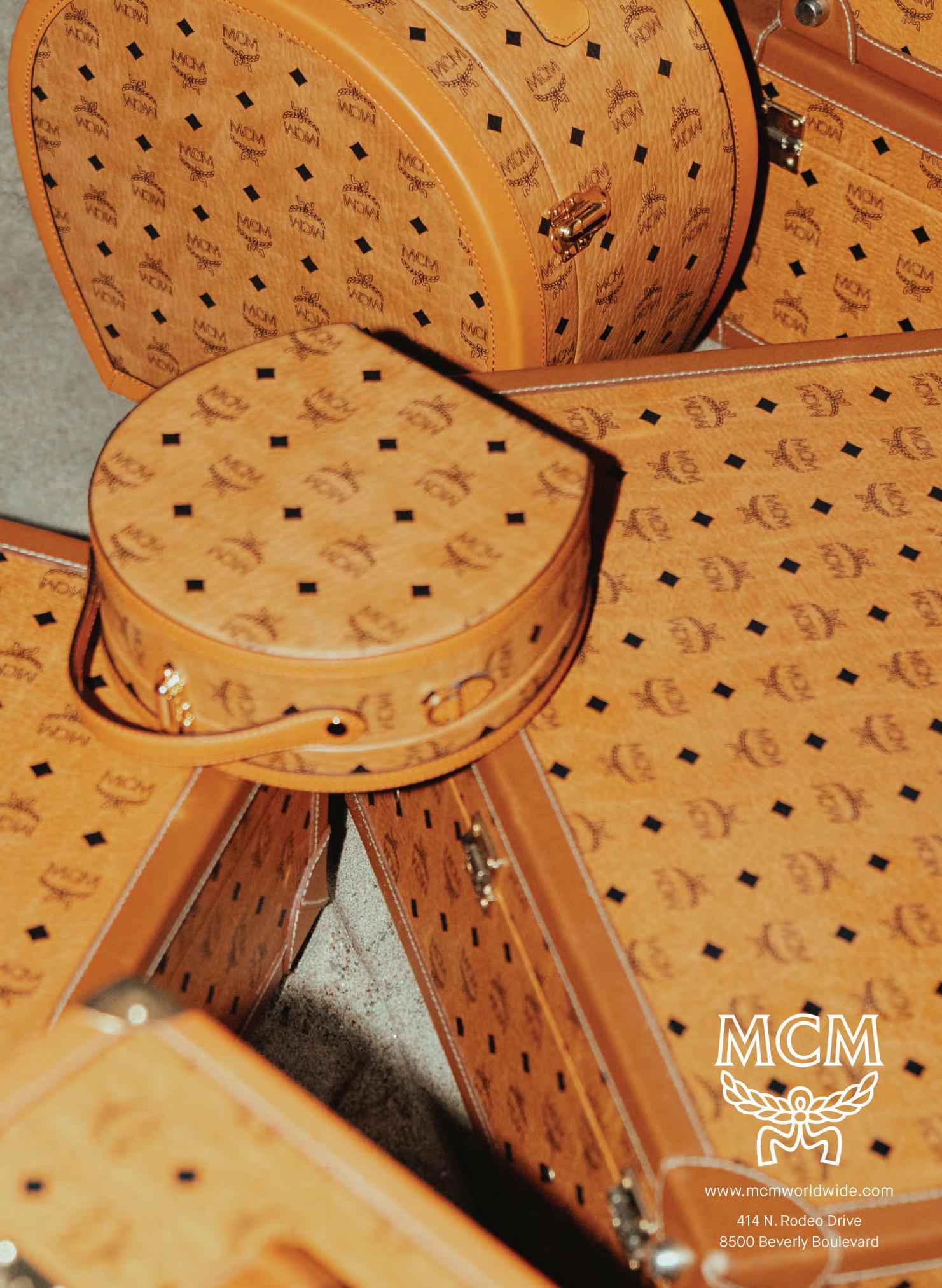
BY LINDA IMMEDIATO
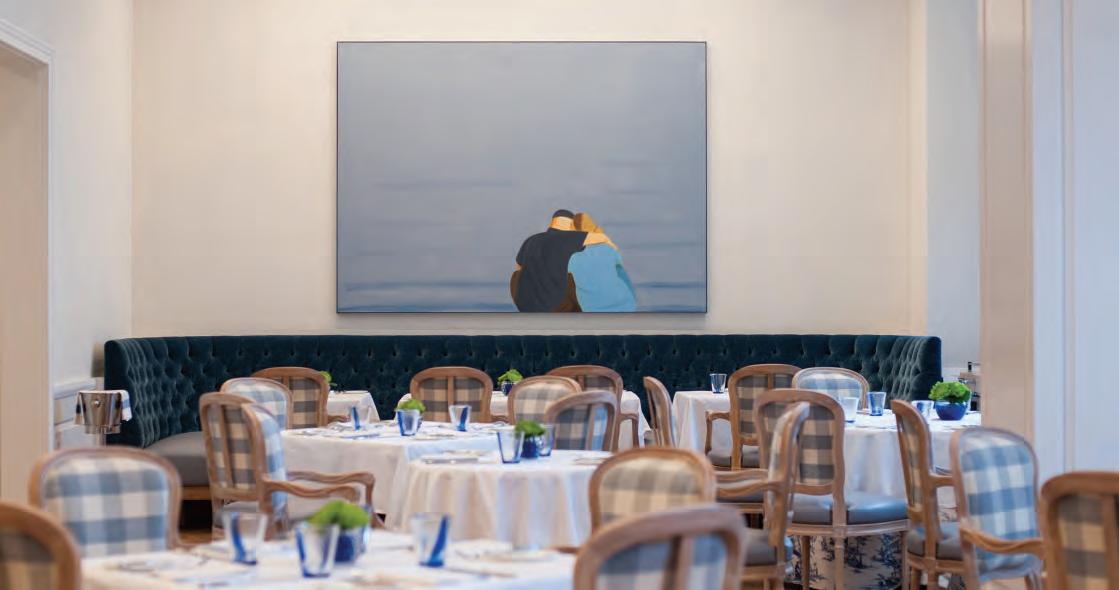
As a world-class travel destination, Beverly Hills is home to more five-star luxury hotels per square mile than any other city in the country. While people flock from far and wide to visit our famous city and stay in these top-notch accommodations, residents enjoy the benefits of having such opulent establishments in their backyards. They get pampered in the hotels’ cutting-edge spas and indulge in their fine dining restaurants. But many may not be aware of another perk right under their noses—the museum-level artwork by some of the world’s most prominent and influential artists just inside.
You don’t need to book a room to peruse the collections; the most impressive works are displayed in public spaces, dining rooms, waiting areas, corridors and lobbies.
We’ve included the highlights from each hotel’s art collection, including information about the works, the artists and where to find each piece. Consider this your self-guided tour of the art world gems that have been hiding in plain sight.
The lion’s share of the Peninsula Beverly Hills’ art collection is housed in The Belvedere restaurant, where the works of internationally acclaimed contemporary artists across a wide swath of disciplines from Abstract to Impressionist line its walls.
Two evocative pieces by French painter Fabienne Verdier hang on both sides of the restaurant’s entryway. The artist studied at the Sichuan Fine Arts Institute in Chongqing, China, where she trained with the
last great Chinese painters who survived the Cultural Revolution under Mao Zedong’s regime and honed her brushstroke and calligraphy techniques. In 2014, Verdier began to explore the connections between music and painting, carrying out extensive research in a studio laboratory at the preeminent music and drama conservatory Juilliard, where she was an artist-in-residence. Her research was the subject of the 2016 documentary “The Juilliard Experiment,” which showed the artist painting spontaneous works while faculty and students performed music live. The two pieces “Linescape I” and “Linescape II” commissioned by the hotel marry Verdier’s classic Chinese training and her pursuit of music visually interpreted as art. Created with a brush made of 35 horse tails, the works appear to be both representations of a jagged mountainous landscape and sound waves at the same time.
In “Anniversary,” by American figurative artist Alex Katz, a man and woman sit huddled affectionately together before an enveloping bluegray expanse suggestive of a rippling water’s edge. It’s indicative of the cinematic-type moments Katz often conveys in his oil paintings, which have been featured in exhibitions at highly regarded art institutions such as the Whitney Museum and the Metropolitan Museum of Art.
If the thick horizontal blue and green stripes of “Landline Burke” by Irish American artist Sean Scully call to mind the sea, you wouldn’t be wrong. The painting is part of the Dublin-born artist’s critically acclaimed “Landline” series in which he examines the concept of horizons, specifically, the just-out-of-reach space where the sea meets the sky and the “sublime interactions” that take place there.
Japanese artist Yayoi Kusama has built a decades-long career
interpreting polka dots. Inspired by the hallucinations and visions that plagued her as a child, Kusama imagined and reimagined a world dominated by dots. In the hotel’s piece, “Dots Obsession,” part of the artist’s 1998 series of the same name, they take on the look of magnified organic material as if on a slide under a microscope. In 2018, her “Infinity Mirrors” exhibit at The Broad sold out for its duration, due in part to its highly Instagrammable, trippy installations.
Pop artist Robert Indiana is best known for his iconic “LOVE” image, in which the uppercase letters of the word are confined to a square and stacked on one another. The image first appeared on Christmas cards for the Museum of Modern Art in 1965, before it was reinterpreted in other mediums, including sculptures, even an enormously popular U.S. postage stamp in the ‘70s. In The Belvedere dining room, Indiana’s “Decade: Autoportrait 1963” (1972) references the assassination of John F. Kennedy and the 10 stages of a man’s life. It is one of four pieces of the same name, part of Indiana’s “Numbers” portfolio, considered to be some of the artist’s most important work. They are largely autobiographical while offering a coded commentary on issues including the civil rights movement, nuclear disarmament and the dissolution of the American Dream. And in the outdoor dining area, one of Indiana’s “LOVE” sculptures sits proudly in the center.
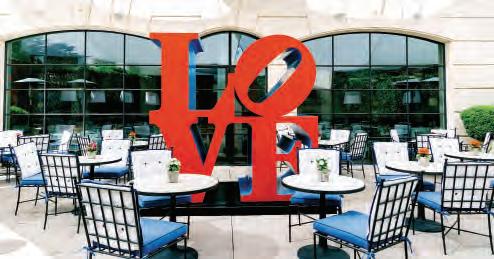
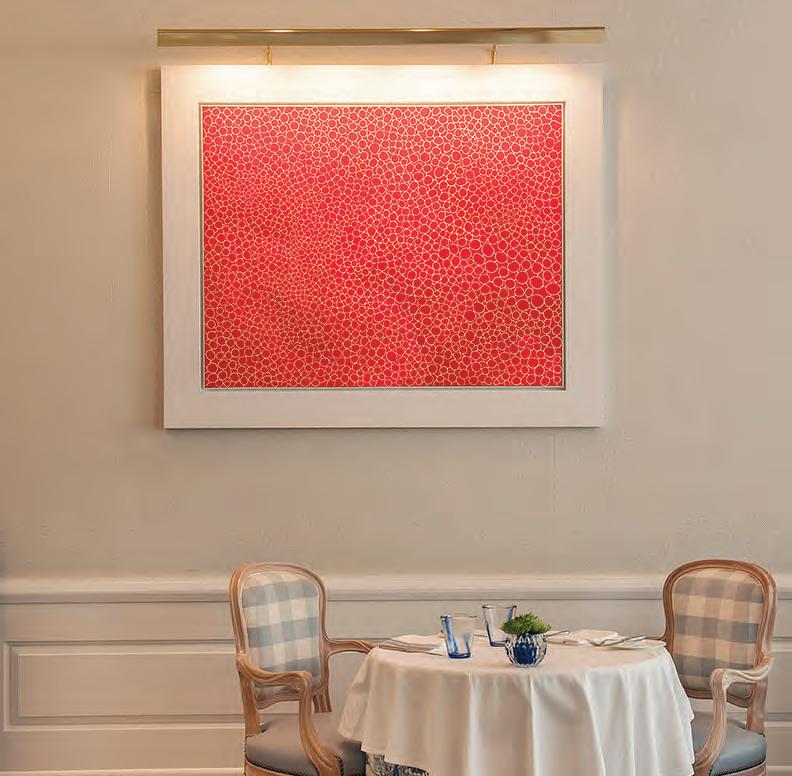
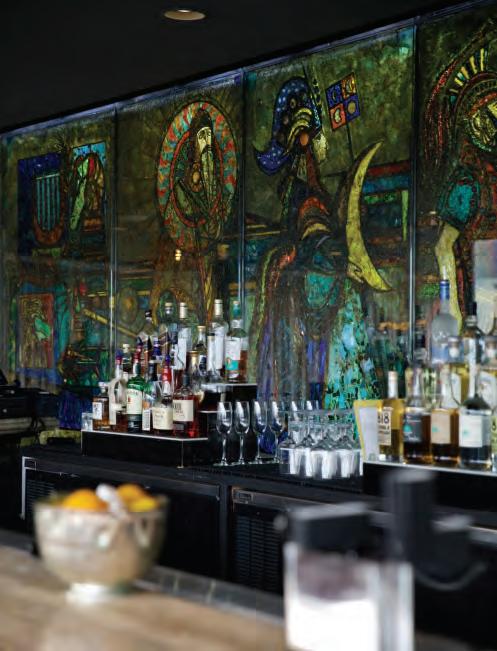
The Beverly Hilton opened to great fanfare in 1955 with a gala celebration replete with herald trumpeters and sequined bathing suitclad women riding pink-painted elephants. And in the 68 years since, it has become a hub during awards season, its grandeur and opulence the backdrop for the Golden Globes and countless celeb-studded, postaward show parties. It’s undergone the occasional nip and tucks with various renovations and upgrades over the decades, but it has always stuck to its roots as a true Beverly Hills icon. And among the hotel’s standout art pieces are the ones that pay homage to its illustrious past.
In the lobby, a 57-panel, burnished gold, mother-of-pearl mural, “The Study of Water” by Nancy Lorenz could very easily pass as an original part of the hotel’s design. It was, however, commissioned during a remodel in 2005. And despite a major $35 million renovation in 2020, which included a lobby overhaul, Lorenz’s work remained untouched.
In the hotel’s Oasis Courtyard, added in 2020 to capture classic California indoor/outdoor living, a remnant of the hotel’s past is proudly on display. Originally mounted in 1955 over the lobby’s grand staircase, the “Starburst” sculpture by famed artist Bernard Rosenthal (best known for his giant spinning “Astor Cube” sculpture in New York City’s Astor Place) spanned 15 feet and weighed 500 pounds. A portion of it now adorns the courtyard walls.
Located behind the bar at the rooftop restaurant Sant’olina, is the recently unearthed “Mallory Mural” by muralists Dale Owen and Robert Mallory. For two decades, the seven-panel mural sat without anyone knowing of its existence behind layers of drywall and wallpaper. It was covered up after the former French eatery L’Escoffier shuttered in 1994 and was forgotten. The jaw-dropping piece was rediscovered during a 2020 renovation of Sant’olina. The hotel traced its origins and found it was installed back in 1955, and the stained-glass mosaic, depicting figures from Classical Greek mythology such as Mars and Jupiter, is now the centerpiece of the space.
BY LINDA IMMEDIATO
The way we shop is changing. TikTok is branching out into livestream shopping events fueled by hashtags. “Buy now, pay later” options have proliferated, with many brands offering third-party payment installments for merchandise. And the “buy online, pick up in store” (BOPIS) concept has skyrocketed. According to an Epsilon survey last year, almost 67% of U.S. shoppers used this shopping method in 2022, a sharp increase from 50% in 2021. While this purchasing option existed long before the pandemic, the need for social distancing during COVID-19’s yearslong run really drove this concept into the mainstream. And consumers have grown to love the time-saving option so much that it is replacing the traditional shopping experience. It doesn’t just shave minutes off the shopping process, it can save the whole trip since you’ll be alerted if an item is no longer in stock before you even get into the car. Of those polled who prefer BOPIS, 77% reported the reason was the ability to see an item before taking it home and return it on arrival if it doesn’t suit them, avoiding the hassle of packaging and shipping fees.
Think of this curated collection of summer’s hottest items as an analog way to browse before you buy.
1. You’ll be lapping up compliments wrapped in this Hermès terry cloth beach towel. With its sherbet hues and retro ‘60s pop vibe, it’s more like a work of art than a poolside necessity. $680 at Hermès, 434 N. Rodeo Drive, 310-278-6440 and hermes.com
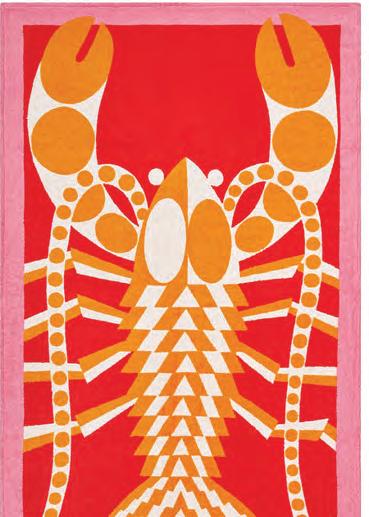

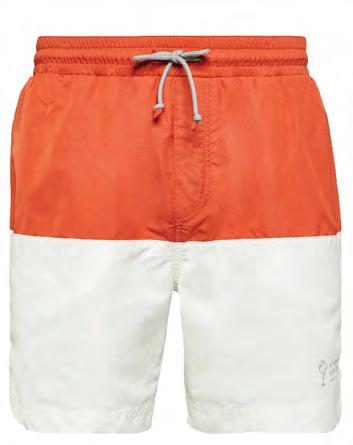
2. No need to worry if you lingered too long at the shore (and who could blame you?); you can forgo an outfit change in these crisp and stylish two-tone swim shorts by Brunello Cucinelli. They can go straight from the beach to the bar, and no one would be any the wiser. $595 at Brunello Cucinelli, 220 N. Rodeo Drive, 310-724-8118 and shop.brunellocucinelli.com
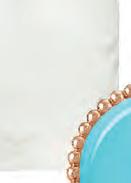
3. The sleek, knife-edge design of the “Atlas X” hoop earrings by Tiffany & Co. was inspired by the jeweler’s famed 1886 engagement ring setting, which started it all. Roman numerals, etched into the sides of the polished 18-karat rose gold hoops, are a nod to the giant clock that sits atop the brand’s landmark Fifth Avenue flagship in New York. $3,600 at Tiffany & Co., 210 N. Rodeo Drive, 310-2738880 and tiffany.com


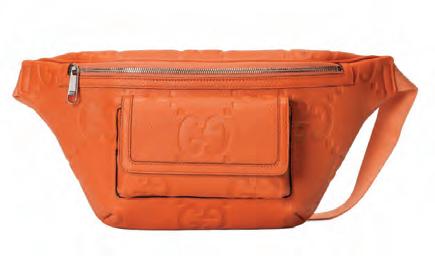




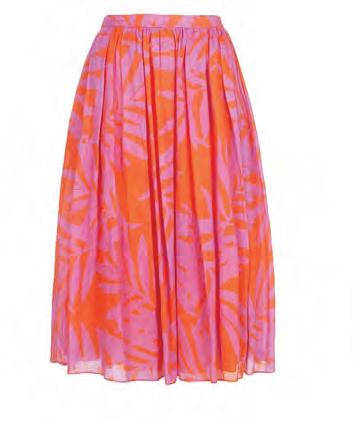

4. Made of turquoise, coral and 18-karat rose gold, this bangle from the “Perlée” collection by Van Cleef & Arpels masquerades as an everyday casual bracelet, but it’s been keeping a secret. Slide the larger stone to the side, and you’ll discover an elegantly hidden timepiece with a mother-of-pearl dial and diamond-studded bezel. $37,800 at Van Cleef & Arpels, 300 N. Rodeo Drive, 310-276-1161 and vancleefarpels.com
5. Whatever you may call it—a fanny pack, hipster, or belt bag—the hands-free capabilities of this luxurious leather version by Gucci are invaluable when you’re traveling or going anywhere with small children. $1,700 at Gucci, 347 N. Rodeo Drive, 310-278-3451 and gucci.com
6. Slip this bright and breezy Carolina Herrera skirt over a one-piece bathing suit for a quick cover up or pair it with a simple white tank and dressy sandals for a chic upgrade. $635 at CH Carolina Herrera, 230 N. Rodeo Drive, 310-2768900 and carolinaherrera.com
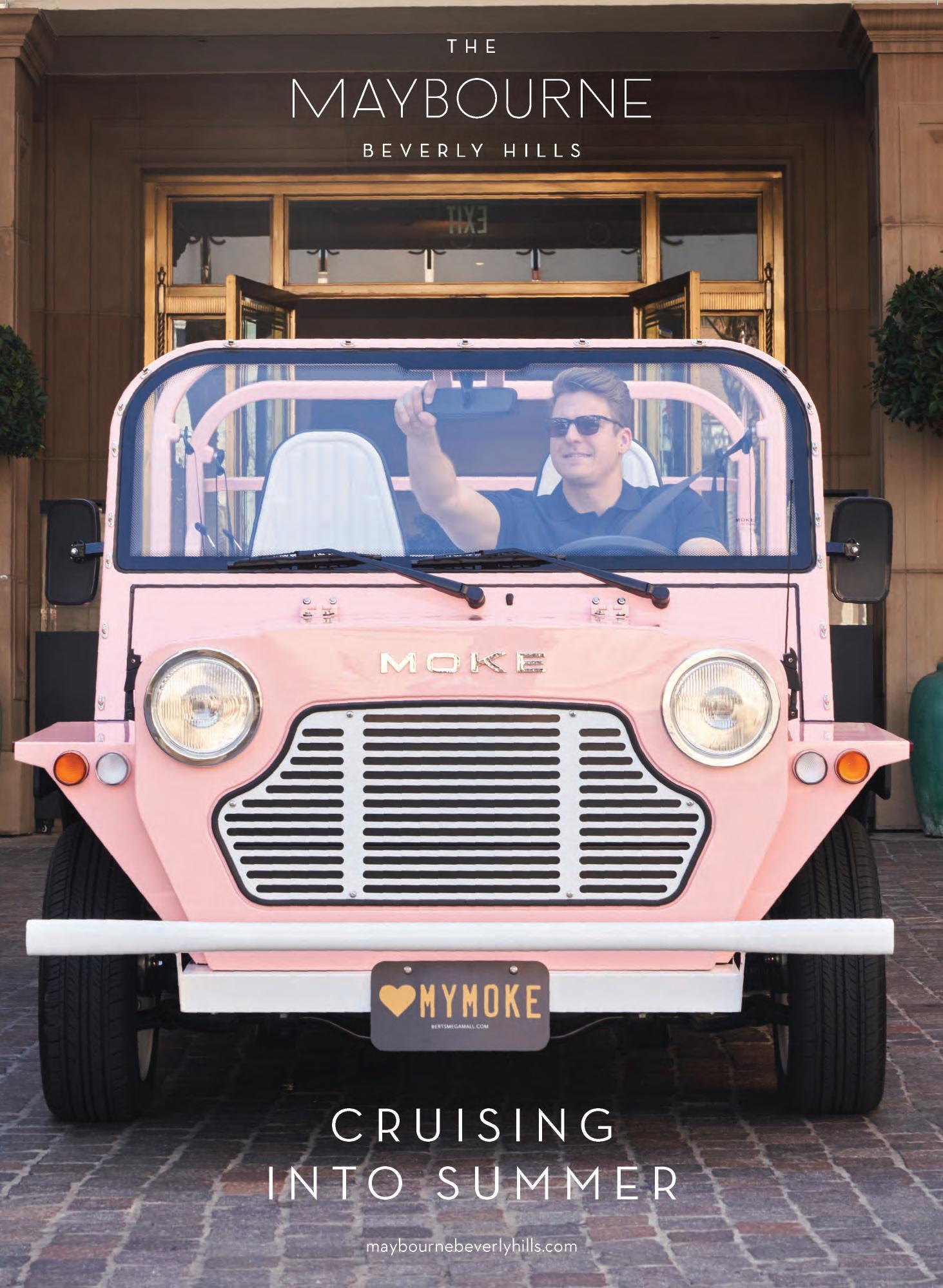
BY NEELY SWANSON
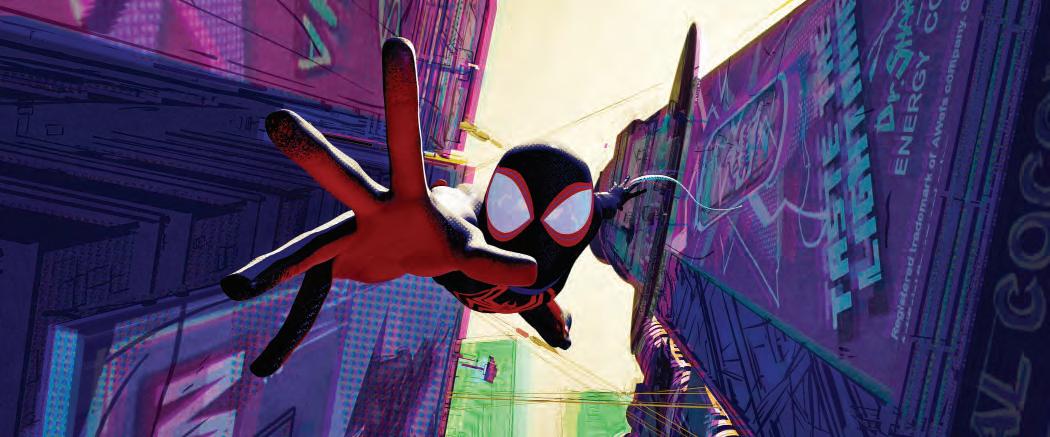
“SPIDER-MAN: ACROSS THE SPIDER-VERSE” PHOTO COURTESY OF SONY PICTURES ANIMATION (C) 2023
School is out, the days are longer, and the nights are warmer—yes, summer is indeed officially here! And with it comes a long-standing tradition of the season—the summer blockbuster. This is the time when the most highly anticipated movies of the year finally hit the big screen. And we all know what that means: Studios will release their biggest-budget action movies, Oscar-potential hits and offbeat comedies destined to become cult favorites—with runaway box office sales results.
For years, studios overlooked this cash cow…until the summer of 1975. Steven Spielberg’s blockbuster hit, “Jaws,” changed everything and brought with it the concept of a tentpole, a movie big enough that others could fit under that umbrella. And ever since, franchise films like “Star Wars” and more recently, anything from the Marvel multiverse, could expect a summer slot.
Now streaming platforms such as Apple TV+, Netflix and Amazon, to name just a few, have hopped on the summer hit bandwagon. Making and distributing their own content so impressive that they have begun to contend for and win Oscars. Breaking new ground, “Moonlight,” distributed by Amazon, turned the industry on its head when it won the 2016 Oscar for Best Picture. In 2020, several films distributed by streamers, including “The Sound of Metal’’ (Amazon), “Mank” (Netflix) and “The Trial of the Chicago Seven” (Netflix) were up for awards. In 2022, several streaming movies entered the race for Best Picture, including “Don’t Look Up” (Netflix), “Power of the Dog’’ (Netflix) and the Oscar winner, “CODA” (Apple TV+).
The pandemic certainly put a damper on the summer blockbuster season. For more than a year, many theaters weren’t even allowed to open, and the only accessible entertainment could be found on television. Although production shut down during much of this time period, the studios still had a stockpile of content to release, and they did it on streaming platforms and pay-per-view. In 2019, 792 films were released in theaters; that number dropped to 334 in 2020 and rose slightly to 406 in 2021 and 449 in 2022. This year, analysts like JP Morgan’s David Karnovsky are predicting a 15% jump in summer box office sales. Not quite pre-pandemic levels by any means, but a hopeful sign that the industry is bouncing back.
The rebound began last year, when cinema owners and movie producers received the first bit of good news since theaters reopened—with summer films filling out the year’s top 10 lists, including “Jurassic World: Dominion,” “Doctor Strange in the Multiverse of Madness,” “Minions: the Rise of Gru” and “Thor: Love and Thunder.” The standout, “Top Gun: Maverick,” stayed atop the box office charts throughout the year. There’s a theme here, and it’s a time-honored formula—bigger, louder and a sequel. The familiar sells, bigger is better and you’ll see that in the upcoming weeks.
With a slew of potential hits on the horizon, from new installments of established franchises like “Indiana Jones” to Christopher Nolan’s likely Oscar contender “Oppenheimer” and the already social mediahyped “Barbie” (along with several big-ticket, streaming releases), this season is poised to mark the official return of the blockbuster. Here’s our rundown on what to see—and what not to miss—this summer!
“Spider-Man: Across the Spider-Verse” continues the animated adventures of Miles Morales, Spider-Man in his universe, who joins Spideys from parallel universes to save the world. “Spider-Man: Into the Spider-Verse” was extremely engaging and cleverly written with a diverse and talented voice cast. With the same production team and another sequel in the works, hopes are high. The original crossed demographic lines allowing it to be a family-oriented tentpole.
“Transformers: Rise of the Beasts” brings us up to date, well, rather into the mid-‘90s, with those creatures that morph into mechanical robots of scary dimensions, melding live actors with the menacing machines. The remarkable voice cast is led by Oscar-winner Michelle Yeoh, Ron Perlman and Pete Davidson with hot young actress Dominique Fishback, fresh from “The Swarm,” doing battle as Elena. This will be a metal-to-metal fight between the new-style transformer, the Maximals (robotic animals) and the villainous Decepticons.
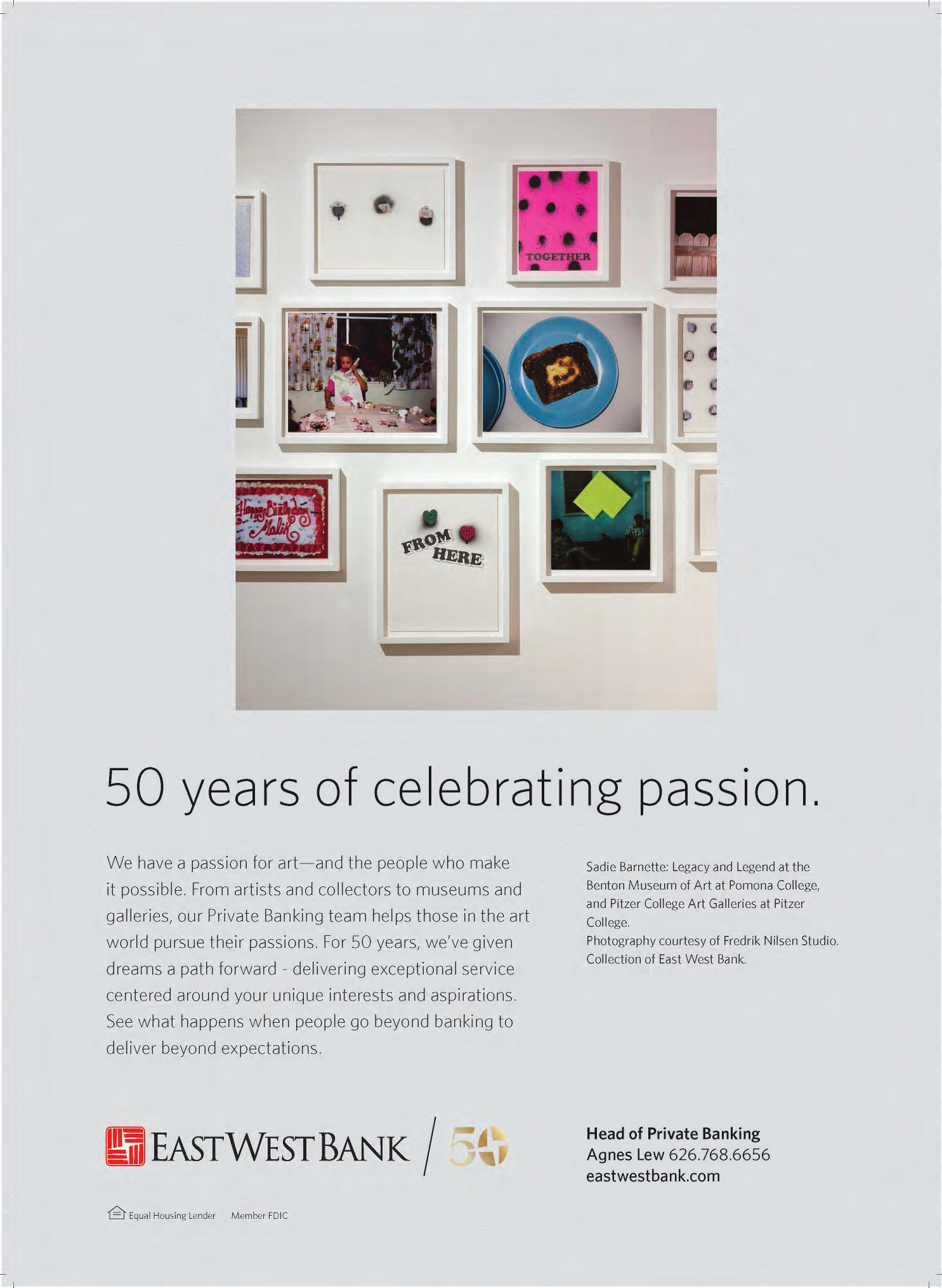
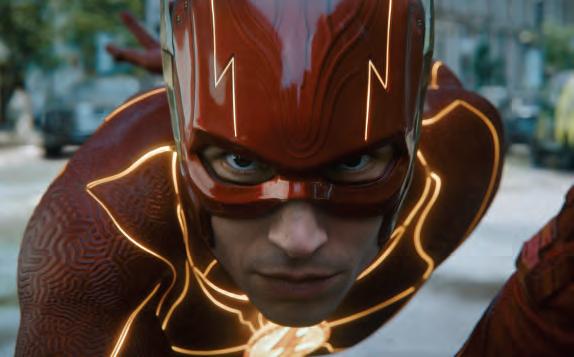
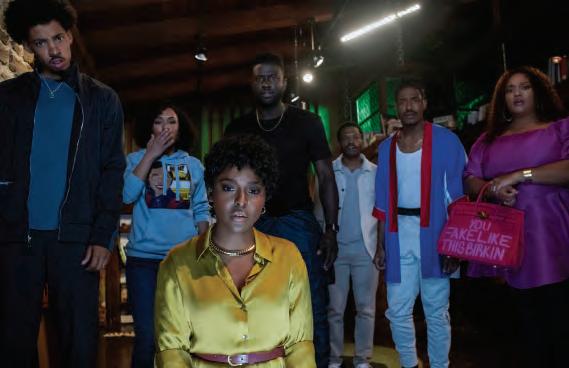
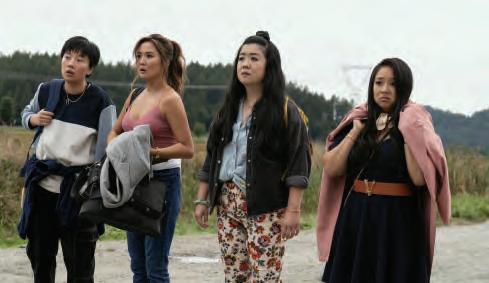
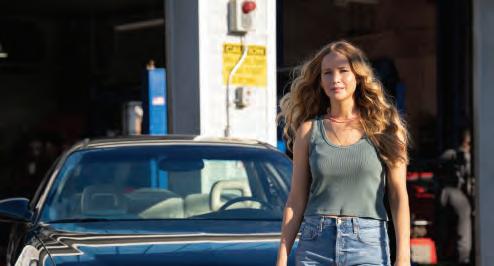
JUNE 9
“Flamin’ Hot,” Eva Longoria’s directorial debut, centers on Richard Montañez, the janitor who catapulted to fame and fortune when he added spicy flavor to Cheetos.
JUNE 16
“The Flash,” based on the DC comic hero, sounds like it might be some fun, if only because it brings back previous Batmen Ben Affleck and Michael Keaton, the original, to try and help extricate Barry Allen aka The Flash from the heap of trouble he created by going back in time to try and prevent his mother’s murder. Superheroes and supervillains from the past rear their heads as the universe as we know it is upended. I’m guessing George Clooney and Christian Bale weren’t available. The gifted but arrest-challenged Ezra Miller stars as Barry Allen/The Flash.
“The Blackening” is a clever take on the presumption that in horror films, the Black guy always dies first. But what if you bring a group of Black friends together to celebrate at a cabin in the woods where a killer lurks in the background? The movie’s tagline sets it up: “They can’t all die first.”
“Elemental” from Pixar Animation mixes characters representing fire, water, earth and air all learning to live together even when they don’t mix, as an allegory for multiculturalism.
“Asteroid City” is the new Wes Anderson film with an all-star cast led by Anderson favorite Jason Schwartzman and a whole passel of terrific actors like Scarlett Johansson, Tom Hanks, Brian Cranston and Hong Chau; and that’s just the tip of a very big iceberg. It’s 1955, and the Junior Stargazer/Space Cadet convention is meeting in a desert town when events occur that spectacularly disrupt the world order. Comedy? Drama? Science Fiction? It’s Wes Anderson; it’s all of the above.
“Extraction 2,” is the follow-up to (you guessed it) “Extraction,” led again by black ops mercenary Tyler Rake (Chris Hemsworth) who must conduct another search and rescue mission.
JUNE 23
“No Hard Feelings” is that much-needed comedy starring Jennifer Lawrence. Trying to save her childhood home, she answers a titillating ad. The job? Date the soon-to-leave-the-nest, introverted son of incredibly intrusive parents with unlimited boundary issues. Piece of cake? Not really.
JUNE 30
“Indiana Jones and the Dial of Destiny,” directed by James Mangold (with the blessing of Spielberg and Lucas) stars Harrison Ford, reprising his iconic role. A stellar cast—including John Rhys-Davies (“Raiders of the Lost Ark”), Antonio Banderas, Phoebe Waller-Bridge and Mads Mikkelsen, among others—accompanies a ready-for-retirement Indie as he tries anew to make sure that an important piece of archeological history remains safe. Suffice it to say, there will be Nazis. The original, “Raiders of the Lost Ark,” was the tentpole for the summer of 1981, and here we are back again with one of the surefire hits of 2023.
“Joy Ride” is about the irreverent adventures of one girl’s business trip to Asia that goes wildly off the rails and how, eventually, with the help of her best friends forever, disaster turns into the road of self-discovery (and a lot of raunchy fun). Directed by Adele Lim, with a cast led by Stephanie Hsu, Ashley Park, Sherry Cola and Sabrina Wu.

BY LINDA IMMEDIATO
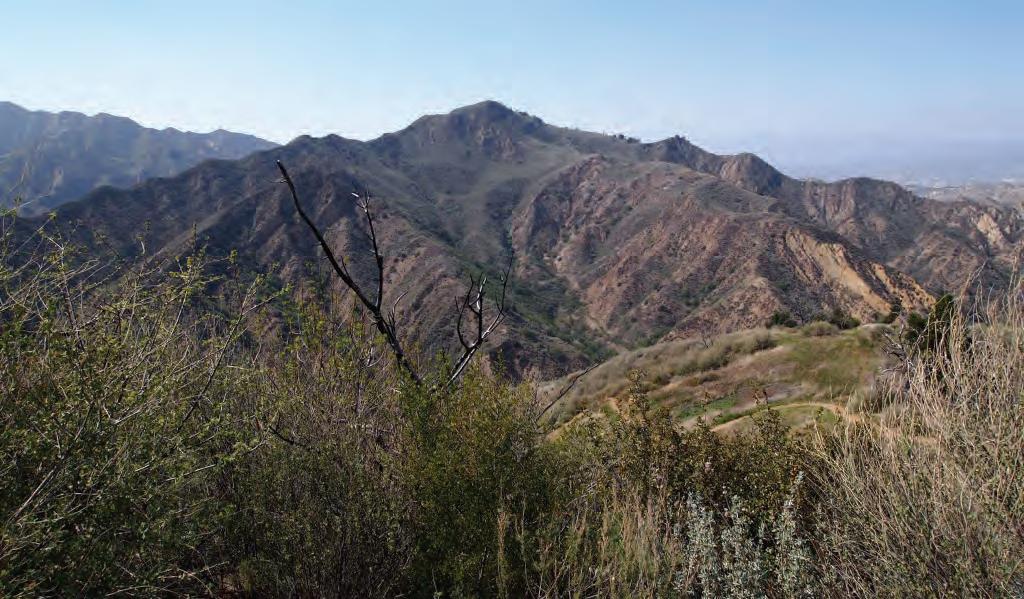
At the northernmost edges of Beverly Hills lies an urban wilderness, an expansive landscape with chaparral-studded slopes and grassy meadows shaded by oaks, populated by all manner of woodland creatures. These are the real hills of Beverly Hills.
Far above the hustle and bustle, the sound of traffic fades away. You enter a pristine world of quiet and solitude. Unlike the hiking spots in Griffith Park, overrun with tourists looking for ways to get to the Hollywood sign, these sanctuaries feel remote.
Here, nature lovers can take the paths less traveled.
On 605 acres of protected land between the San Fernando Valley and Beverly Hills sits Franklin Canyon Park. In addition to miles of hiking trails, the idyllic setting boasts a three-acre lake, a pond and an abundance of picnic tables.
As part of the Pacific Flyaway, a north-south migration path extending from Alaska to Patagonia, Heavenly Pond is a bird watcher’s paradise. Among the hawks and horned owls, you’ll find many species of duck nesting in the reeds at the water’s edge, including the rare Mandarin, which outside of the Far East and London, are only known to make a home in Franklin Canyon. The adjacent Heavenly Pond Trail is ADA-compliant, allowing those with mobility issues to enjoy the surroundings.
The three-acre Franklin Lake (Franklin Canyon Reservoir) is an important watershed for the canyon, providing habitat and sustenance to the wildlife that resides there. It sits in the middle of a trail called the Reservoir Loop. Flat, wide and level, it’s perfect for pushing strollers while strolling. And the lake provides the ultimate serene backdrop for
picnickers dining alfresco at its waterside benches.
Fun fact: The park itself has been the backdrop for many films and television shows, including doubling for Mayberry in “The Andy Griffith Show;” the Heavenly Pond is the pond in the Oscar-nominated film “On Golden Pond;” and Franklin Lake played the Amazon River in the 1954 monster movie, “Creature from the Black Lagoon.”
For diehard hikers, the park’s five miles of meandering trails, which afford fantastic sweeping vistas of West Hollywood and Downtown Los Angeles, are the real draw. There are less challenging loops like the Discovery Trail and more strenuous paths that take you up the slopes until the canopy of oak, walnut and sycamore gives way to native shrubs and wildflowers. At the top, you can cross the Santa Monica Mountains to Coldwater Canyon and Wilacre Park. At the southern end of the park, there are trails used for monthly, guided full-moon hikes and stunning nighttime views of Los Angeles.
Franklin Canyon’s history begins at a time when Los Angeles was just a fledgling town, and the pursuit of oil and water were the powerful forces conspiring to build a city. In 1914, the year the city of Beverly Hills was incorporated, William Mulholland and the Department of Water and Power (DWP) began construction of a reservoir in upper Franklin Canyon. It was built to capture water, purchased in an infamous deal with Owens Valley, and transported to the location via Mulholland’s legacy-making, engineering marvel, the Los Angeles Aqueduct.
HIKING CONTINUES ON PAGE 48

BY LINDA IMMEDIATO

Let’s face it, no one is getting any younger. And since antiquity, we’ve been searching for the fountain of youth. These days the search is aided by machines.
Decades ago, lasers were something out of the sci-fi realm, wielded by Jedi’s using the Force. Now, they’re a common part of the beauty arsenal, and they are constantly upgraded with new and improved versions, doing more with less downtime, fewer repeat treatments and offering more efficacy.
We’ve expanded well beyond lasers; now sound waves like radio and ultrasound frequencies are used to melt fat deposits or mold them to restructure the contours of the face like Silly Putty. Plasma is harnessed from atmospheric disturbances in the air to smooth and even skin. Wrinkles, skin laxity, scars, dark spots and a multitude of other tell-tale signs of aging can be reversed without going under the knife.
There’s a constant stream of breakthrough technologies and cutting-edge devices appearing in dermatologists’ offices all the time, it’s hard to know where to start. So, we spoke to some of the leading beauty experts in Beverly Hills to uncover the latest and greatest in beauty tech for turning back the hands of time.
Dr. Ava Shamban is a board-certified dermatologist with practices in Santa Monica and Beverly Hills. She’s the go-to beauty source for publications such as Glamour, InStyle and New York Magazine and for television programs, including CBS’s “The Doctors” and ABC’s “Extreme Makeover” and “Good Morning America.” Shamban is also a frequent expert on CBS News, CNN, Extra and Fox News.
She says her Beverly Hills clients come to her, generally speaking, to address three basic beauty concerns: signs of aging on the face (wrinkles, fine lines, brown spots); neck laxity; and excess body fat.
In the case of the first, she recommends CoolPeel (not to be confused with CoolSculpting, the body contouring treatment). CoolPeel is the first FDA-approved, non-invasive, painless treatment that targets age spots, acne scars, fine lines and wrinkles. It works by delivering short pulses to the skin’s surface, creating microchannels in the skin. Unlike traditional laser resurfacing treatments, CoolPeel uses a unique system that keeps the skin cool and protects it from thermal damage, allowing the laser to
penetrate deeper into the skin’s layers. It can be used on the face, neck, chest and other areas of the body.
Years ago, if you wanted to erase sun damage, smooth wrinkles and even skin tone, you had one option: the chemical peel, which involves applying a topical acid solution to the face that causes the top layers of the skin to peel away. The treatment can be painful (depending on how deep you go), and the downtime can be lengthy. At a minimum, you’ll walk around looking like a roasted tomato for a couple of weeks. But blurring fine lines and wrinkles requires a deeper peel with up to 20 days of recovery, and you’ll spend a portion of that time in face bandages looking like a horror movie ghoul. While chemical peels are still an option, it’s no longer your only choice. Lasers changed the game, and the tech is constantly changing and improving. CoolPeel is part of the next generation of resurfacing lasers, and according to Dr. Shamban, it’s one of the best.
“The CoolPeel is a very superficial laser resurfacing treatment that has very little downtime and no discomfort, which is why it’s called a ‘cool’ laser,” said Dr. Shamban. “The advantage it has over a chemical peel, which people have been doing for a long time, is that you get more tissue stimulation because you’re using a laser. So not only will you get a nice exfoliation of the skin and improvement in fine lines and wrinkles and removal of brown spots, but you’re also going to stimulate more cell turnover and more collagen production. We have people do a series of treatments, we suggest three, with the device. The other thing that’s nice about it is that it can be done in the summer, as long as you’re committed to wearing a hat and routinely applying a sunscreen layer.”
Prep for CoolPeel is simple: the target area is cleansed, and a numbing cream is applied (you’ll have to wait an hour for it to fully take effect before the treatment begins). During the procedure, you will feel the slight sensation of short bursts as the laser is moved along the skin, but its cooling mechanism keeps discomfort to a minimum. Typically, the treatment takes 15 to 30 minutes. The downtime is typically just a few hours to a day of slight redness and minor peeling over time, akin to a mild sunburn. “But it’s not going to be terrible,” Dr. Shamban added, “It’s not like your skin will be coming off in sheets.”
Within a few days to a week, you’ll see an improvement in the texture and tone of your skin, which will continue over the next several weeks as your body responds to the laser by producing collagen and elastin.
When it comes to tackling neck laxity (the crepiness and sagging of the skin around the jawline and neck), Dr. Shamban says the most effective non-invasive treatment is Softwave, a skin-tightening device that utilizes breakthrough ultrasound technology.
“I think it’s best in class for tissue tightening,” she said of the device. “We use it on the neck, jowls, face and chest, but it also works great in other areas and is effective in treating cellulite.”
Softwave sends heat to a depth of exactly 1.5 mm into the dermis, the area of the skin responsible for keeping your skin smooth. The device employs a new delivery method called “synchronous ultrasound parallel beam technology” (SUPERBTM) to apply the heat, which causes your body to ramp up collagen production at the target site. This influx of collagen gives structural support and increases volume to combat fine lines, sagging skin and wrinkles. Softwave has also been proven to show results in combating the appearance of cellulite on the buttocks, with study participants showing post-treatment improvement using the Cellulite Severity Scale.
For your first session, typically a maximum of 45 minutes, expect a warm or mild tingling sensation during the treatment. And the best part? There is zero downtime, and results are visible after a single
BEAUTY CONTINUES ON PAGE 54

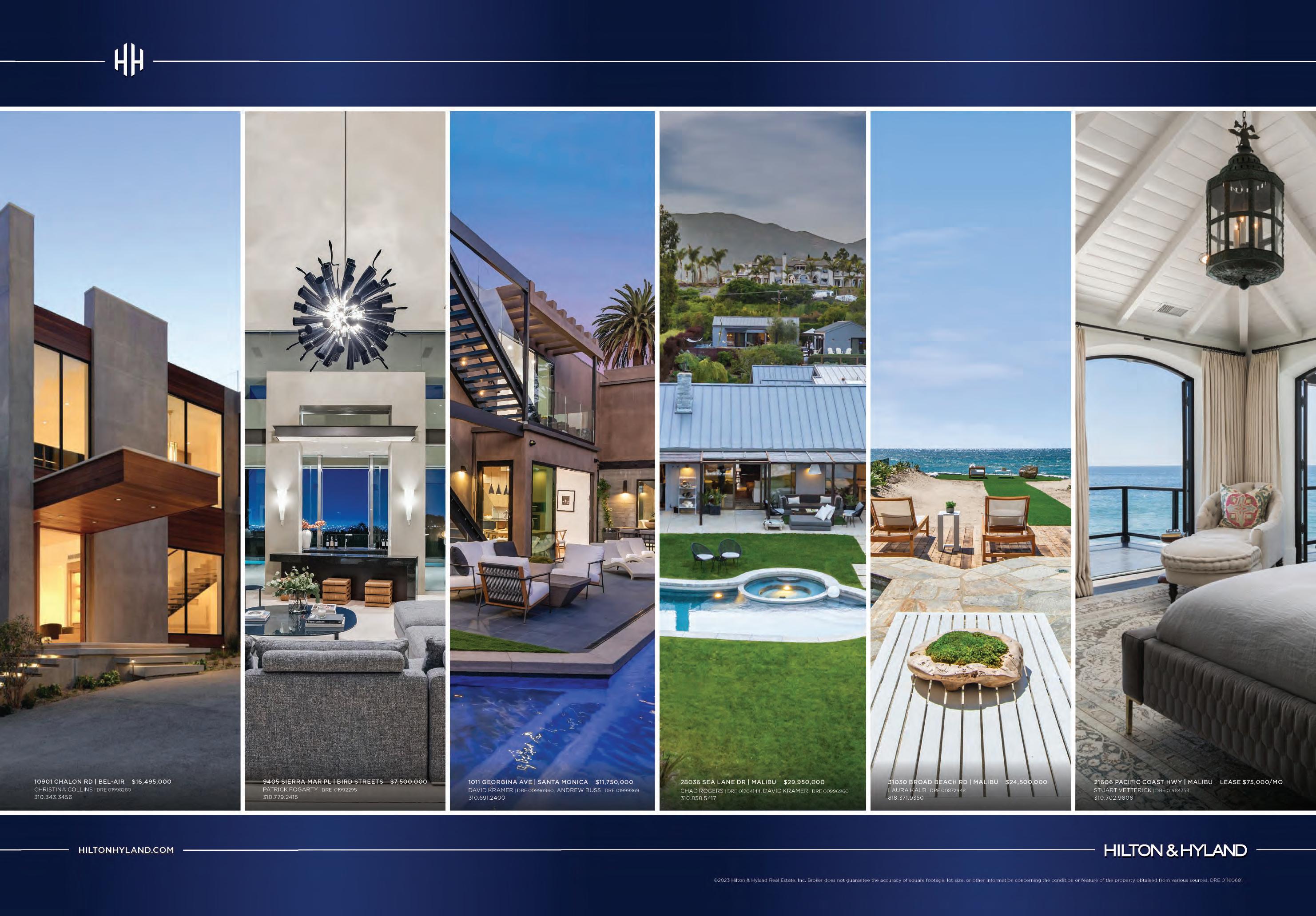

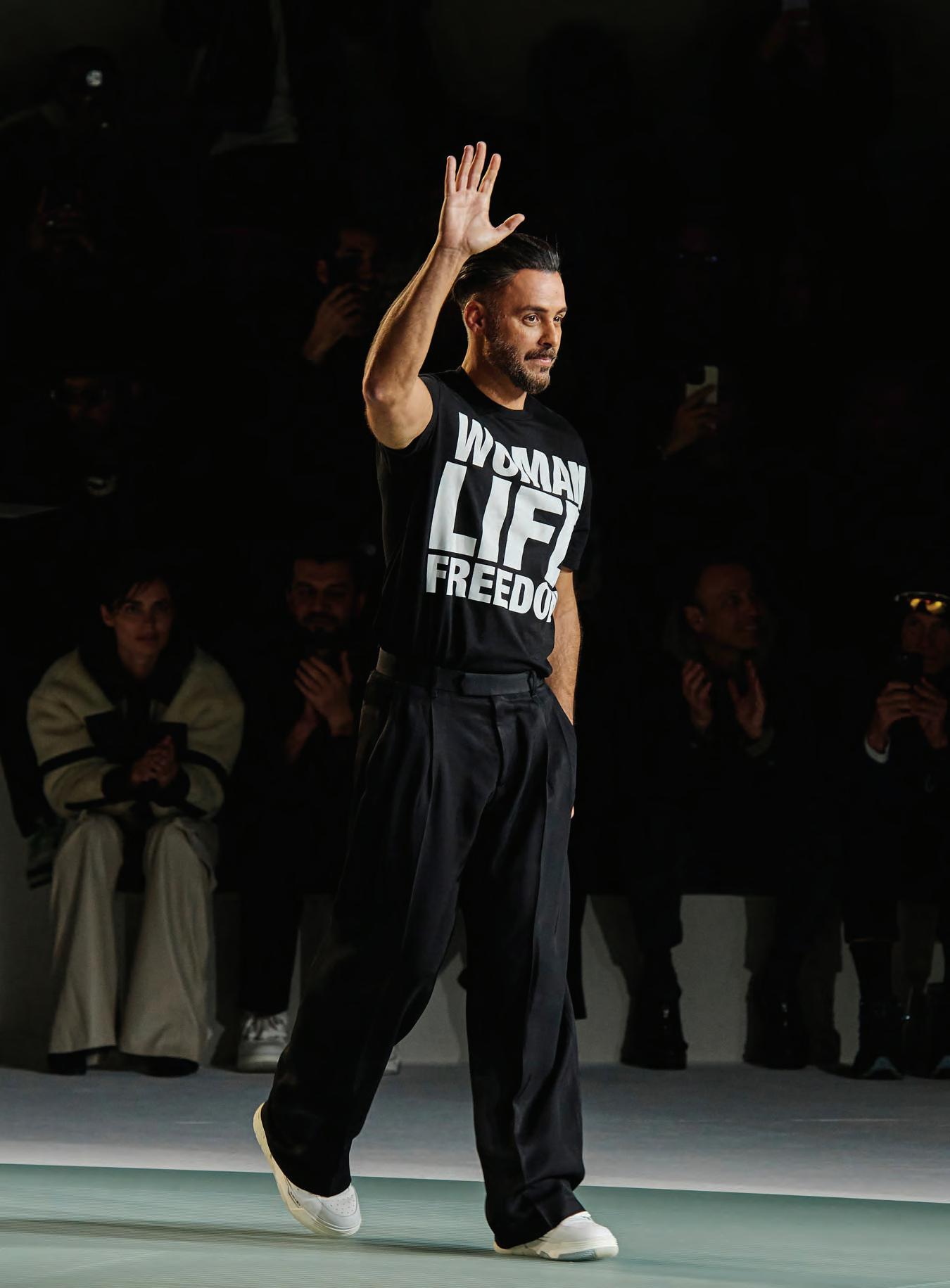
BY LISA FRIEDMAN BLOCH
The year is 1991. The setting, Beverly Hills High School.
Walking aimlessly down a wide, empty corridor, past the lockers toward math class, Mike Amiri’s 15-year-old imagination steers his thoughts and slows his pace. Turning the corner, he crashes into somebody.
“Sorry,” says Mike, quickly realizing that somebody is Lenny Kravitz! The rock star!
A former student of the school, Kravitz is at the height of his fame.
“I’m Mike,” he offers, containing his excitement.
“Lenny”
“I know. Love your music. But what are you doing back here?”
“Thought I’d stop by. See some of my old teachers.”
“Want some help?”
“Sure. You know Mrs. McKenzie?”
Mike leads Lenny. They reach room 170.
Lenny peeks in, “Yep, that’s her.” Mike opens the door.
Mrs. McKenzie looks up, “Mr. Amiri, shouldn’t you be in class?”
Lenny pops in front of him. Mrs. McKenzie lights up! The class goes wild. Mike, a die-hard, impressionable rock ‘n roll fan, stands back, rapt in the moment, his math class a million miles away.
Twenty-six years later, at the posh Hotel Costes restaurant in Paris, Mike is dining with his wife, Shirin, when Lenny Kravitz approaches.
“Mike…”
“Lenny…” Mike stands to greet him.
“My stylist just texted me you were here. I wanted to thank you for the jacket you made me. I love it.”
“I’m glad,” says Mike.
“It’s iconic.”
“It’s pretty nice,” Mike offers humbly.
“Great to finally meet you,” says Lenny.
“We’ve met before.”
“We have?”
“Years ago. When you visited Beverly High.”
“That was you? Really!”
Mike nods yes.
In that moment of serendipity and recognition, they embrace.
Bumping into a rock star in the hallway of your high school is unbelievable, even if that school is Beverly Hills High. But to meet him decades later and find yourself on par with that rock legend, that is extraordinary. This chance encounter is one of the many signposts along Mike’s journey signaling that Mike Amiri, the fashion designer, has arrived.
In just nine short years, Mike has built an indisputably world-class, luxury fashion house. His eponymous fashion line, AMIRI, blew up so fast it gave established houses whiplash as they watched the new kid on the block open his flagship near them on Rodeo Drive in 2020. Back in 2014, Mike was stitching one-off stage pieces for musicians like Axl Rose and Justin Bieber from the basement of a Thai restaurant in Hollywood. Soon, he was selling out collections at the fashion cult mecca Maxfield. He has been nominated three times (in 2019, 2021 and 2022) for the prestigious Menswear Designer of the Year Award by the Council of Fashion Designers of America, alongside Tom Ford and Rick Owens.
Today, it’s The Weeknd, Usher, Leslie Odom, Jr., Black Coffee, J Balvin and Teyana Taylor who are wearing Amiri’s clothes. And his fans aren’t limited to those from the stage. A-list movie and television stars like Brad Pitt, Paul Rudd, Rege-Jean Page, Tessa Thompson, Natasha Lyonne, Robert Pattinson, Tyler James Williams and Jared Leto wear AMIRI. Mike’s reach has spread to athletes as well, such as Lionel Messi and Odell Beckham Jr. In the championship boxing bout in Las Vegas on April 22 of this year, boxer Ryan Garcia wore head-totoe AMIRI in and out of the ring.
Along with the Beverly Hills flagship, there are currently nine standalone AMIRI stores worldwide in the U.S., Japan, United Arab Emirates and China. Part of the meteoric rise also involves 160 boutiques, “shop in shops,” inside globally esteemed retailers including Neiman Marcus, Saks Fifth Avenue and Bergdorf Goodman in the U.S.; Selfridges and Harrods in London; Galeries Lafayette in Paris and Joyce in Hong Kong.
With the expansion into footwear, womenswear, children’s wear, accessories and lifestyle products, along with his newly renovated store on Rodeo Drive, AMIRI is projected, as reported in the Wall Street Journal, to do $320 million in sales in 2023, up 56% from last year.
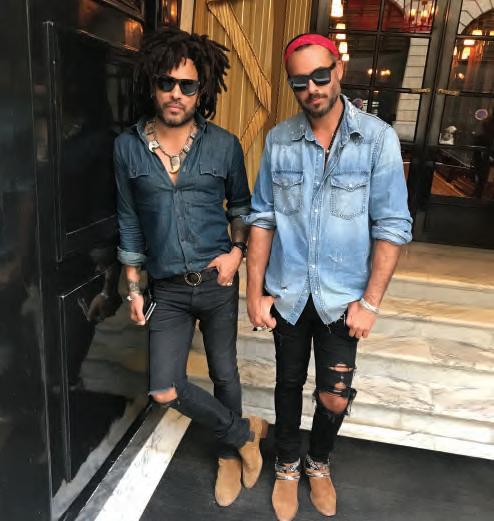

The soul of the brand is, at its very essence, Mike Amiri himself. His interpretation of California luxury lifestyle is undeniably authentic, built on his own life experiences growing up in Los Angeles, playing basketball, skateboarding, creating street art and hanging out at the rock clubs on Sunset Boulevard.
Where other fashion labels attempt to replicate L.A. culture with products like logo-emblazoned skateboards or campaign images featuring our famous palm tree-lined streets as backdrops, Amiri is the real deal.
So, how did a kid from Beverly Hills High, with no connections, without a bottomless trust fund and zero fashion design education get here? It’s an oft-asked question by those who want to know his “secret sauce.”
I set out to find the answer.
Leaping over puddles on the rare rainy and windy day on Rodeo Drive, I reached AMIRI’s flagship storefront as the black-suited security guard opened the door to let me in. And like Dorothy’s gloomy, black-and-white Kansas switched to sunny Technicolor Oz, this dark day quickly transformed into a bright, calm, inviting AMIRI haven. I soaked in the store’s staging, the simplistic artistry, the mood-setting music and the strategically suspended clothing hanging from the high ceilings. Here, purses mimic chic basketballs, skateboards are designed by L.A.based artist Wes Lang and handcrafted leather totes show off California landmarks.
Soon, Mike Amiri, like the mastermind from behind the curtain, emerged from the back of the store, brandishing a warm smile, reflecting the sunshine he seemingly created. With a welcoming hug, he led me upstairs in search of a more intimate space for our interview. On the way, we passed a stylized workspace, a walled art installation featuring spools of thread in a rainbow of colors above matching antique sewing machines. Mike shared that the cabinets in front of the wall were filled with drawers of handcrafted or fine bejeweled accessories to enhance custom design for AMIRI’s exclusive VIP clientele.
In the next room, he invited me into a living room-like setting, poised for our interview with two stunning AMIRI logo motif armchairs, surrounded by soft drapery. I could not wait to dive in, to learn how this young designer had stormed the fashion industry in record time, and
how he found the magic that ignited a global community to embrace his critically acclaimed, Los Angeles-based luxury brand.
The son of two Jewish Persian immigrants who owned an antiques business, Mike grew up first in Hollywood, then Beverly Hills. The middle of three boys, Mike spent a big part of his childhood in a dreamworld.
“Oftentimes, I created things, adventures, by myself, in my head… At some point, I realized that my brain was just geared for creating things that don’t exist and the possibilities that may exist. It wasn’t necessarily about clothing. It was just more storylines, or narratives, or looking at things a little bit differently than other people saw them.”
He also pursued your average teenage boy interests like basketball, skateboarding and riding BMX bikes. At some point, Mike became captivated by the notion of heroes, spending many hours watching the heroic deeds of characters in Westerns and war films with his father, a proud enlisted U. S. Army man.
“I love the idea of heroes, not just lead singers in rock bands, but in any field. Currently, I’m fascinated with people who become iconic in their fields, those who are obsessed with ideas regardless of adversity.”
Wanting to be cool like the rockers in Hollywood, Mike merged his finely honed imagination with his desire to stand out. In middle school, he attempted his first trendsetting garment. Having seen the punks on the street with DIY patches on clothing, he asked his friend’s mom to sew the front of an old Mötley Crüe T-shirt onto the back of his denim jacket. For $20, he created his own Mötley Crüe piece. Soon his friends in Beverly Hills followed.
“It was me kind of creating that hero for myself.”
When you distill Mike’s recollections of adolescence, a clearer picture emerges, one perhaps defined by his, sometimes fraught, search for a creative outlet. One of these outlets was graffiti, which, while in high school, put him in minor trouble with the law. This led to himsitting down with the school’s counselor. During their meeting, Mike recalls the counselor’s suggestion, “Maybe you just have a need to see your artwork displayed, and you’ll get a sense of pride from that.”
It made an indelible impression on Mike.
“It really changed my understanding of why it happened. It really
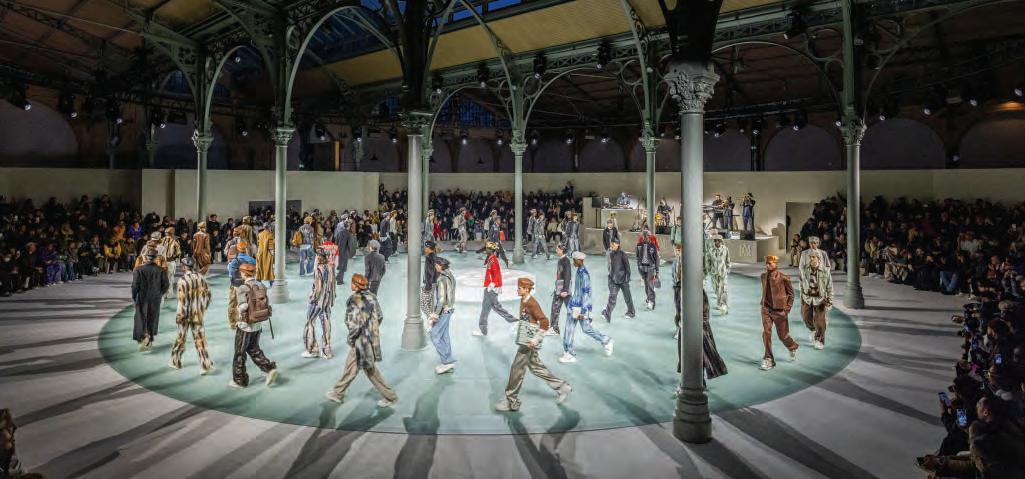
made sense to my teenage brain.” Pondering today, Mike shares, “When you connect the dots backward, it’s really amazing.”
A Renaissance man, Mike taught himself how to play the piano and drums, and how to use production software on the computer. While in college, Mike reconnected with his old friend, Tiger JK, considered one of the founders of the hip-hop movement in South Korea.
Tiger JK was a classmate of Mike’s at Beverly Hills High School.
“I just really loved kind of exploring how to create things… And when I knew he was interested in music, I said, ‘Well, I can make songs [with him].’ I really fell in love with doing that part of it. It felt natural to me. He ended up becoming a really big artist in Korea, and I would go there and visit him, and sometimes help him perform.”
In the process, Mike learned how to read and write Korean. The group won awards at the Asian Music Awards, honoring much of the music Mike produced and wrote.
Mike knew in his heart this was a detour and not his true path. But the lessons he learned prepared him for the next chapters of his life.
“I did understand what it was like to create something. And watched it carry on a life of its own. To make something from nothing… It’s saying ‘yes’ to something that you have a creative opinion. And not looking at it in a way [in which] it’s unbelievable or ridiculous, whether it’s creating music in a foreign country or saying that you’re going to build a luxury brand.”
When he returned from Korea, Mike applied to law school. “It seemed like a very responsible thing to do… to follow a safe path.”
Mike chose a school that had a campus eight blocks away from the heart of the fashion district in Los Angeles. While he was working towards a law degree, he satiated his artistic drive.
Curious and intentional, Mike submerged himself in the many facets of the fashion industry.
“I would go to the vintage stores and open a blazer and try to understand why they put padding on certain areas. It was deconstructing and trying to understand how things are made.”
He engaged with stylists who were creating pieces for different people. Through them, Mike learned the processes of making a finished product. Soon, the stylists asked Mike to help create garments for their artist clients. He was also included in the design projects for some of the larger American fashion houses.
Eventually, he took the leap and set out on his own, deciding any limitations he would face would be seen as opportunities. He likened
the need for resourcefulness to the garage band days of his youth, when the fonts of inspiration and creativity flowed more than funds.
“The thing we always talk about within the design studio is let’s pretend that we can’t buy the best pinstripe wool in the world. So how do we create that? What makes Amiri ‘AMIRI’ is not the fact that we’re able to use the best materials in the world. It’s the fact that we’re able to bring something new to the conversation, which is a youthful, creative sensibility.”
While he was defining his brand’s identity, Mike began to build an impressive clientele of L.A. performers making hand-crafted, unique stage pieces for them. This experience guided him to explore an authentic L.A. rock ‘n’ roll fashion vibe. Mike experimented using traditional materials, manipulating them and employing some outside-the-box craftsmanship. For example, he took cashmere sweaters and jeans to the desert in Joshua Tree and blasted them with a shotgun to give a scorched and tattered effect.
As a native with extensive travel experience, Mike was well aware of the way Los Angeles has been perceived by the world as a place where dreams are born. He wanted to incorporate this uniquely L.A. feeling as a part of his brand’s identity.
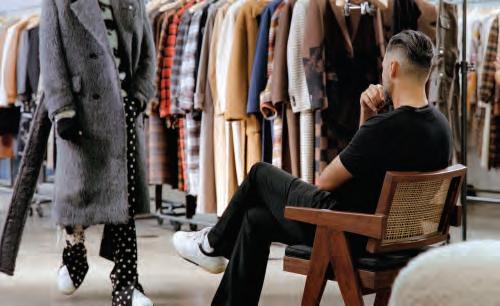
“There is a dream here that people relate to... if you look at California, Hollywood, Beverly Hills, this is where people come to chase something bigger than them.”
- Mike Amiri
“If you are not from here, it means something different to you, and something a bit more romantic. When I go to Italy and people learn I’m from L.A., they say, ‘Oh my God, Los Angeles. It’s my dream.’ I think that reaffirms that we represent something here. There is a dream here that people relate to. I mean, if you look at California, Hollywood, Beverly Hills, this is where people come to chase something bigger than them. There’s so much that it represents, opportunity and optimism. And I always ask myself, ‘What does that look like in clothing? What does that look like on a runway show? How does that feel and why?’”
Mike wanted to set himself apart from the European brands by telling a story that was authentic to his experiences. He posited, “‘Why don’t I bring an authentic California cool to the market? Why don’t we use just as good fabric, just as good sewing, with the same coolness and DIY approach?’”
It was a bullseye for Mike.
“I bring the perspective of someone who is from the city, who knows what it feels like to be from California. There’s a certain romantic notion about a T-shirt and jeans in California. How do they feel? They’re soft, they’re worn in. Your T-shirt might have a little bit of sun fade. There’s a certain color palette associated with that. It allows people who are in Europe, when they buy it, to feel like they’re getting a little piece of California.”
Mike began to filter everything through this California lens, and eventually, it became part of the DNA of the brand.
“I deconstruct suits so they’re super comfortable. It almost feels like you’re wearing a T-shirt because that’s the weather we have here. In L.A., you can go to lunch at 3 p.m., and still go to dinner at 7:30 p.m., wearing the same thing. How would you do that if you were wearing a stiff suit? There’s a certain comfort level associated with this California dream.”
AMIRI jeans are a perfect example of the brand’s distinctive identity. At a time when most designers shied away from men’s skinny jeans, believing their silhouette was too feminine to catch on, Mike ran headlong into the challenge. Using stretch-infused fabric, his jeans became known for their extremely comfortable, yet super tight fit. When he introduced them into the marketplace, AMIRI jeans quickly became identifiable and extraordinarily successful.
Mike lasered in on his brand’s identity, “Modern luxury through a California lens” he proudly exclaims, adding “The plan was always to have an American aesthetic.”
When he was ready, Mike approached the trendsetting, iconic fashion retailer, Maxfield, in West Hollywood. He convinced the owner to stock a few of his designs. He then spent an inordinate amount of time with the salespeople on the floor learning about his new customers.
Mike would ask himself, “Who was this guy? An artist? A performer? An athlete? And as I would design, I would imagine that person a little bit more and put my creative spin on these heroes. And it went from six pieces, to eight pieces, to 15 pieces, to 20 on the rack. And it wasn’t selling anywhere else in the world. If you wanted to buy that product, you
could discover it on social media, or you could discover it in Maxfield, alongside some of the best work in the world.”
The hype around the collection was largely built on social media. Knowing this, Mike fully utilized these platforms, which he credits as immeasurably responsible for launching his brand.
“Social media helps democratize what talent can shine. If you look at the traditional fashion world, you’re either discovered by a company, or there is an editor that will help highlight you. Or you’ve worked yourself into a sales showroom. You have to wait for someone to say, ‘Yes, I’ll give you a try.’”
Mike calls these arbiters of fashion, “gatekeepers.” While he believes they are relevant, he does not believe they control the process as they once did.
“I would never have survived in that world. For me, it was more of ‘I’m creating this piece, and I’m going to post a picture of it. And feel free to talk about it if you like it or if you don’t… And if you like it, you can buy it here...’”
By interfacing with the customer, Mike found a more direct route to market his brand. He spoke to a new generation who could check out his post and see, for example, what a designer’s daily activity entailed. In so doing, he created a genuine relationship with his customers, one with complete transparency. They learned about the AMIRI artistic approach combining traditional, delicate, exquisite European craftsmanship and fabrications with a DIY, innovative, garage sensibility.
After the AMIRI pieces flew out of the store, Maxfield proposed a pop-up shopping experience for his customers. Mike interpreted the offer differently.

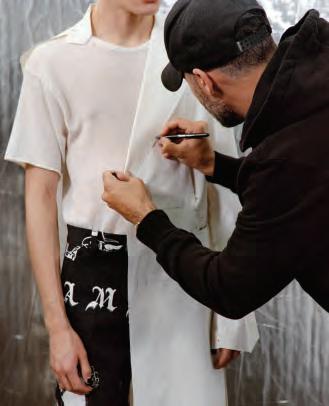
“It wasn’t like a little pop-up shop in my head. It was my first retail store. And I was going to treat it as such… This is my tester for Rodeo Drive.”
An exclusive AMIRI space, it was filled with everything from a handbag, to a hat, to pants, to a jacket. The purpose was to put together a whole outfit with AMIRI. But money was tight. Mike had to run a lean, mean operation. There were only a handful of people, including Mike, working on his designs and the development and production of the goods. Despite the young brand having never done this before, it sold out nearly $300,000 of merchandise in just three hours.
“It was really organic… but a painstaking process from beginning to end. The product was so detailed and thoughtful and took forever to make. When it got to the rack, it was a bit undeniable.”
For Mike, when it comes to the finished product, the whole isn’t greater than the sum of its parts, the whole is the sum of many great parts.
“To complete a perfect product, it’s never 50 plus 50. It’s one plus one plus one until you get to 100, every little element, from color, to fit, to fabrication, to length… All of these things make the whole. But it’s never, ‘Oh that looks great because they’re using a special sort of thread…’ Every element counts.” Later he shared, “If something is undeniably good, how can you say no?”
Mike also believes that exclusivity is the key to success in the luxury market. Another foundation is incorporating selective discipline. Early on, he exercised “restraint not to sell to a lot of people.” Maxfield, well known for being an ultra-exclusive boutique, carried AMIRI for 1 ½ years before Mike sold it to another retailer.
Barneys Beverly Hills started, like Maxfield, with only a few AMIRI pieces at first. And like Maxfield, Barneys quickly sold out. Mike replenished the small order, understanding that scarcity is a part of the successful formula. The new pieces quickly sold out again. The cycle continued, and slowly grew, with Mike continuing to make his regular recon

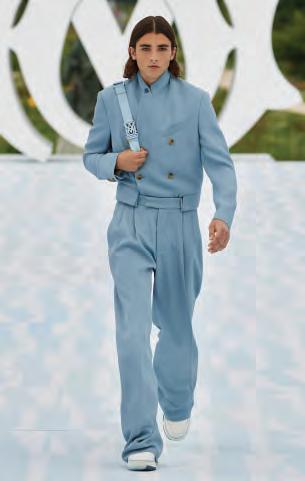
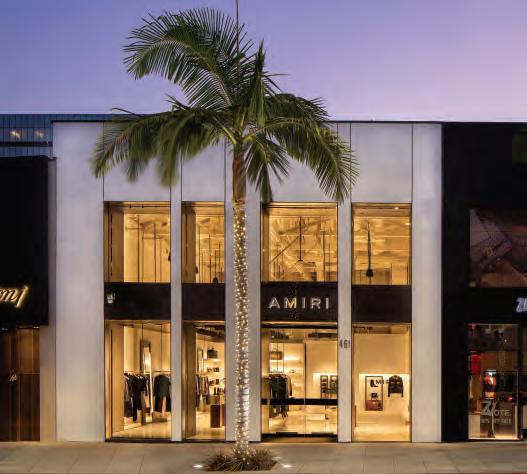
visits with on-floor salespeople to learn about his ever-expanding customer base. Eventually, AMIRI became one of the top five-selling brands for the entire Barneys company.
“My path deviated from a lot of designers where they would sell what they needed to sell to whomever would buy.”
Russ Patrick, Senior Vice President, General Merchandise Manager of Men’s, Gifts & Home and Children’s at Neiman Marcus shared, “Mike has distilled his L.A. upbringing into a distinctive look that resonates strongly with our Neiman Marcus customer. We began our partnership almost five years ago by launching the collection in our Beverly Hills store, complete with an innovative and welcoming shop-in-shop. Many years later, our customers’ desire for AMIRI continues to grow and so has its presence across our portfolio of stores. Mike’s success as an American designer, on a global scale, has been impressive and swift for a relatively nascent brand. He has shown an incredible amount of focus, thoughtfully and carefully expanding the brand’s presence and assortment, cementing his place as an influential brand in the luxury space.”
The location of the product line is another vital component in building a luxury brand, Mike believes. Birds of a feather flock together.
“[My designs] have to be with my peers. I need to sit next to Gucci. I need to sit next to Christian Dior. And some would say [referring to the brand], ‘You’re 2 years old.’ And in my head, I said, ‘There’s no difference between my art and this art.’ And some buyers would pass and regret it, and other buyers like Barneys, for example, said, ‘I’ll make that deal with you.’”
Similar to the qualities he admires in his heroes, Mike possesses strength in his conviction. Determined to win by taking control of the process and the company’s destiny, Mike was able to choose where AMIRI was sold.
“Whatever I did at Barneys, I did in Selfridges, and I did in Paris, and I did in Tokyo, and I did in every department store saying, ‘I’m not going to sell this unless it’s within a luxury context because this is of that caliber.’ And doing that around the world, little by little, it created a community that was global…The amazing thing about it is, I won’t be the last one to do this. I think this is going to be a bit of a blueprint.”
He believes many more designers, not from the traditional designing world, are going to emerge and open stores on prestigious streets around the world like Rodeo Drive.
The international fashion entrepreneur and connoisseur, Renzo Rosso, founder and Chairman of OTB (Only the Brave) fashion group based in Italy with companies including Maison Margiela, Jil Sander, Marni, Diesel and a minority stake in AMIRI, states, “AMIRI is something

PHOTO BY DANIELLE LEVITT; GROOMER: NATASHA SEVERINO/FORWARD ARTISTS
unique. Mike is an absolute genius, and he has been able to create a brand, which has a soul, a distinctive voice and is recognizable among all the others. The project Mike had in mind and what he wanted to do were the factors that led me to believe in the project and invest in it.”
Mike has a consuming passion for his brand, but it’s not the only love in his life.
Married 14 years to his beautiful wife, Shirin, he is the proud father of three, daughter Kayla and sons Ryan and Jordan. Having to balance his business with his family life has forced him to make some hard choices, even sacrifices with respect to spending time with his children.
“I think in the beginning, when you’re building something so grand, you have to be obsessed with it. It is one of your children, as well. I don’t think there’s any way to do anything so big if you’re not completely obsessed. When they were younger, they did remind me of the things that I have missed. But once the foundational work was done in the company, I was able to balance out my time much, much better. And also include them in my world. It’s not really a sore subject anymore. They hardly ever bring that up. They have a pride in understanding that I was able to do something that’s very rare and uncommon.”
Rosso added, “Mike and I also have a strong personal tie, and we try to spend some leisure time together with our families during the year. We share our perspectives, ideas and experiences, and I feel these are very meaningful moments for both of us. I strongly believe that family is a source of inspiration and positive energy for Mike; this is one of the most important values for him, and it contributes to his extraordinary creativity and passion.”
After Mike’s bow at the AMIRI Spring-Summer 2023 Paris runway show in the Jardin des Plantes, his children, along with Shirin, leapt out of their chairs and spontaneously rushed to their daddy to congratulate him.
“The thing I heard most from people, ‘My favorite moment in any fashion show was watching your son jump out of his seat and come hug you.’ I heard that so many times. It’s really great that the sacrifice was both theirs and mine. And the celebration is both theirs and mine.”
For Shirin as well, she’s been a part of AMIRI from its inception.
“I always tell people to surround themselves with people who reaffirm who they see themselves as. When we were first building this,” Mike continues, “Our friends were all professionals with professional careers. I was an artist. I never felt I was a small artist. I always felt like I was more than I was at that time. Shirin made me feel that way. There has
never been a difference between then and now. Not having even 100th of what we have now.”
The AMIRI’s aspirational scope has continued to broaden, thanks to Mike’s ingenuity and forward thinking. Presently, the company designs in the California chic, relaxed, luxury space and not only for men. Forging paths and winning awards, Mike has led his company into footwear, womenswear, eyewear, childrenswear and lifestyle accessories, including leather goods and handbags.
Where does Mike find inspiration?
“When I first started making pieces, and they were stage pieces for singers, and these were the frontmen of bands, there was something heroic about them that you wanted to connect to in the clothing. Whether it was shaped a certain way, where it moved a certain way, where it shined a certain way. And I think [by] taking that sensibility and bringing it to the street level, you don’t have to be a rock star to create that feeling of specialness, the confidence somebody can get from clothing. And so, when I’m drawing characters now, when I’m thinking about runway shows, I always say, ‘Who’s my hero this season? Where is he going? What era is he living in? How do I make that touch back to today? What would he look like today?’ When I make sportswear or tracksuits, I look at Michael Jordan. I look at the swagger he carried. I look at the length of his shorts or the fact that his cutoff T-shirts stuck out an inch farther than his shoulders and how it created a strong shoulder silhouette.”
Similarly, Mike describes the “AMIRI woman” as a hero, her own hero. He thinks of the male hero and the female hero as the same person.
“She carries that same shining glimmer that I want the guy to have on stage. She has the confidence, the femininity, but has enough strength to wear things that are traditionally masculine silhouettes.”
Mike designs a lot of tailoring for women, like oversized suiting, while keeping the same principles of ease, comfort and luxury.
“I just love the way a woman looks when she empowers herself in something nontraditional. There’s a certain strength to that. And it came when I started opening stores and noticing the women who would come with the men customers, grab [a] blazer and throw it on. And I’m like, ‘Oh, she wore that. That was hers.’”
He also describes the AMIRI woman as confident, irreverent and effortless. With the completion of two full women’s collections under his belt, including women’s footwear and accessories, Mike believes he
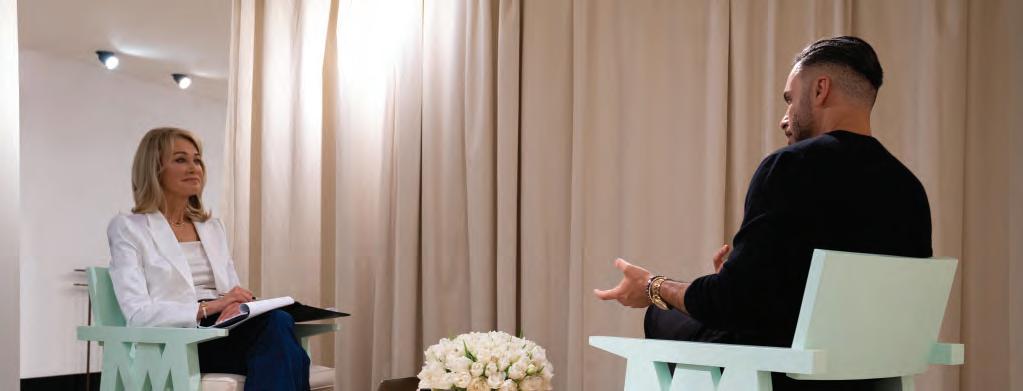
is on the right path.
But will the women’s footwear match the success of the men’s footwear division? In total, today’s AMIRI footwear is almost 20% of the entire business. Again, Mike did not develop the footwear division traditionally by attaching a sports influencer to market the product. Instead, Mike forged his own path.
“Like our skeleton low-top sneakers, it feels like a casual sporty silhouette. But when you touch it, the leather is a true luxury leather, and the lining is luxury. And then the inside of the shoe feels like you’re on pillows. It almost feels like the details of a handbag. And the art on [them] was really just created from things we did as skaters where you would write and draw bones on your shoes. So, it’ll have the juvenile sensibility of the bones, but the execution of a luxury house.”
Once again, Mike follows his authentic, creative formula, staying within the boundaries of the brand’s identity.
“There’s something special about using creativity more than capability. The second you lose the magic you had when you were by yourself in a garage or a basement is when the shine starts to dull.”
To keep on the pulse, Mike welcomes collaboration. This is evident from his unique partnership with the contemporary American artist, Wes Lang, for AMIRI’s Autumn-Winter 2022 Menswear and lifestyle collections. Mike was attracted to Lang’s pedigree. Having established his first workspace at the Chateau Marmont, Lang built a global name for himself and shares Mike’s innovative approach. Their collaboration is thought of as an exploration of the city’s aesthetic heritage, reflecting the intersection of the worlds of rock, skateboarding, luxury, craft, art and glam — that defines Los Angeles.
Mike looks to create a buzz with his collaborations, to create something from two minds that would not exist otherwise. He hopes to do many more in the future.
Of all Mike’s accomplishments, he’s most proud of his efforts to pay it forward.
“I’m fully aware, and I’m in awe every day that we get to do what we do. But the purpose has to be more than building something really big for yourself.”
Thus, he created the AMIRI Prize. It’s a $100,000 award for the winning entrepreneurial designer who is granted a company-wide mentorship to help the winner understand the trappings of designing a brand. The award provides full transparency into AMIRI’s successfully executed infrastructure. Most importantly, it enables a young, talented designer to create and execute a business plan.
“The big purpose of AMIRI is not to be the independent designer who created a luxury empire. It’s to be an independent designer who helped spark a bunch of other independent designers to create a new generation of empires. I think that’s the thing that excites me the most.”
Promoting empathy is meaningful to Mike. This past January, he chose to bring awareness of the social injustices occurring in his family’s
native Iran. Following his Paris Fashion Week show, he appeared at the end of the runway in front of the most influential fashionistas in the world, wearing a black T-shirt that read in bold letters, “Woman, Life, Freedom.” It seemed fitting as the platform was fashion, and the social injustice issue was ignited around traditional clothing.
“I felt a responsibility to use that opportunity to shed light and awareness, that whatever picture is going to be of me that will go around, it’s going to make a statement that either educates people on what’s going on or tells people that ‘I feel you; I understand; I’m aware.’ Maybe there’s a part of it that we don’t have power in changing things physically, but we do have power in creating awareness and acknowledgement.”
So, what’s next?
“I’m just dreaming bigger. I always thought that you think big until you make it happen, then you realize there’s something actually bigger that is in front of you, and you go at that, which seems impossible, but you make it happen and then you dream even bigger…”
Mike’s well-versed in dreaming. He’s been doing it his whole life.
“You have to [dream] because the end goal is not the reward. The reward is the journey along the way, and as soon as you think you’ve reached somewhere, that means your journey has stopped. So, for me, it’s always something else because I’m obsessed with creating this path and this journey, and I don’t want there to be a finish line.”
Odds are, there will never be a finish line for AMIRI.
At the end of our interview, Mike walked me back through the store, continuing to answer questions about his designs hanging about. I listened to him proudly describe the workmanship in every item my eyes landed on, pointing out each exquisite detail and the California cool feeling it connoted.
As I pushed the front door open and was instantly transported back into the black-and-white gloom of the day, I found myself in awe of the world Mike has created.
What’s astonishing is it was born from the boundless imagination of an intrepid teen, who haunted the rock clubs of Hollywood and the hallways of Beverly Hills High, and ended up on the runways of Paris Fashion Week.
His rise to the top was unorthodox. He rejected the standard career trajectories dictated by the fashion industry elite, skirting around the whims of editors and buyers, and chose instead to appeal directly to the masses. His monumental success in carving out his own space, on his own terms, within the luxury retail market has made him a unique visionary. And in the process, he’s created a road map for other aspiring young designers around the globe to follow.
Mike turned a dream in a basement workspace off of Sunset Boulevard into an international luxury fashion house with a gleaming flagship storefront on Rodeo Drive. He did it his way. And if you ask him, he’ll tell you, he’s just getting started.
Last year, the Beverly Wilshire, A Four Seasons Hotel underwent a multimillion-dollar renovation of its guest rooms, suites and corridors. The refresh included the addition of new artwork, which included pieces sourced from the international collective Art Squared, line drawings by David Cantu, and abstract paintings by Alison Cooley, among others. But you don’t have to book a Presidential Suite to peruse the crown jewels of the hotel’s collection.
As soon as you walk into the lobby, you’re greeted by two mesmerizing, oversized panels—one a glowing amber and the other smoldering crimson—by Jason Young. The Canadian artist attended the USC Roski School of Arts and Design before completing his classical training at the prestigious Sorbonne in France and various apprenticeships with internationally recognized Masters. For the pieces commissioned by the hotel, he used mirrors, hundreds of thin layers of resin and highly reflective auto-body lacquer to create their mercurial effect. The panels, each weighing 400 pounds, showcase Young’s high-tech, minimalist trompe l’oeil technique that has made his work so highly desirable to collectors around the world.

Inside Wolfgang Puck’s Michelin-starred CUT restaurant, five pieces from the “W/Studio 54” series by the seminal California artist John Baldessari are prominently displayed. For the series, Baldessari used vintage photos taken at the legendary New York nightclub Studio 54 and obscured faces and clothing with vibrant shades of paint. Baldessari’s work often features this redacting of photographs—from painted-over Old Hollywood stills to his dot-covered faces in found photos—they force the viewer to consider the context of the image rather than get bogged down in the details of the subjects themselves. Baldessari explained why he often revisited this concept, “It’s a cat and mouse game where I give them clues,” he said gleefully in 2012. “It’s like a great detective story where the writer leads you to think you’ve got it all figured out, then, ‘Ah hah! No, you haven’t.’” According to Hotel Manager Melissa Sims, “These are such iconic pieces, and our guests who know the series are always really impressed. Plus, it brings such a beautiful and welcomed pop of color to that space.”
In the adjacent CUT Lounge, you’ll find the work of another groundbreaking California artist, Ed Ruscha. His use of images combined with words, and later phrases, taken from everyday language made him a trailblazer of conceptual art. His works communicated a particular urban experience, where the mundane is exalted. “He Wears an Anodized Uranium Business Suit,” made of acrylic and pencil on canvas,
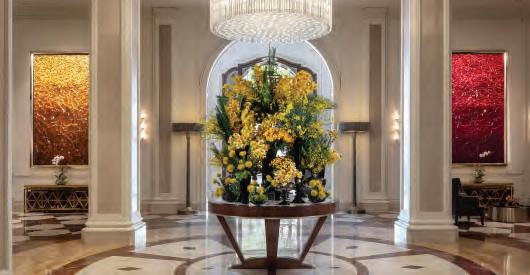
is a classic example of the artful use of text that put Ruscha on the map. Also on display are two pieces by Robert Rauschenberg, a pioneer in the Pop Art movement. While the mixed media artist is best known for blurring the line between painting and sculpture, beginning in the mid-1980s he focused on silk-screening imagery onto a variety of differently treated metals, such as steel and mirrored aluminum. He created many series of these so-called “metal paintings,” and this period in the influential artist’s career is perfectly encapsulated in the pieces “Wall Safe Flute,” made from aluminum and stainless steel, and “Palm Sunning (Phantom Series),” acrylic on mirrored aluminum.
If you get the chance to peek into Petit CUT, the restaurant’s private dining room, check out the series of celebrity portraits by Martin Schoeller. The German photographer, with his signature extreme-closeup style of shooting subjects—from the lesser known, like Death Row exonerees, homeless citizens and female bodybuilders to the uber-famous—has been lauded for his raw and honest portraits, which exude a sense of dignity, no matter who is sitting before his lens. Among the portraits of A-listers decorating the walls at Petit CUT are Brad Pitt, Denzel Washington, Anne Hathaway, Lionel Messi and Cate Blanchett. (Schoeller’s 2009 portrait of Puck greeted you at the entrance of the restaurant.) “The portraits have a certain allure to them,” said Sims. “They provide a sense of place, especially in CUT where you never know whom you might see on any given night and because we are of course in the epicenter of where the rich and famous love to play, stay and dine.”
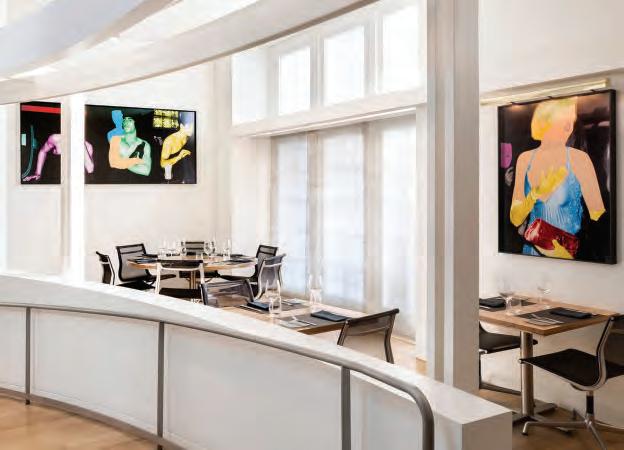
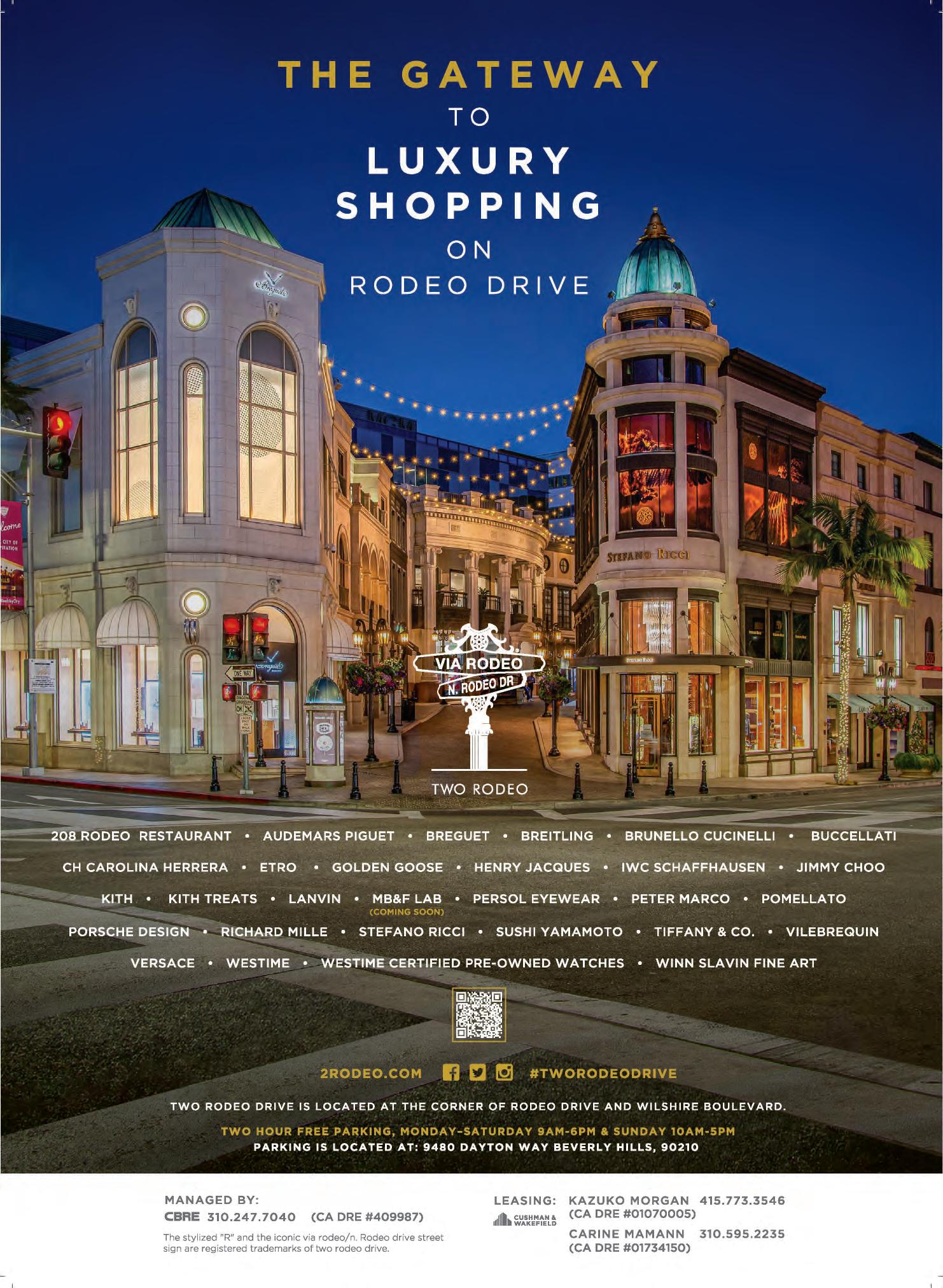

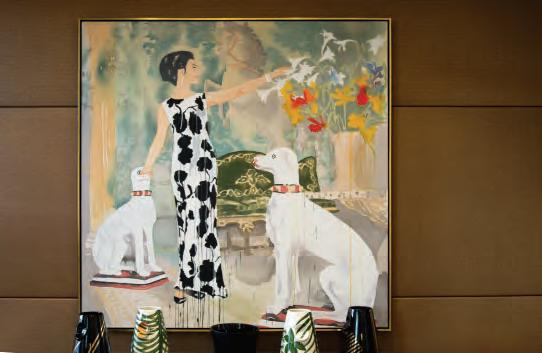
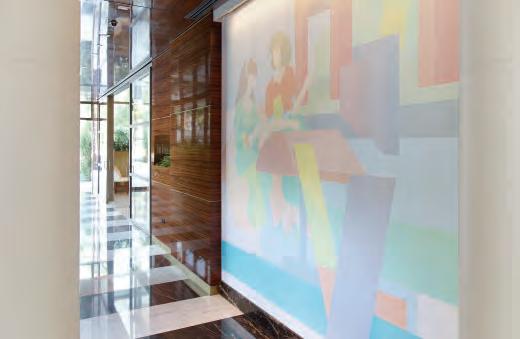
According to the Waldorf Astoria Beverly Hills, its art collection explores the synergy between the hotel and city of Beverly Hills itself as symbols of luxury and sophistication. The goal was to curate works that would feel right at home in the personal collections of its guests while adhering to a sense of place in the overarching themes—the hotel’s Art Deco decor, classical Hollywood glamour and the natural beauty of California landscapes. The result is a culmination of emerging and established international artists that speak to these themes through an expanse of mediums: porcelain, glass, paper, stone, video, photography, installation and painting.
Beginning at the reception desk, an elegant and dramatic mural by Chicago-based tile artist Jason Messinger immediately sets the tone. The glossy black ceramic tiles, each hand-carved with curvilinear lines filled with gold luster (which is made from real gold), reference L.A.’s Art Deco architecture, native plants and natural elements. Although the mural is composed of 24 individual tiles, when viewed together, they create a mosaic effect that ultimately reveals a striking abstract Los Angeles landscape.
The reception waiting area showcases a hypnotic video installation by Michael Shainblum. Featuring an array of pulsating kaleidoscopic moving images of Los Angeles, it takes viewers on a surreal, energetic journey through the city. Born and raised in California, Shainblum is known for his time-lapse and nature photography, which has garnered commissions from major corporations such as Disney, Nike, Apple and Google.
Down the adjoining main corridor, you’ll see what at first appears to be three enlarged, black-and-white movie stills from a long-forgotten film
but on closer inspection are revealed to be masterful charcoal drawings by San Francisco-based artist Oleander Wlasenko. The series, inspired by various scenes from 1960s French cinema, is thoughtfully presented in a row of black frames creating the effect of old filmstrips. Directly across the hall, in colorful contrast, is a piece by Canadian photographer Robert Canali. His signature use of photographs and pigment creates an otherworldly effect, as witnessed in the gradation of diffused hues he employed for “In Dust,” which calls to mind a burnished California sunset.
Over in the Lobby Lounge, a 16-foot wooden wall relief by Israeli artist Ofra Lapid becomes a focal point, further enhancing the overall Art Deco themes of the hotel. For the piece, commissioned in stark white and custom built for the space, Lapid explores the interplay of light and shadow using a dynamic composition with strong architectural references. Holding court in a side room is an oversized portrait of socialite Consuelo Crespi, an American-born Italian Countess, by New York-based painter Liz Markus. Part of the artist’s “Town & Country” series celebrating American female style icons, the piece illustrates Markus’ playful technique of combining paint and pencil on unprimed canvas with carefully controlled drips and washes.
As you approach the entrance to the Espelette Beverly Hills restaurant, you’re welcomed by a soft-focused pastel mural by Chicago-based artist Trek Matthews. The hotel commissioned the work asking for a piece that would speak specifically to Beverly Hills, and the result is an intimate moment of a shared lunch between two women, imagined Beverly Hills residents. Matthews is known for his strict adherence to a limited color palette using just four colors (along with white) and a style that is inspired by the precision and order of the Japanese public transit system.
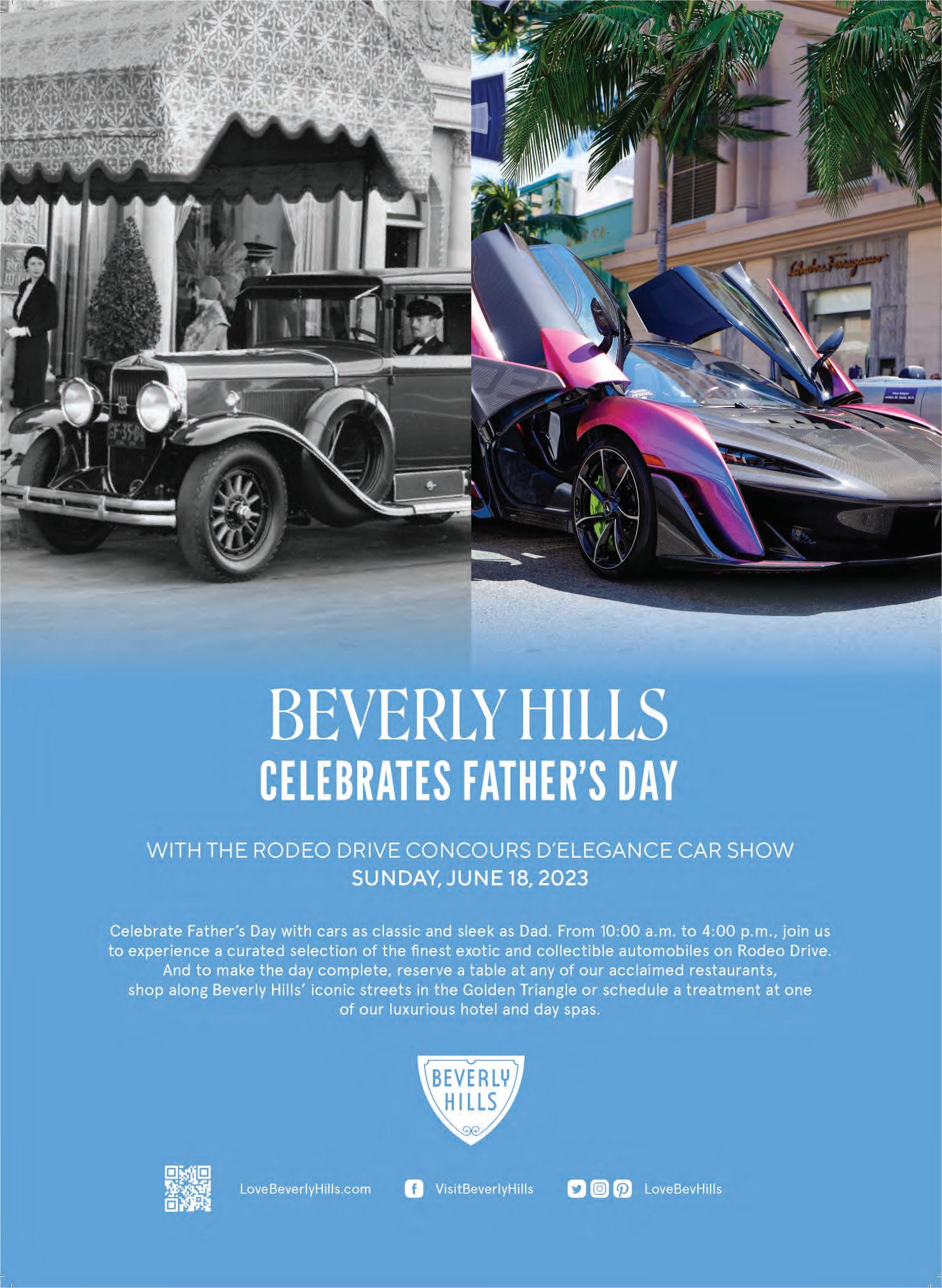
Part of the yearslong renovations to update The Maybourne Beverly Hills after it was purchased in 2020 included the acquisition of new artwork befitting the stature of a world-class luxury hotel, as well as the city of Beverly Hills as a beacon of culture and the arts. “We are very proud of the collection we have and are closely connected in some way or other to all the artists,” said the hotel’s General Manager Eugene Leonard. “Art is central to the design of our updated aesthetic for the property and hopefully provides a point of inspiration.” To that end, guests and restaurant and bar patrons are encouraged to stroll the hotel’s public spaces and take in the collection for themselves.
If you’ve ever grabbed a coffee or a sandwich to go at the Maybourne Café, you might not have realized that you just breezed past an original work by Damien Hirst. The next time you enter the café, take a moment, and look above the banquette to your right, and you’ll see a painting from Hirst’s “Cherry Blossoms” series. The cheery robin’s-egg blue sky and salmon-pink blooms seem quite a departure from the British artist’s usually dark and moody works. After all, Hirst made a name for himself with sculptures featuring dead and dissected animals preserved in formaldehyde. In the 1990s, he became one of the most sought-after conceptual artists in the world. In the early 2000s, he began to unveil his paintings. And though he has vacillated between sculpture and painting in the intervening years, he returned again to canvas in 2021, debuting his series “Cherry Blossoms” at the Fondation Cartier in Paris. The 30 paintings exhibited (which included the titular piece hanging in the café) revealed a softer side of the artist. But if you scratch just below the surface, “Cherry Blossoms” reveals its connection to the central themes of Hirst’s work. He explained, “The ‘Cherry Blossoms’ are about beauty and life and death. They’re about desire and how we process the things around us and what we turn them into, but also about the insane visual transience of beauty—a tree in full crazy blossom against a clear sky.”
Hanging on the columns of the arches at the café entrance are two watercolors from the “Vespers” series by Brian Clarke. A world-renowned, large-scale, stained-glass artist, Clarke has been lauded for his achievements and innovations in that medium. In the 2000s, nature became a central theme in his work, and the British artist branched out with a series of botanical oil paintings and watercolors. In 2021, he debuted “Vespers,” a series of watercolors depicting poppies, at Phillips gallery in London. “Poppies are the most fragile, the most delicate and vulnerable of flowers,” said Clarke. “The petal is so thin that it transmits light. Light doesn’t fall on it and bangs off in a reflective nature like it does with most flowers; it passes through it. And, of course, that makes it in my mind, very like stained glass.”
Inside The Terrace, you can’t miss the giant mural along the back wall with its lively shapes and squiggles in bright primary colors by

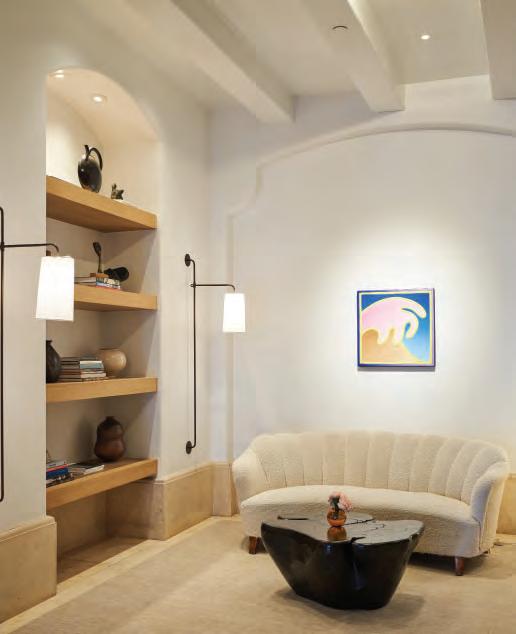
L.A.-based artist Jessalyn Brooks. Drawing inspiration from the geometric lines and blocks of the Cubism movement led by Pablo Picasso and Georges Braque, Brooks’ work focuses on abstract depictions of full-bodied female forms, which offer contemplation on beauty ideals and gender.
Take a detour through the lobby to discover more. Behind the reception desk, a painting from the “Twitchy Collection” by Harmony Korine is on display. Korine might be best known for his gritty screenplays including the ‘90s cult classic “Kids,” directed by Larry Clarke and “Spring Breakers” (starring James Franco and Selena Gomez), which he directed. But Korine, who has been painting since he was a teenager, is also a bona fide fine artist in his own right. His technique starts with photos taken on his iPhone, digitally altering them, and later reproducing the images using household objects such as pieces of duct tape and steak knives in lieu of brushes to apply oil paint to canvas. Dubbing his style “mistakism,” Korine’s work has been celebrated for its raw, roughhewn qualities, much like his films.
Nearby, “The Wave” by Alex Israel occupies a quiet nook. The L.A. native creates multimedia pieces that often reference his hometown, taking in elements from the film industry and surf culture. “The Wave” is an homage to Japanese Edo period artist Hokusai and a nod to kitschy surf brand logos. Made from acrylic stretched over fiberglass, its construction references the act of pulling on a wetsuit.
An electric-blue, aluminum surfboard by Australian artist and influential designer Marc Newson is the latest addition to the hotel’s collection. For Leonard, the bold piece is among his favorites. “I admire the audacity of the piece, to create a surfboard out of metal,” he said. “And to then ask Garrett McNamara (the founder of big wave surfing) to test it on some of the world’s largest waves, conjures up the real sense of danger that exists with surfing huge waves and the natural sense of place surf culture has long had in California.”
The cobalt blue circle emblazoned with the word “California” spiraling toward its center is a piece the hotel commissioned from artist Aaron Young. It’s meant to mimic a traditional motorcycle club patch and represent the collective kindred spirit of the hotel, inviting guests to “HELEN
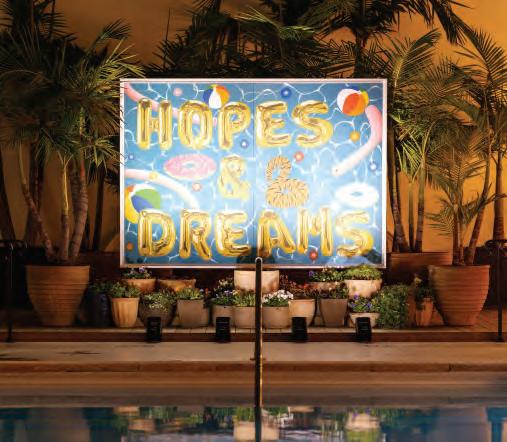
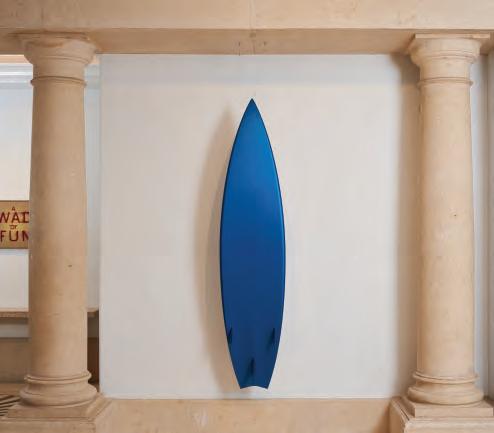
join its “club.”
On a marble pedestal sits a sculpture of stacked colored balls by multidisciplinary artist Annie Morris. Titled “Stack 8,” it’s part of the British artist’s critically acclaimed “Stack” series, in which she examined her grief for her stillborn child.
In the lobby corridor, an enigmatic sculptural collage, “Helen and Sunnyside,” by Tony Berlant seems to float above the space. The Santa Monica-based artist was an integral part of the West Coast Pop Art movement in the 1960s. His paradoxically flat-yet-relief-like works, created by laboriously printing images (many of which he took himself) onto metal, which is then cut into pieces and reassembled and affixed with nails onto various found objects, earned him a place in the permanent collections of the Los Angeles County Museum of Art and the Art Institute of Chicago.
Head down the hallway back toward the café, and you’ll come upon a charcoal and oil painting by celebrated Johannesburg artist Nelson Makamo. His portrayals of rural South African youth have recast the
way African children have long been depicted as disenfranchised and impoverished. And this piece, “Appreciate Beauty,” radiates the central tenet of his work, optimism. In 2019, Makamo’s work was chosen to illustrate the cover of Time magazine’s “The Art of Optimism” issue, guest edited by powerhouse filmmaker Ava DuVernay.
Up on the rooftop, check out the inspirational piece by L.A.-based artist Joel Mesler in the recently opened restaurant Dante Beverly Hills. The former art dealer quickly drew a following when he began painting in 2015. His whimsical works, drawn from childhood memories, often center around words or phrases and feature flora and fauna motifs. For the piece, “Hopes & Dreams” for the hotel, Mesler imagined gold Mylar balloon letters spelling out the title’s words suspended over a sun-dappled pool filled with colorful floaties and beach balls. “We commissioned the piece to reflect our new restaurant atop our stunning rooftop overlooking the hills and iconic Hollywood sign,” said Leonard. “‘Hopes & Dreams’ felt like a natural fit for the space, in the middle of the world of entertainment.”

“It’s a beautiful example of how a mostly undeveloped park in the middle of the largest metropolitan area can bring balance and harmony.”
- Fernando Castrejon, Franklin Canyon’s Park Manager
The area was previously owned by oil baron Edward L. Doheny, who mainly used it to graze and water his large herd of roaming cattle. Doheny sold large swaths of the land to the city of Los Angeles for the water project, reserving a portion in lower Franklin Canyon for a summer retreat. The Doheny family later built a Spanish-style home there in 1935.
Franklin Canyon remained unchanged for decades, until the Sylmar Earthquake in 1971. Measuring 6.7 on the Richter Scale, the quake caused extensive damage throughout the San Fernando Valley and near full collapse of the Lower Van Norman Dam. After the city and the DWP held a system-wide survey of its dams and reservoirs, the Franklin Canyon Reservoirs were deemed at high risk for failure. The lower reservoir was emptied completely, and the upper reservoir level was lowered by 15 feet. A modern reservoir and surge dam were constructed below the Doheny Ranch as a replacement. With the upper reservoirs decommissioned and the Doheny Ranch properties slated for sale, the once-protected Franklin Canyon was open for development.
However, conservationist Sooky Goldman and Congressman Howard Berman stepped in and encouraged the DWP and the National Park Service to instead turn the land into a park. And in 1981, The National Park Service purchased the Franklin Canyon Ranch, incorporating it as part of the Santa Monica Mountains National Recreation Area. That same year, the William O. Douglas Outdoor Classroom—named after the Supreme Court Justice and environmentalist known for his eloquent speeches urging the protection of America’s wildlands—opened its doors and began offering educational programs to the public and local schools, which continue to this day. The non-profit’s two-hour, docent-led discovery hikes and field trips introduce 10,0000 underserved youth to Los Angeles’ natural resources each year.
The Mountains Recreation and Conservation Authority manages daily operations today, including the park’s Eugene and Michael Rosenfeld Auditorium, the Sam Goldman Amphitheater and the Sooky Goldman Nature Center, where you can grab a snack and check out exhibits on native plants and wildlife.
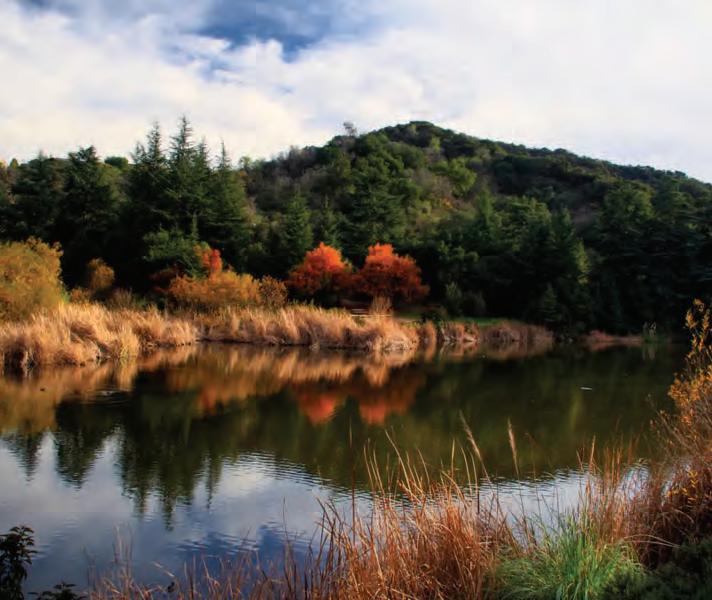
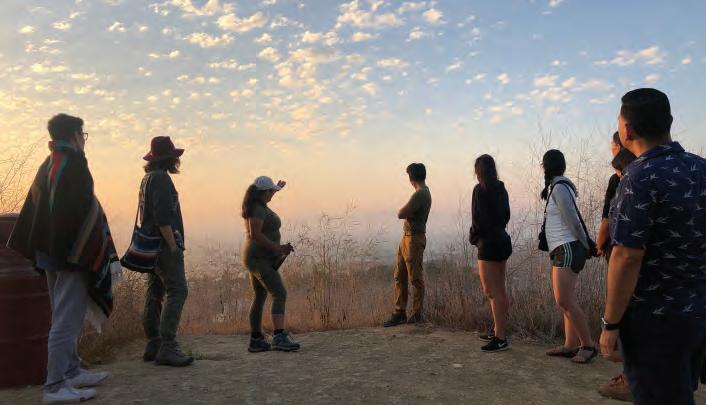
“The 605 acres of Franklin Canyon offer visitors a respite from the city,” said Fernando Castrejon, Franklin Canyon’s Park Manager. “It’s a beautiful example of how a mostly undeveloped park in the middle of the largest metropolitan area can bring balance and harmony.” For park updates, events and public programming, follow @mrcaparks or @franklincanyonpark on Facebook or Instagram.
Adjacent to Franklin Canyon, on a ridgeline straddling Studio City and Beverly Hills below, lies Coldwater Canyon Park, a Certified Wildlife Habitat by the National Wildlife Federation. Sprawling 45 acres, the park’s numerous trails, shaded by lush tree canopies, traverse sage-covered hillsides leading to sweeping panoramic views of the San Fernando Valley.
Not to be confused with the lovely, little, five-acre community park along Beverly Drive with the same name, this Coldwater Canyon Park is owned by the city of Los Angeles but maintained and operated by TreePeople, based in Beverly Hills. (Though if you want to split hairs, it’s technically Beverly Hills Post Office.)
This year marks the 50th anniversary of TreePeople. A little more than half a century ago, 15-year-old camp counselor Andy Lipkis learned about the dire state of Southern California’s trees from a visiting U.S. Forest Service ranger during an educational camp lesson. Back then, the Los Angeles basin sat under a threatening and permanent haze of smog, so thick it limited visibility and “stay indoors” warnings were a daily part of life. Lipkis was horrified to hear that this air pollution was killing local trees at such a rapid rate that all of the area’s forests would be gone forever by the year 2000—unless smog-resistant trees were planted to replace those lost.
Lipkis quickly mobilized a group of like-minded teens, and together they raised thousands of dollars and spent the next summer planting 8,000 trees in the San Bernardino National Forest. Though the group became incorporated as the California Conservation Project in 1973, locals insisted on colloquially referring to them simply as “the tree people.” The name stuck, and a year later they took on the moniker, officially renaming their organization TreePeople.
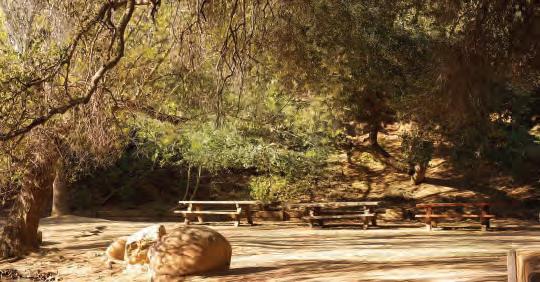

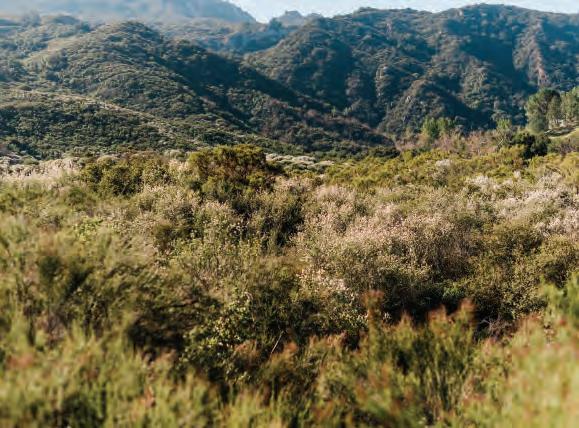
In the decades since its inception, TreePeople has engaged and inspired millions of people to act on behalf of our native trees—planting millions of saplings, replanting after wildfires, turning concrete slab schoolyards into shaded green spaces and donating fruit-yielding varieties to food-scarce communities.
From its base in Coldwater Canyon—which over the years has grown to include the S. Mark Taper Foundation Environmental Learning Center, S. Mark Taper Foundation Amphitheater, W.M. Keck Foundation Nursery and a Yurt Village—TreePeople continues its commitment to educating the public. Community outreach is done through a wide variety of programs such as hands-on workshops covering topics like composting and rainwater capture and volunteer-led educational hiking tours.
Through its partnerships with area schools, 10,000 students visit TreePeople each year to learn about nature and the importance of caring for it. “For many of them, it’s the first time they’re in nature, and the impact that experience has on them lasts for a lifetime,” said TreePeople CEO Cindy Montañez. “And there are no special tricks; when you expose a child to nature, or even an open space in an urban setting, the connection automatically happens—you see them light up, their minds become more curious—[and] hopefully changes the way they understand the natural world.”
While you’re free to park in TreePeople’s designated lot at the intersection of Coldwater Canyon and Mulholland Drive and explore on your own (trails are clearly marked with signage), the non-profit’s guided hikes offer a next-level, immersive experience.
Every first Saturday of the month at 10 a.m., the free Story of TreePeople Tour makes its way around the facilities and park surroundings. It’s guided by a volunteer who will point out various on-site conservation practices while regaling you with tales of the organization’s history and sharing its plans for the future.
Looking to reconnoiter with your furry loved one? Sign up for the hour-long L.A. Lookout Adventure Tour and bring your pooch (must be leashed) along on a guided hike along the trails. You’ll learn about the flora and fauna that surrounds you as you go. The tour is held on the second Saturday of every month at 10 a.m. and costs $5 per person.
For a truly unique experience, grab a flashlight and take the Moonlight Hike Tour to explore Coldwater Canyon (and neighboring Wilacre Park) after dark. Weather permitting, the hike takes place on the third Friday of every month, starting at 6:30 p.m. It’s free for members (and up to three guests) and $5 per person for non-members. Hikers of all ages are welcome, and there are three different experience levels offered: “Relaxing Stroll,” a slow-paced leisurely amble along even ground, perfect for young children; “Brisk Walk,” which includes a hill challenge with city views at the top; and “Trek Hike,” a two-mile power hike with elevation gains that will leave you breathless by the time you get to the stunning panorama revealed at the summit. During each, your
guide will pepper you with fun facts about the park and its wild inhabitants, while you gaze at the stars above and take in the twinkling city lights below.
Sign the whole family up for the private, one-hour Family Tour and walk the trails with a TreePeople educator who will teach you how to identify native plants along the way. You’ll also pop by the resident Dirt Doctor’s laboratory, learn about the magic of mulch, be treated to live demonstrations and interactive displays on topics like rainwater flow at the urban watershed garden and plant a tree seed to take home. The cost is $10 per person (there’s a 10-person minimum). The private tour, which must be booked in advance, is offered Monday through Saturday, with two separate sessions available, either 10 a.m. to 11 a.m. or 12:30 p.m. to 1:30 p.m. Bring a packed lunch and picnic on the grounds before or after the tour. You can also add on an optional 30-minute nature craft activity and make leaf rub journals or clay air fresheners for an additional $50 group fee.
A public version of the Family Tour, minus the optional craft activity, is held every fourth Sunday of the month at 10 a.m. and is $5 per person (free for children 4 years old and under).
If hiking isn’t your thing, you can still take in the beauty of the surroundings while you take in a summer concert at the S. Mark Taper Foundation Amphitheater. Follow @treepeople on Facebook for updates on programming.
All proceeds from these performances, as well as the guided tours, go to TreePeople’s maintenance of the 45-acre park. This revenue is one of the organization’s principal sources of funding, besides donations and memberships. For information on the non-profit’s monthly membership program, visit treepeople.org/canopy. Membership comes with all kinds of perks, including exclusive access to future TreePeople experiences and events. To make a donation, visit treepeople.org/supportus.
One of the best ways you can support the organization, especially during the summer season when it’s crucial to provide trees and plants with water to ensure they survive the heat, is by volunteering. Various volunteer-driven events are held every weekend. For more information, visit treepeople.org/volunteer. “People get to work together to make a tangible difference in the world in real time,” said Montañez of the organization’s volunteers. “Trees aren’t political. In fact, [they’re] a unifying force for communities…Where else can you work with a loved one and a complete stranger on the same day and plant a tree that will last for decades to come?”
With so many options to go into the wild nearby, you can hit the dusty trails —without ever leaving the city.
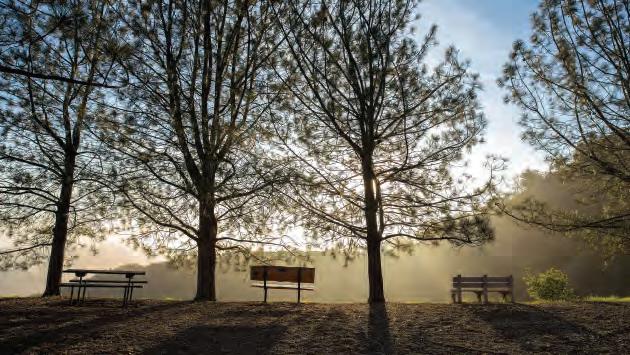
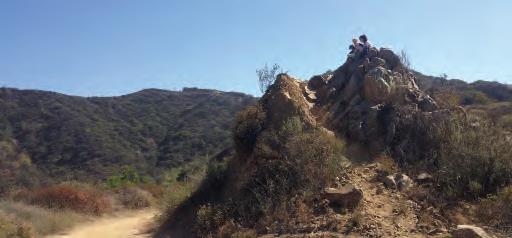
2600 FRANKLIN CANYON DRIVE
310-858-7272
NOTE: Franklin Canyon Park north entrance (Mulholland/Coldwater) is closed due to hazardous conditions from recent storms. South entrance (Beverly Drive) is open.
Popular Hikes:
Discovery Trail: An easy 0.3 mile stroll that loops through the black walnut woodland along the canyon bottom.
Hastain Trail: A moderate to strenuous 2.3-mile, round-trip hike. Rising steadily on a fire road through a chaparral-covered slope, you will arrive at an overlook offering views of the lower canyon, West Los Angeles and, on a clear day, the Pacific Ocean. From there, the trail drops down to a single-track trail to the lawn at the ranch area next to the old Doheny house.
Berman Trail: This 1-mile, moderate to strenuous hike to Mulholland Drive allows you to hike across the Santa Monica Mountains from Franklin Canyon to Coldwater Canyon Park and Wilacre Park.
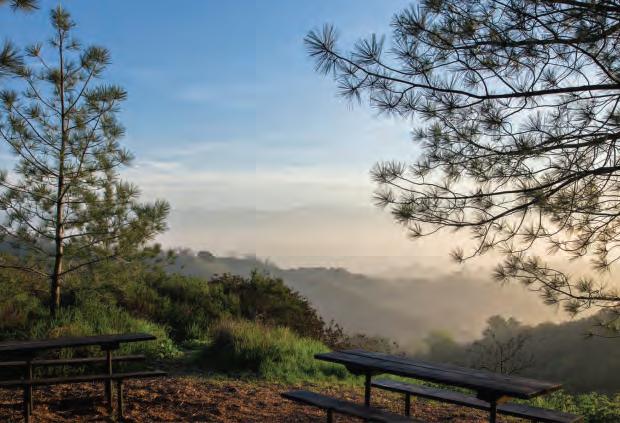
12601 N. MULHOLLAND DRIVE
818-753-4600
Popular Hikes:
Oak Trail: A short trail for beginner to intermediate hikers who just want a nature stroll while at the park. Oak Trail ends where it intersects with Betty B. Dearing Trail, which will take more ambitious hikers into Fryman Canyon.
Betty B. Dearing Trail: A 5-mile, out-and-back hike. It gets pretty rugged and steep in places so be mindful of your shoe choice. Bring water.
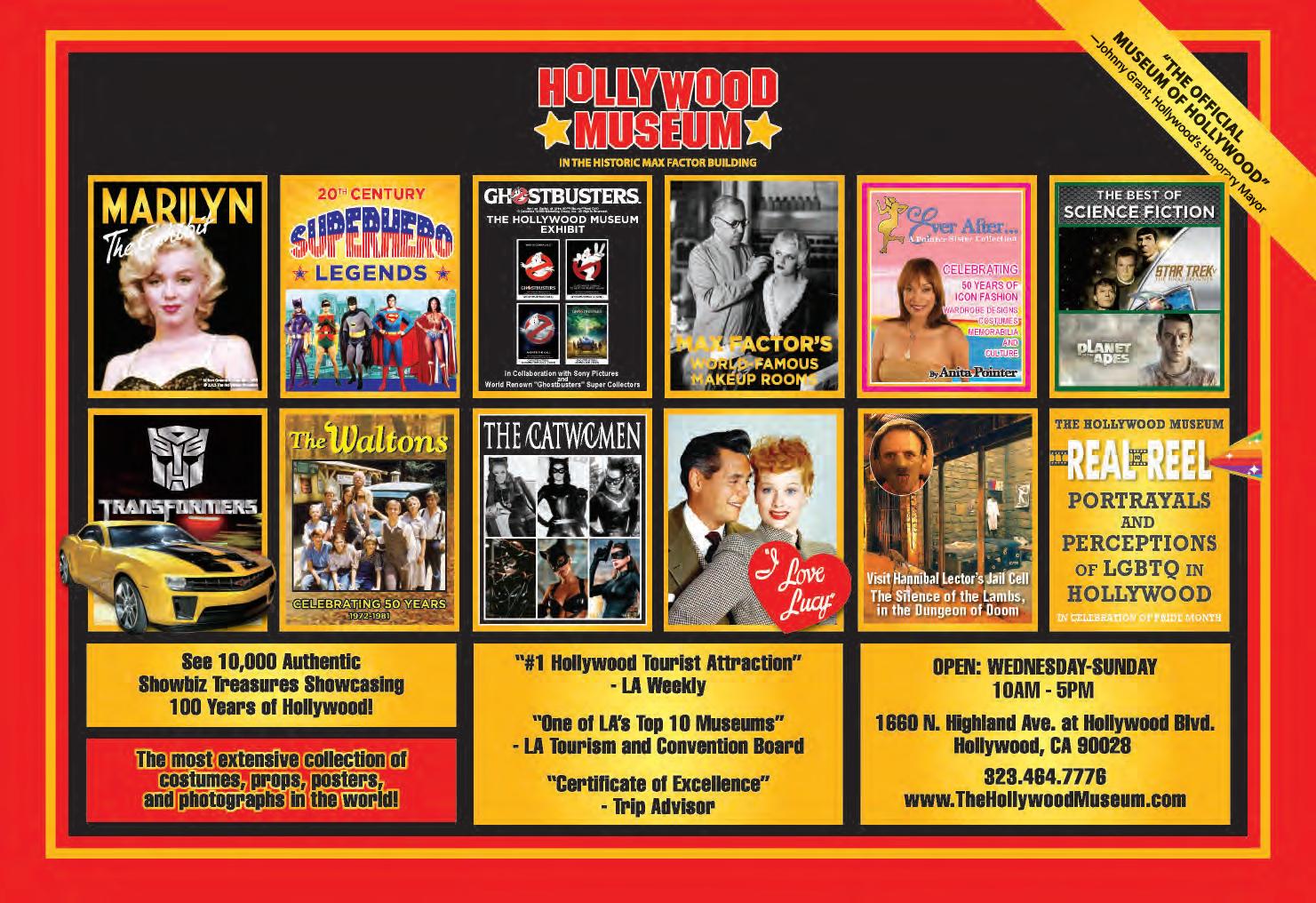
“Mission: Impossible—Dead Reckoning Part One” is the much anticipated latest chapter in the Tom Cruise “Mission: Impossible” franchise. Directed and written by the redoubtable Christopher McQuarrie (“Top Gun: Maverick,” “The Usual Suspects”), expect stunts, explosions, thrills and spies. Repeat appearances, besides Cruise, include Ving Rhames, Simon Pegg, Rebecca Ferguson and Vanessa Kirby with the added punch of the exquisite British actress Indira Varma and the too-under-the-radar Esai Morales. With Part Two opening in 2024, Cruise will have played Ethan Hunt for 28 years! Of course, that pales in comparison to the 42 years that Harrison Ford has been associated with Indiana Jones.
“Theater Camp” mashes together summer camp for musical nerds, complete with energetic dancing, singing and the faux drama of (gasp) shutdown when the founder (played by Amy Sedaris) goes into a coma, and the camp must be rescued from her clueless brother by the teachers, one of whom is the adorable and extremely talented Ben Platt.
“Barbie,” need we say more? Barbie has been booted from “Barbieland” for not living up to the Barbie standards. She embarks on a journey into the human universe to find happiness. Directed by Greta Gerwig and written by Gerwig and Noah Baumbach, one can only hope that Barbie and Ken, played by Margot Robbie and Ryan Gosling, have their tongues firmly implanted in their cheeks. Loaded with star power that includes Helen Mirren (who is in no fewer than four summer releases), Will Ferrell, Michael Cera and Simu Liu.
“Oppenheimer,” written and directed by Christopher Nolan, is that rare film for adults premiering during the summer. It explores the conflicts faced by J. Robert Oppenheimer as he sets about creating the atomic bomb while trying to manage the political and global ramifications of this weapon designed to end World War II, weighing its potential to do great harm to the future of humanity. This is an IMAX-shot thriller that brings you into the pulsing immediacy of decisions with grave consequences, spies and petty politics that have the possibility of turning friends into enemies. A top-notch cast is led by Cillian Murphy, Emily Blunt, Matt Damon, Robert Downey Jr. and Rami Malek.
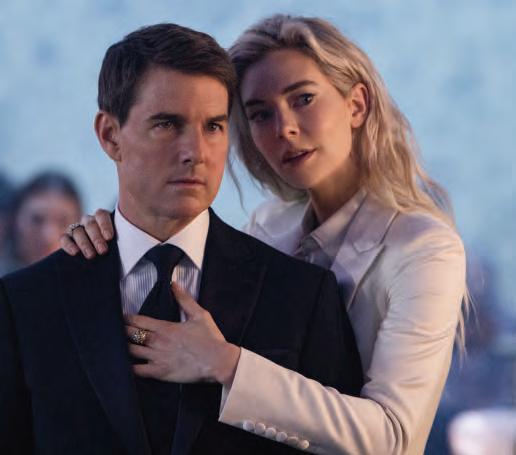
28
“Haunted Mansion” is the latest Disney film based on one of their amusement park attractions. When their home is invaded by squatters of the supernatural variety, a woman and her son enlist today’s equivalent of moronic ghostbusters. An all-star cast led by LaKeith Stanfield, Tiffany Haddish, Owen Wilson, Danny DeVito and Jamie Lee Curtis, among others, are there for your exorcizing pleasure.
4
“Teenage Mutant Ninja Turtles: Mutant Mayhem” is Paramount’s final “event” opening of the summer. The latest in the Turtles franchise, “Mutant Mayhem” is a computer-animated film voiced by a new set of actors including Jackie Chan, Seth Rogan, Rose Byrne and John Cena, among others. Coming out to the world of humans in New York, they just want to be normal teens and have fun, but they always seem to attract the wrong sort, in this case, it’s an army of non-turtle mutants.
“Meg 2: The Trench,” the sequel to “The Meg,” is a sci-fi thriller based on “The Trench” by Steve Allen. Some of the same cast returns, notably Jason Statham and Cliff Curtis. If it follows the novel, expect creatures from the deep and a giant shark, at the very least. Director Ben Wheatley (“Kill List”) definitely knows how to up the fright factor.


AUGUST 11
“The Last Voyage of the Demeter” is based on a chapter from Bram Stoker’s “Dracula.” The cargo of the Demeter is being transported from Carpathia (where you would find Transylvania) to London. What could go wrong?
“Gran Turismo” profiles Jann Mardenborough whose dream was to become a race car driver. To that end, he parlayed his skill at the Gran Turismo video game to win a series of competitions that he hopes will get him closer to his goal.
AUGUST 18
“Blue Beetle,” another superhero film from the DC Extended Universe, features the character Jaime Reyes, a Mexican teen who finds an alien beetle (Blue Beetle) that gives him superpowers. Xolo Maridueña leads a cast that includes George Lopez, who plays his uncle Rudy, and a host of up-and-coming Latino actors. Susan Sarandon plays the villain in this latest addition to the comic book genre.
“Strays” is the potentially hilarious film about Reggie (Will Ferrell), a sweet innocent border terrier abandoned on the wrong side of town by his cruel owner, Doug (Will Forte). Reggie meets Bug, a streetwise Boston Terrier (Jamie Foxx), and together they seek revenge against Doug, enlisting the help of their other canine friends. Who doesn’t love dogs, especially when they’re voiced by this group of comic actors?
“White Bird” is a continuation of the story begun in “Wonder.” Originally centered on a disfigured child, “White Bird” focuses on the boy who tormented him and the life lessons he learns from the narrative of Grandmère about how an act of kindness by a boy she ostracized, saved and changed her life. Better yet, Grandmère is played by Helen Mirren. It’s a thoughtful adult film in a sea of ghost cars and ninjas.
AUGUST 25
“Golda” stars Helen Mirren (a controversial choice) as the Milwaukee housewife who was the Prime Minister of Israel from 1969 to 1974, leading her country through many crises, not the least of which was the Yom Kippur War.
September marks the end of summer and as Labor Day approaches, the rollouts start to slow. There will be other films that the studios hope will land big, but for the most part, the events are over. However, there will be a slow trickle of interest in September and October as the studios ready their Oscar candidates for the November and December rush.
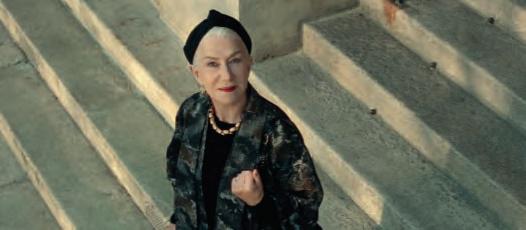
SEPTEMBER 1
“The Equalizer 3” brings Denzel Washington back as Robert McCall with Antoine Fuqua again directing and Richard Wenk writing the script. There will be blood, action and drama, but the team of Fuqua and Washington is unstoppable.
And lest we forget, there will be television, lots of it. The broadcast networks still use the end of September to launch their new series, and we can expect more yet-to-be-announced new series to hit most of the streaming platforms during that window as well. As of press time, only two streaming series have been announced for summer launches, “Barracuda Queens,” a new Netflix international crime series from Sweden, beginning on June 8 and “The Afterparty,” a comedy-mystery, on July 12 from Apple TV+.
Happy viewing!
session. Though, the entire collagen regeneration process can take up to 12 weeks, and patients will continue to see improvements over the course of the next three months following the treatment.
As for stubborn fat, Dr. Shamban says nothing compares to the Ultimate Contour, the only low-frequency, ultrasound device approved by the FDA that is painless, safe and provides immediate results.
“Ultimate Contour is the ultimate safe fat-removal device. And it works by a different kind of technology than we’ve had before,” said Dr. Shamban. “It works by a special type of focused ultrasound, which creates turbulence in the fat cells. It literally pops open and destroys fat cells more effectively than any other thing that we have right now. Ultimate Contour uses sound waves, which sounds incredible, but it works more completely. So even after one treatment, you see really phenomenal results.”
It’s also a relatively quick procedure with treatment time lasting an average of 10 to 45 minutes, depending on the size of the target area.
The speedy metamorphosis is due, in part, to the device’s two handpieces; one, the ultrasound handpiece used for fat reduction and the second, which emits radio frequency (RF) energy for stimulating collagen production. The dual technology allows you to treat several different issues in a single treatment area so you can reduce your waistline by 1 inch in a single treatment and smooth and tighten your skin. Though Dr. Shamban says the most requested target area is the abdomen, it can be used to great effect to slim arms, thighs, calves, saddlebags and love handles.
And, depending on the patient, repeat treatments (to the same area) are usually unnecessary because the device actually destroys fat cells. “So, as long as you don’t go out and eat like three Big Macs and a bag of Doritos every day, you can maintain it. For all of the people who have a little resistant fat, this is their get-out-of-jail-free card,” she said.
“We don’t want to make anybody feel bad, so when I say ‘fat’ I am talking about fat cells. We used to call it ‘fat removal,’ but now we call it ‘body contouring,’ so that’s the umbrella term,” Dr. Shamban explained. “And body contouring can be done at different levels. You can tighten up the muscle, which devices like EmSculpt accomplish. It works by stimulating your muscles, so you get maximum muscle contraction and tightening. We have the device here, and I love it. We all hop on it whenever we can. That’s technically ‘body contouring,’ but the next level is fat removal, and there are different ways to remove fat—you can have liposuction, or you can freeze the fat, which is called cryolipolysis, and CoolSculpting is the brand name for that method. But now you can completely destroy the fat in a completely different way like with Ultimate Contour. CoolSculpting can take a long time, and sometimes not all the fat cells are destroyed by the cold. Ultimate Contour is a much more complete destruction, which is why I think it’s the best in its class.”
But when it comes to a treatment that gives you the biggest bang for your buck, Dr. Shamban says there isn’t one singular treatment that fits everyone. “It’s just so individual,” she said. “A treatment program has to be based on your facial structures, skin type and skin changes. So, it would be nice if I could offer some kind of magic wand treatment, but we don’t have it yet.”
There are so many advancements in beauty technology being introduced all the time that many turn to social media to keep up. But for Dr. Shamban, this isn’t a bad thing; in fact, it’s quite the opposite. “Social media has made all of these procedures acceptable,” she said. “And now, people can talk about them openly like you would about getting your hair curled or highlighted or your teeth done. All of these procedures are in that realm now, which is very cool. The truth is that most people do these procedures, not for other people, but for themselves so that when they look in the mirror, they feel better. And that’s backed up by research. It’s something called the facial feedback hypothesis, which is when you look at yourself, and you look good, you feel better. It’s just hardwired into our brain.”
Dr. Harold Lancer is a world-renowned, board-certified

dermatologist with a long list of A-list clients, including Beyoncé, Margot Robbie, Kim Kardashian, Jennifer Lopez and Ryan Seacrest (who co-founded the men’s skin-care line, Polished, with Dr. Lancer in 2017).
The Lancer Dermatology clinic on Rodeo Drive is practically a Beverly Hills landmark. And though Dr. Lancer has built his decades-long career largely on his “from practice-to-product” concept with his ever-evolving skincare line, his dermatology clinic offers more than two dozen cutting-edge tech devices designed for a multitude of highly individualized treatments.
According to Dr. Lancer, the majority of his Beverly Hills clients seek him out because they’re unhappy with their uneven skin tone. “The number one concern [for patients] is always uniformity with complexion—consistent color. Blotchy color correction is key,” he said. “Lifting non-surgically is concern number two. Scar visibility reduction is number three.”
And “subtle” is the word most often used by his patients. “Subtle is the key to today’s consultation and procedural plan. The days of obvious alteration are over because the public is generally returning to a simplistic approach to skin appearance maintenance,” Dr. Lancer said.
For him, tackling any problem areas starts first and foremost with skincare. “A high-quality, full-body, therapeutic skin care program for home use is always number one because if skincare is done properly, the results of any minimally invasive procedure will be significantly better,” he said.
In terms of the latest devices, his approach is always multipronged, preferring to use what he calls composite treatments. “Composite is a group of instruments simultaneously used in a single visit. It’s a big mistake to visit a facility with only one or two machines. Multifunctional clinical work is needed,” he said.
Typically, this means Dr. Lancer will employ three or four different multidimensional, energy-based devices in a single treatment session. “This generally includes lasers, high intensity focused ultrasound, electromagnetic current, fractioned variable radio frequency heating—all during one visit to create skin self-restoration,” he said.
For the specific issue of uneven skin, he prefers the Picoway Resolve, a dual wavelength laser that targets excess pigment on the face and body, whether it’s naturally occurring in the form of hyperpigmentation or melasma, or from black and green ink tattoos. It’s an ultra-fast laser that transmits energy into the skin’s tissue, triggering the body’s own natural healing process, something that aligns with Dr. Lancer’s extensive research into the benefits of inflammation on the anti-aging process. Available exclusively in Beverly Hills at Lancer Dermatology, this powerful laser is suitable for all skin types and requires little downtime, with full healing achieved in five to seven days.
To achieve lift without surgery, Dr. Lancer utilizes Accent Prime, a device that offers a combination of proprietary ultrasound and radio frequency technologies, allowing practitioners to selectively target fat cells, while the RF enables focused treatment at multiple tissue depths

for a customized treatment. “Lifting of tissue without surgical cutting is highly demanded because of surgical failures,” he said. “[Accent Prime] increases the bounce and elasticity of tissue so that tissue is visually and physically lifted without removing skin. This is generally best for individuals in their 30s to 50s who have been well-maintained and want further maintenance without surgical invasion. Depending on the composite procedures, downtime can be one or two days [and up to] seven to 10 days, and it can cost anywhere from $1,500 to $6,500,” he said.
Also, among his devices is the Opus Plasma from Alma. It has a variety of interchangeable tips that are super-charged with highfrequency, unipolar, radiofrequency energy. This energy reacts to atmospheric pressure in the air to create plasma that, in turn, creates
microthermal zones, which deliver fractional injuries to target areas, provoking the skin’s natural regenerative cycle. Plasma intensity can be adjusted based on the patient’s desired outcome to light, moderate or aggressive resurfacing, and the results are the same as the most aggressive CO2 lasers with a significant reduction in downtime and discomfort during the treatment, which takes about 10 to 15 minutes. Afterward, stretch marks, and deep and fine lines will significantly be reduced, skin tone and texture improved, and elasticity restored after just one treatment (with optimal results after a completed series of two to three).
While we all feel the pressure to maintain a youthful appearance, made worse by the proliferation of highly altered images shared on social media platforms, Dr. Lancer says his patients have a more realistic response. “[Social media] has had a huge impact on the entire landscape as self-perception has changed. Even if someone is not privy to social media surveillance, someone around them who is privy will usually be an influence. The patients that come [into my clinic] already recognize that things online are often filtered and unrealistic. They come to me to get a healthy appearance without the magic of filtration,” he said.
Unfortunately, even the best results won’t last forever, says Dr. Lancer. “In appearance maintenance, ‘one and done’ does not exist,” he said. “Maintenance is always required, either three to four months, six months, or one year down the line.”
Dr. Madhuri Chadha, known as Dr. Madh to clients at her popular Beverly Hills practice, is also a firm believer in combination therapies. “I think that when you combine resurfacing with collagen-stimulating treatments, you’re getting the best of everything. My absolute favorite is radiofrequency microneedling. And to be specific, a device called Secret RF,” she shared. “It’s unlike anything else out there.”

What sets it apart, according to Dr. Madh, is the device’s ability to deliver thermal heat at a consistent temperature directly to target areas. “RF microneedling relies on thermal heat at a very specific temperature in order to stimulate fibroblasts (the cells that produce collagen), and some devices may say that they are delivering it at a certain level, but it’s not by the time it gets to the tissue. And this device is very true to what it says. Also, the needle head size is much bigger. It’s a 64-pin versus the average 25-pin, so you’re more than doubling the delivery of heat and targeted wound injury to the skin. I’m very fond of this device, and I consistently see really nice results with it.”
Secret RF works on all skin types and colors to improve dermal elasticity and helps with fine lines, wrinkles, pigmentation, traumatic and surgical scarring, and deep acne scarring as well. Often, Dr. Madh will use the device with a CO2 laser for a holistic approach to more youthful skin. “By using both devices, you’re not only stimulating the deep tissue and addressing crepiness with RF, but you’re also resurfacing the skin with the CO2,” she said.
Downtime is limited; any post-treatment redness subsides in about 24 hours (the neck can take up to 72 hours). “If you do it on a Friday, you’re ready to go by Monday. And oftentimes, patients will even go out that same night. It really depends on the intensity of your treatment and the skin tone of the patient,” she said. “Older microneedling methods created a targeted wound injury with no thermal heat. And afterward, you were left looking like you got in a fight with a cat, with a lot of bloody redness and scratches. With thermal heat, the blood coagulates, and so it’s very clean. If there’s any bleeding, it’s coagulated, so no one walks out looking bloody. Oftentimes, patients walk out with a glow.”
It can take up to 12 weeks to see improvements with final results topping out around five months, and Dr. Madh recommends a series of three treatments anywhere from four to six weeks apart. After the last, you can maintain results with a repeat treatment every six months. “The more consistent you are, the better your result is going to be,” she said. “If you liken it to your fitness routine, you don’t just join the gym and workout for a month and say you’re done for the rest of your life, right? It’s all getting started and maintaining those results.”
The Secret RF treatment starts at around $1,200 and goes up to $1,800 per session, depending on the area. But for Dr. Madh, it really is the best bang for your buck. “When talking about reversing the signs of aging, hands down, it’s radiofrequency microneedling,” she offered. “Because it is multitasking, it’s going to help with texture, tone and pigmentation, and it’s going to stimulate collagen and improve dermal elasticity. And the results are long-term because you’re using your own body to stimulate collagen. But there’s one thing to remember,” she cautions. “We’re not stopping the clock; we’re slowing it down.”
Shawna Jones began her career in orthopedic spine surgery before making the move to dermatology and medical aesthetics eight years ago. She’s also a top trainer for Allergan Aesthetics, the maker of the holy grail injectable Botox, instructing aestheticians across the country in the latest advancements. Operating out of the SkinSpirit clinic’s two locations—Newport Beach and Beverly Hills—she’s in high demand for her expertise in the latest technological advancements.
According to Jones, she’s seeing a movement toward natural results achieved by injectables used in conjunction with lasers and other collagen induction therapies. “We go to Botox for preventative reasons, for help with those dynamic lines that we make with movement, and there’s a place for that. And then, there’s a place for improving overall skin quality, which is where the [devices] come into play,” she said.
One of the most requested treatments at the Beverly Hills location is the Morpheus 8, a state-of-the-art device that utilizes both RF technology and microneedling. “It’s minimally invasive unlike traditional microneedling, where a tiny pin is glided across the skin to create micro channels. [Morpheus 8] uses sound waves to create these channels, which in turn boosts collagen and elastin during the body’s healing cascade [the stages in which the body repairs itself],” she explained.
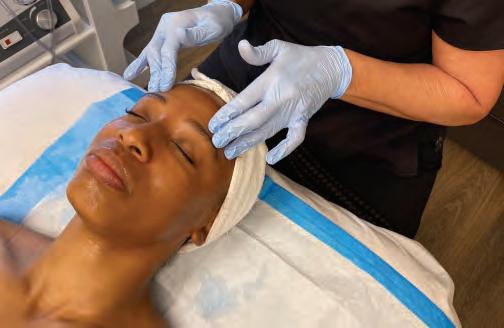
“The best part is that it’s completely customizable so the device can be tailored for each patient, and you can actually recontour the face and remold the fat and underlying skin structures if needed.”
The Morpheus 8 can be adjusted to target different depths so a facial map can be created allowing for specific areas to be tightened more, or less, and the heat delivered by the radio frequencies can break down fat deposits allowing for the fat to be repositioned. Jones says she’s seen it work wonders for acne scarring as well. The device can be used on the face and neck, on the body, the abdomen specifically, or crepey skin on the upper arms or back of the thighs. Thanks to its twin handpieces—one for the face and one for the body—it can be used effectively anywhere.
The procedure takes about 30 minutes to an hour, depending on the size of the area being treated, and it begins with numbing the site to assuage any discomfort, and that can be done either topically or with Pro-Nox, an FDA-cleared medical nitrous oxide machine. “For a lot of people, what they most want to know is if it’s going to be painful or if it will hurt, and we want it to be a pleasant experience. So that helps tremendously,” said Jones of the fast-acting, pain-dulling nitrous.
Downtime for most patients is between five and six days. Immediately after the treatment, you will experience a little redness like a sunburn and some swelling, which will subside in about 72 hours. And you’ll feel micro scabs on the site over the course of the next couple of weeks. They won’t be visible and will flake off on their own. Jones stresses not to exfoliate or manually remove these scabs. “We tell patients to just leave those scabs alone. I also tell them not to do any heavy exercises, anything where you would be sweating, which attracts bacteria because we want to prevent any infection and to avoid wearing makeup for at least a week,” she said. “You could go out in public, but you wouldn’t want to have any big events scheduled for a minimum of a week post-treatment, but I usually tell people to aim for a couple of weeks.”
Because the Morpheus 8 works by stimulating collagen production, results aren’t instant. Changes develop over the course of three months, on average. And Jones recommends a series of three treatments, done at four or six-week intervals. A single facial area starts at $600 (full face is $1,200); body pricing begins at $750 per area; and full face, neck and chest costs $1,850. All treatments include Pro-Nox (nitrous oxide for pain management/numbing) and a medical-grade Sente Daily Repair Essentials kit for post-treatment, at-home recovery.
“Once you’ve done the series of three, you need to protect your investment,” she said. “I highly recommend continuing with medical-grade skin care at home and keeping up with sunscreen, which you should be doing anyway. Skin is such a major part of how we perceive ourselves, and dermatologists and aestheticians can give so much confidence and make people feel so much better about themselves by helping improve even little things to make people feel a little bit younger.”
1. Move over itsy-bitsy, yellow polka dot bikini, this sunny, pineapple print onepiece bathing suit from Eres is just as playful but decidedly more grown up. $496 at Eres, 9566 Dayton Way, 310-2461008 and eresparis.com
2. Raise a glass to this stunning David Yurman cocktail ring. With a pale pink morganite gemstone at its center surrounded by circling 18-karat rose gold ribbons studded with pave diamonds, it looks like a bottle of Rosé chilling in a bucket of ice. $6,900 at David Yurman, 371 N. Rodeo Drive, 310-888-8618 and davidyurman.com
3. The cotton candy pink shade of Balmain’s “Sponge” shoulder bag calls to mind the spun sugar treats served up at county fairs and amusement parks, and it’s made out of the season’s most quintessential fabric—terry cloth. What says “summertime” more than that? $1,500 at Balmain, 8421 Melrose Place, West Hollywood, 323-230-6364 and us.balmain.com
4. A cooler is an indispensable summer accessory and this “Tagalong” cube by Igloo, available at Nordstrom, will become your go-to for beach days and long car trips. It comes in five different taffy-like colors such as turquoise, orange, pink and yellow. $59 at Nordstrom, 10250 Santa Monica Blvd., 424-207-1177 and nordstrom.com




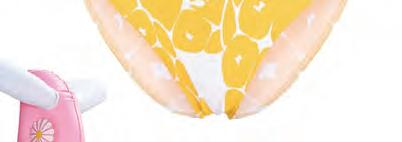

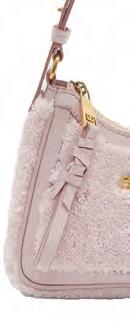

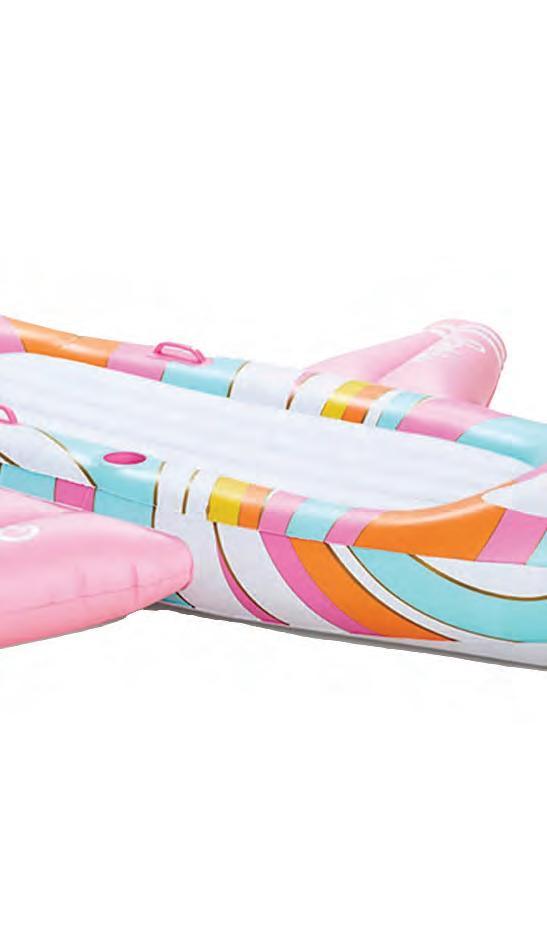
5. With a highly anticipated live-action film based on the beloved doll coming out this summer, it certainly feels like it’s a Barbie world right now. Hop on Funboy’s Pucci-esque Barbie private jet pool float from Neiman Marcus and take the next non-stop flight to relaxation. $99 at Neiman Marcus, 9700 Wilshire Blvd., 310-550-5900 and neimanmarcus.com
6. Elevate a pair of faded jeans or white ankle-cropped capris with these Fendi slides. Their tufts of bubblegum-pink mink fur and sculptural block heels will add drama to any ensemble. (If pink isn’t your thing, they are also available in denim blue.) $1,490 at Fendi, 201 N. Rodeo Drive, 310-623-3420 and fendi.com
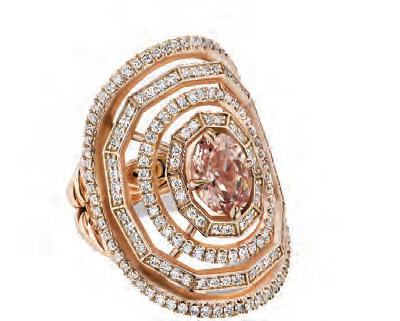
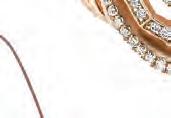
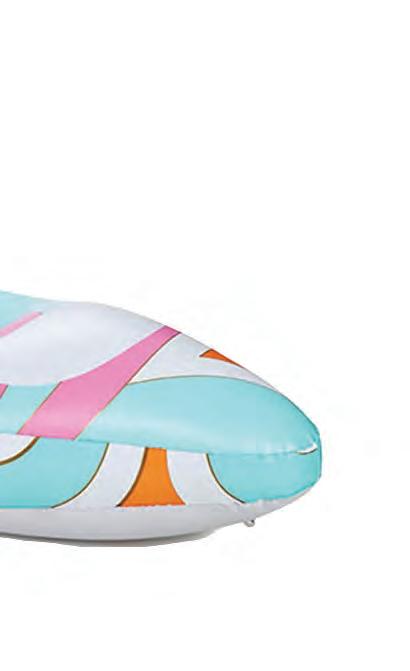


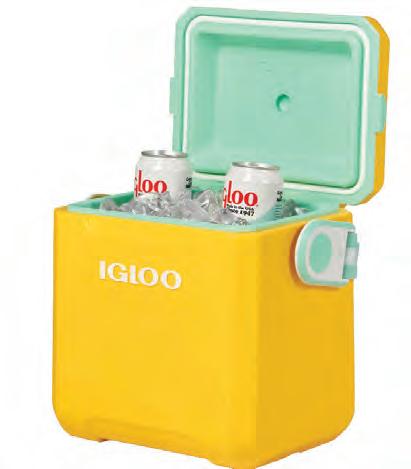
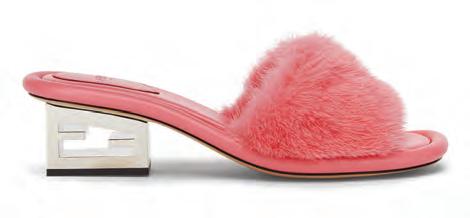

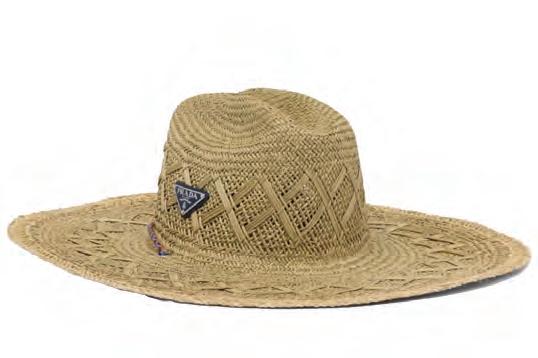
1. When it comes to sun protection, you can’t go wrong in a classic wide-brim straw hat by Prada. The beauty is in its simplicity—it’s artfully woven and decorated only with the brand’s understated triangle logo. $1,100 at Prada, 343 N. Rodeo Drive, 310-278-8661 and prada.com

2. Channel your inner action star in these Tom Ford “Bronson” sunglasses, named after the inimitable Charles Bronson, who dazzled audiences in the ‘70s with his tough guy persona and effortlessly cool style. $555 at Tom Ford, 346 N. Rodeo Drive, 310-270-9440 and tomford.com
3. This gauzy, eco cashmere, crewneck men’s sweater by Amiri is made right here in Los Angeles Its cascading shades of aquamarine give the effect of rolling waves crashing against the shore. $1,190 at Amiri, 461 N. Rodeo Drive, 310-878-2996 and amiri.com
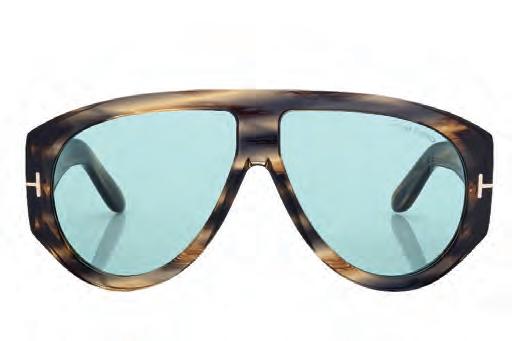

4. Stuff this easily packable Longchamp “Le Pliage Filet” knit bag from Nordstrom in your suitcase, and you’ll have the perfect beach tote on hand for transporting towels and sunscreen on your next tropical vacation. $110 at Nordstrom, 10250 Santa Monica Blvd., 424-207-1177 and nordstrom.com
5. Part Birkenstock, part pool slide—all comfort, these surprisingly lightweight, arch-supporting, lambskin “Dioract” sandals by Dior are perfect for strolling along the water’s edge or roaming the city streets of some far-flung destination. $1,050 at Dior, 309 N. Rodeo Drive, 310859-4700 and dior.com

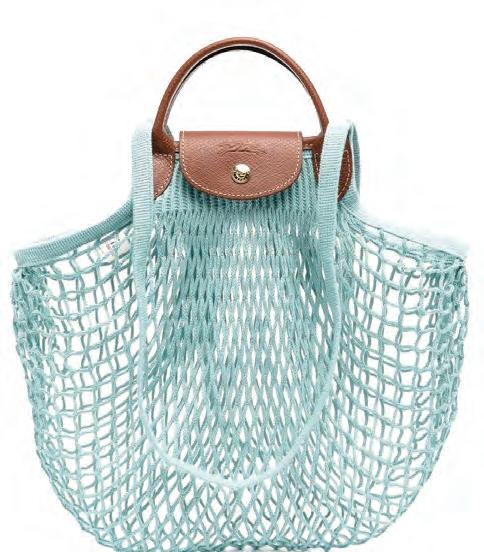
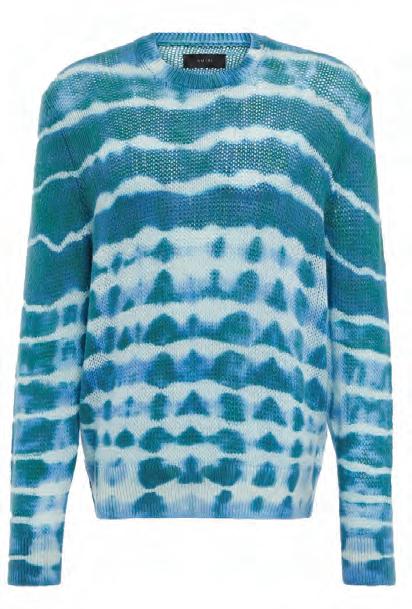
6. Inspired by minimalist Japanese design and hand-crafted from teak, these “Porto” solar lanterns from RH offer a dramatic play of light and shadow—all powered by the sun. $335 each at RH, 8564 Melrose Ave., West Hollywood, 310652-0323 and rh.com


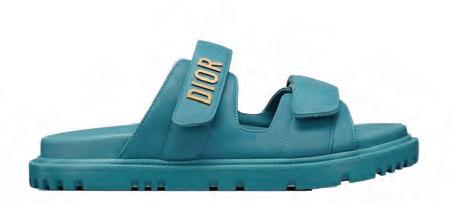
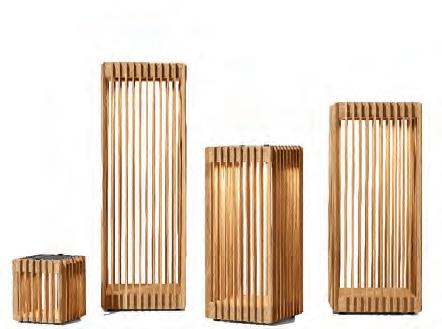
1. Made from natural raffia woven into a simple box pattern, the “Cassette” crossbody bag by Bottega Veneta is neutral enough to pair with your boldest summer garb. $3,400 at Bottega Veneta, 320 N. Rodeo Drive, 310-858-6533 and bottegaveneta.com
2. These flat-front Bermuda shorts by Loro Piana straddle the line between casual and leisure wear. The combo of silk and linen gives them a luxe look, but they’re so soft and comfy, you’ll want to sleep in them. $725 at Loro Piana, 360 N. Rodeo Drive, 310-860-0765 and us.loropiana. com
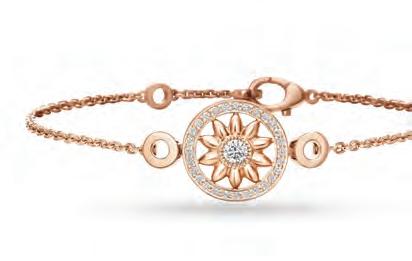
3. A garden trellis trompe l’oeil wraps this Giambattista Valli frock (available at Saks Fifth Avenue). Its effect is demure and sophisticated, yet appropriately flirty. $2,935 at Saks Fifth Avenue, 9600 Wilshire Blvd., 310-275-4211 and saksfifthavenue.com
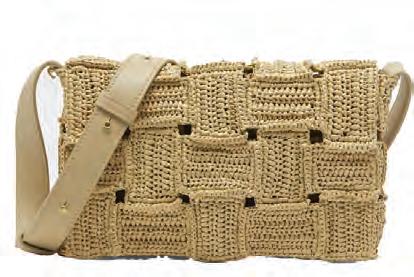








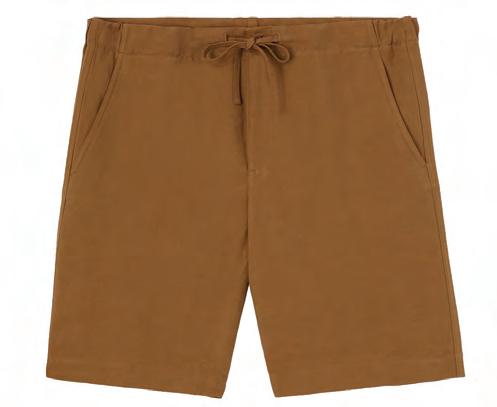

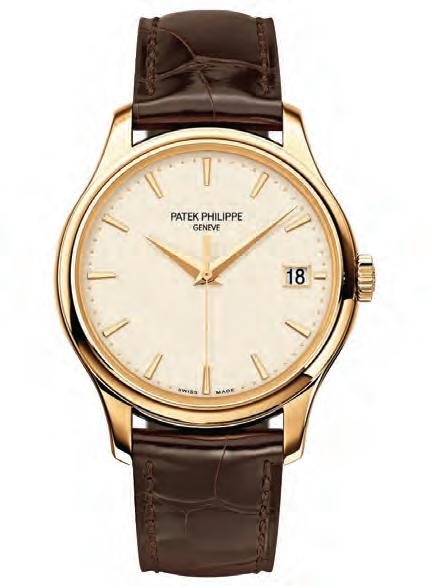


4. Proof that there is elegance in simplicity, the “Gates” bracelet by Harry Winston features a single 18-karat gold rosette surrounded by 29 round, brilliant-cut diamonds. To Winston, the symbol represented opportunity, new beginnings and good fortune. $5,100 at Harry Winston, 310 N. Rodeo Drive, 310271-8554 and harrywinston.com

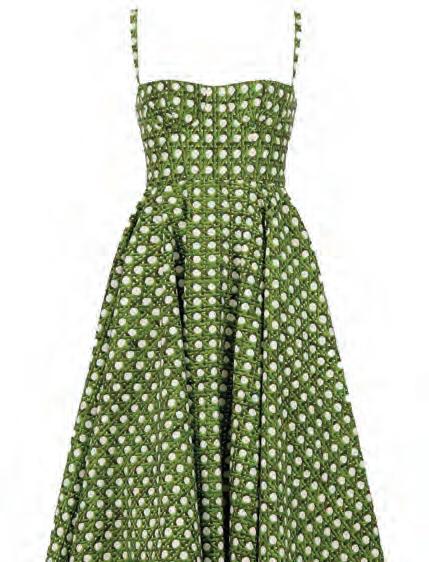

5. Smartwatches and fitness trackers have their uses, but neither offer what the “Calatrava” by Patek Philippe does— zero software upgrades. It’s the epitome of a classic wristwatch guaranteed to stand the test of time. $40,216 at Gearys Patek Philippe, 360 N. Rodeo Drive, #2, 310-887-4200 and gearys.com/ patek-philippe
6. If even the sturdiest of succulents put your gardening skills to the limit, the collection of incredibly realistic faux potted cacti at Pottery Barn will fool everyone. $299 at Pottery Barn, 300 N. Beverly Drive, 310-860-9506 and potterybarn.com
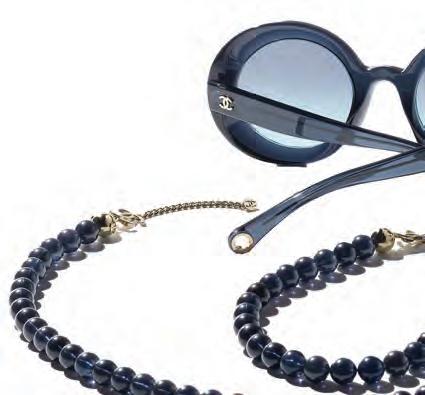

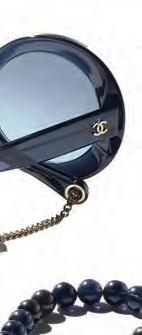

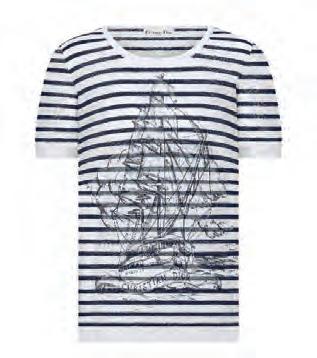

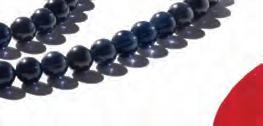

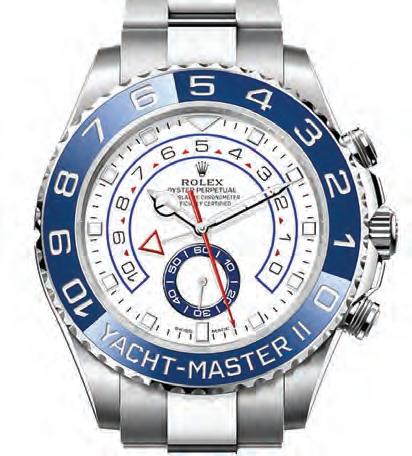

1. These round, navy blue, acetone shades from Chanel, with their matching gradient lenses and detachable beaded necklace, are so chic they would make Jackie O jealous. $1,375 at Chanel, 400 N. Rodeo Drive, 310-278-5500 and chanel. com
2. Crisp navy blue, horizontal stripes cross a field of white on this short-sleeved cashmere and silk sweater from Dior And an 18th-century seafaring vessel decorates the front, just to send the nautical theme sailing home. $1,250 at Dior, 309 N. Rodeo Drive, 310-859-4700 and dior.com






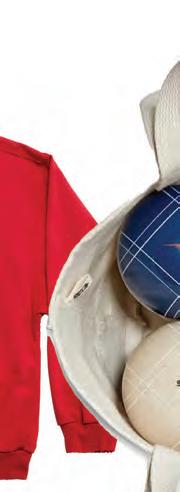

3. Renowned Japanese artist Yayoi Kusama is back for a second collaboration with Louis Vuitton. Her trademark Infinity Dots are reinterpreted in this cheerful tomato red and bright white top-handled clutch. $3,400 at Louis Vuitton, 295 N. Rodeo Drive, 310-859-0457 and louisvuitton.com
4. The “Yacht-Master II” from Rolex is the king of nautical watches. Launched in 1992 for navigators and skippers, the regatta chronograph celebrates sailing’s rich history. $18,700 at Gearys Rolex, 360 N. Rodeo Drive, #1, 310-887-4200 gearys. com/rolex
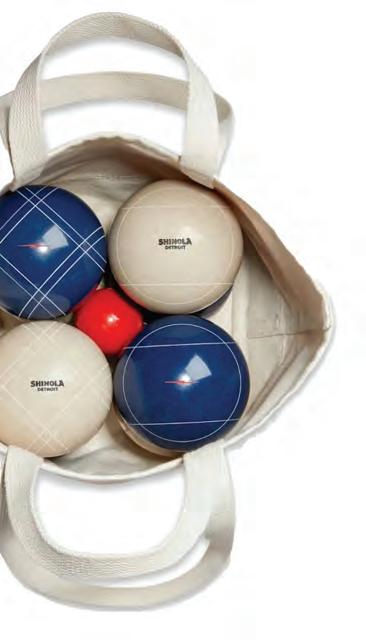
5 Whenthesunsuddenlydisappears
5. When the sun suddenly disappears behind a band of rogue clouds and the temperature plummets, women can opt for a poncho or a shawl, but for gents, it’s one of those times when having a hoodie on hand is a lifesaver. This bright red version from Balenciaga is not only functional, but it’s also high fashion. $1,290 at Balenciaga, 338 N. Rodeo Drive, 310-854-0557 and balenciaga.com
6. What summer barbecue or lawn party is complete without a game of bocce ball? This set from Shinola, available at Gearys, comes with its own rubber-bottomed canvas tote so you can bring the fun with you. $295 at Gearys, 351 N. Beverly Drive, 310-273-4741 and gearys. com
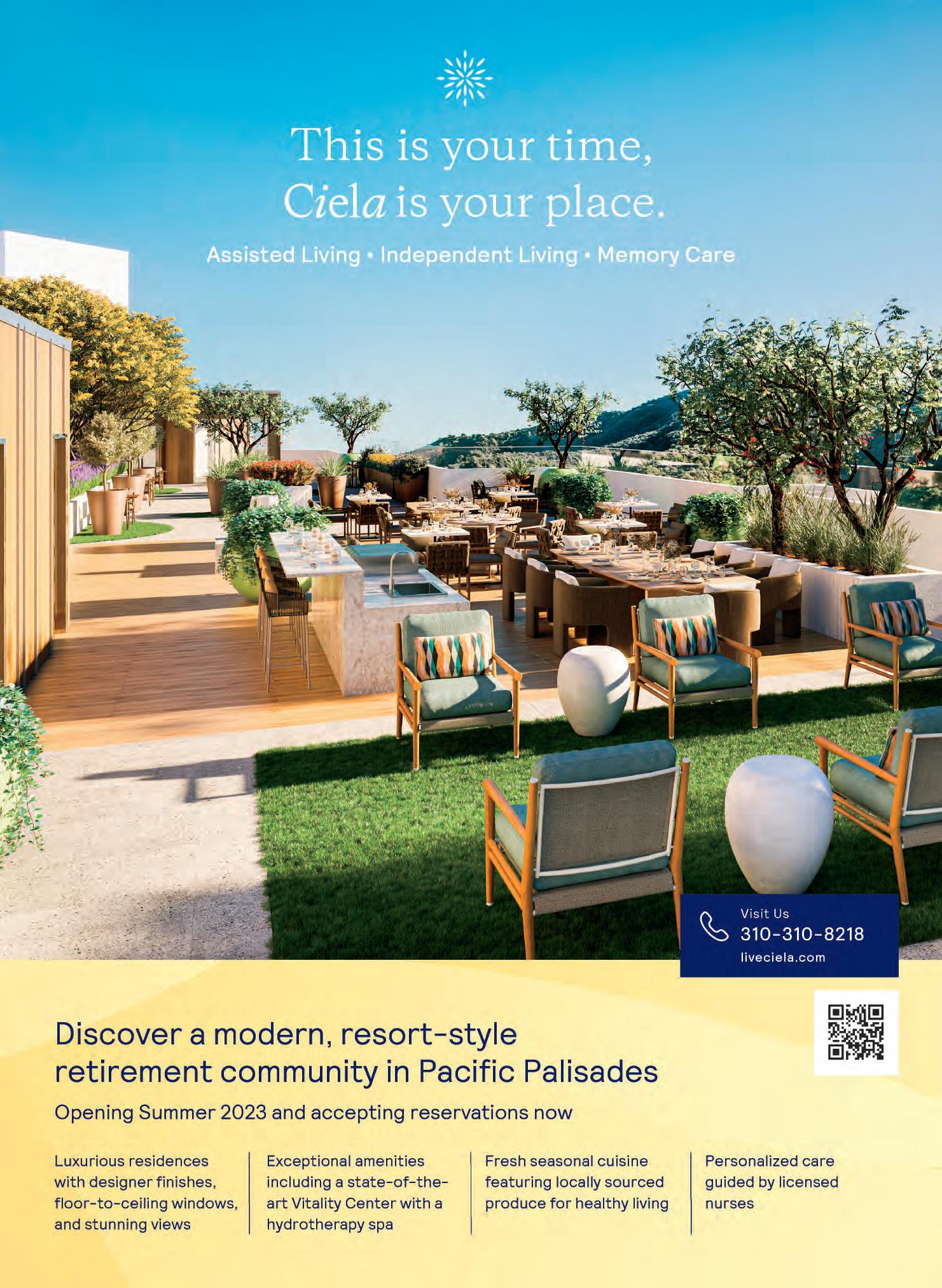
1. With bright and bold blooms in hues that evoke the sky just before twilight, these jersey-knit pants from Etro are an upscale alternative to yoga pants, but just as comfy on long flights. $690 at Etro, 9501 Wilshire Blvd., 310-248-2855 and etro.com
2. Fans of HBO’s hit series “The White Lotus” couldn’t get enough of season two’s Portia (played by Haley Lu Richardson), particularly the character’s quirky (and divisive) fashion sense. We think this silk scarf hat with its Nappa visor by Fendi is the posh vibe she was going for in the look that won over social media. $650 at Fendi, 201 N. Rodeo Drive, 310-623-3420 and fendi.com
3. The hefty weight of the “Maxi Iconica” ring by Pomellato is impressive. But its bevy of baubles—pink tourmaline, orange sapphires, blue sapphires, tsavorite, red spinel, tanzanite and amethyst—is downright dizzying. $7,800 at Saks Fifth Avenue, 9600 Wilshire Blvd., 310-275-4211 and saksfifthavenue.com
4. Add a pair of these colorful, metallic leather slides from Valentino and like magic, you’ll transform your outfit from dull to dazzling. $1,150 at Valentino, 324 N. Rodeo Drive, 310-247-0103 and valentino.com
5. Known for its sumptuous “silk calfskin” leather goods, Loewe elevates the lowly wallet with a buttery trifold in swimming pool blue. $650 at Loewe, 327 N. Rodeo Drive, 310-388-6771 and loewe.com
d loewe.com
